Morocco has some well-known cities like Marrakesh and Casablanca because of the 1942 movie. (Which wasn’t filmed in Morocco at all.) But there are so many options when thinking about where to travel in Morocco. The country is full of culture, history, and more diversity than you might think.
For my first time in Morocco, I decided to take a group tour. I was looking forward to someone else doing the planning for a change, plus I wouldn’t have to worry about safety as a solo female traveler or struggling with the language. Plus, a group tour is perfect for anyone who isn’t sure where to travel in Morocco. I went with Intrepid Travel since I’d heard good things and the prices were very reasonable.
Note: I used Airalo eSIMs for cellular data. It was quick and easy to buy more data whenever I needed it so I could stay connected anywhere in Morocco. I highly recommend it!
Group Tour with Intrepid Travel
The tour I chose was the Northern Morocco Adventure. It was a 9-day tour and hit a lot of stops, so I knew it might be a bit fast-paced. But I had limited time and money and this was the second shortest tour that still covered a lot of different sites. You can see all the current Morocco tours here. If you can, I recommend taking one of the longer ones that includes the Sahara desert and Essaouira. Still, the 9-day trip was more than worth it.
My tour group was nine people, myself included, plus our tour guide. The group happened to be all women and included Australians, Irish, Canadians, a Jordanian, a German, and me. Most were traveling in pairs, except for me and two others. The group was together most of the time, but there were opportunities to branch off and do your own thing if you wanted.
What I like about Intrepid Travel is that they practice responsible travel. That includes using local tour guides, supporting local businesses, a foundation that benefits the areas where they tour, and more.
A little bit about Moroccan history and culture
There’s so much history and culture in Morocco, you can’t help but learn, even indirectly. The indigenous people of Morocco are called the Amazigh, or Berbers. The word “Berber” is offensive to many Moroccans today because it was used by Romans and other groups who came to Morocco as a pejorative term to describe them as uncivilized. The Amazigh people make up the majority of the population in Morocco, Algeria, Tunisia, and Mauritania.
The standardized Amazigh language is Morocco’s second official language after Arabic. But it actually draws on the three biggest Amazigh dialects, Tashelhit, Central Atlas Tamazight, and Tarifit. Some Moroccans also speak French due to French colonial influence, but it’s not an official language. Still, you’ll see signage in French and it can be helpful to know some basics.
Stop #1: Casablanca, Morocco’s Largest City
The trip meeting point was a hotel in Casablanca, the economic capital of Morocco. Before our evening orientation, I had a few free hours.
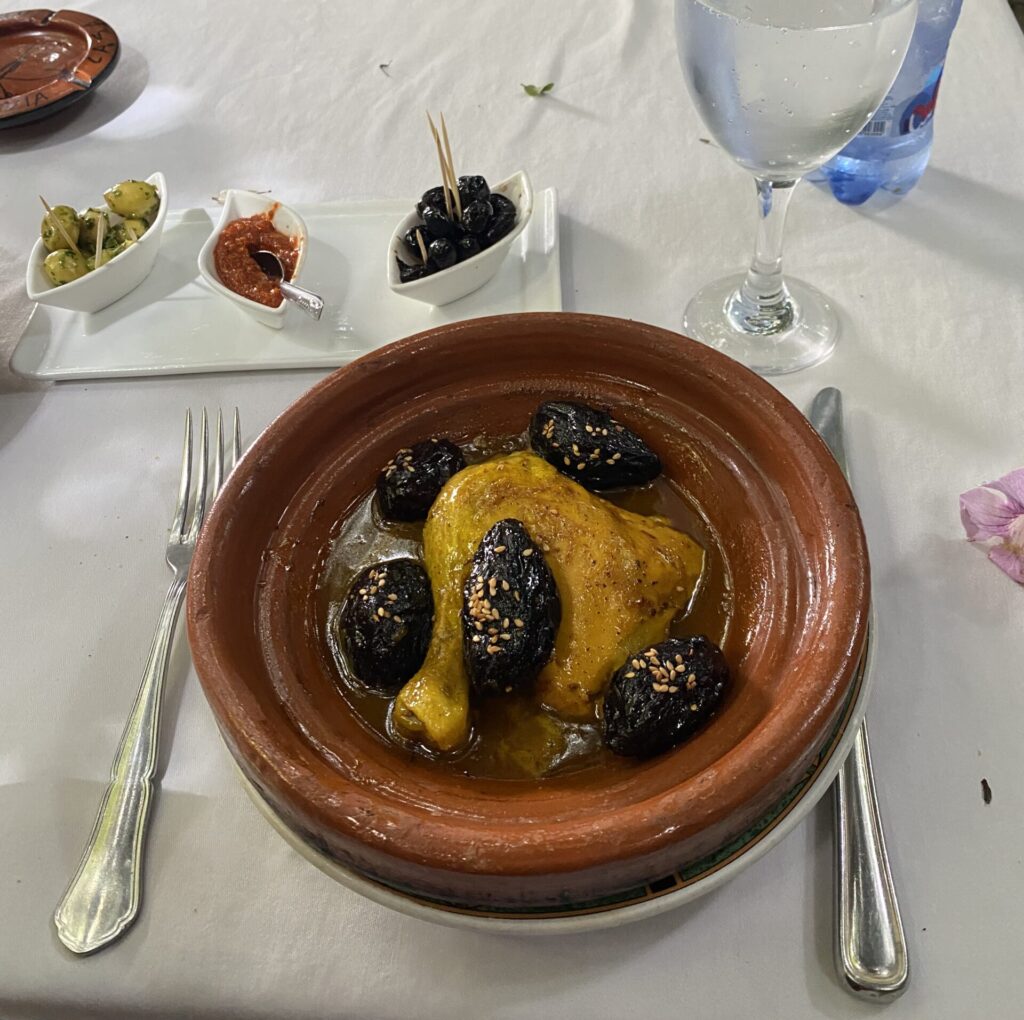
The first thing I did was eat at a restaurant called Al Mounia. Al Mounia serves some of the best traditional Moroccan food in the city, according to what I read online. I agree. I ordered chicken with dried prunes, a common dish in Morocco and one I can’t get enough of. The dried prunes add sweetness, the chicken is incredibly tender, and as you’d expect, the spices are perfect.
I don’t think Casablanca is the prettiest city, but there are some sights worth seeing. The top sight is Hassan II Mosque. This mosque is the only one in the city that non-Muslims can visit and it costs 130 dirhams, or about $12 USD to enter. The building and grounds are massive, able to fit up to 105,000 worshippers total. It sits on the coast overlooking the Atlantic Ocean and was built by artisans from all over the country, making it a great example of Moroccan architecture. It’s the second largest working mosque in Africa and seventh largest in the world.
Other popular spots are the Corniche, which is a walking and beach area along the ocean, the old medina, and the Quartier Habous.
Stop #2: Rabat, Morocco’s Modern Capital City
Next, we took a train to Rabat, Morocco’s modern capital city. Rabat seems more clean, quiet, and streamlined than other cities, with wide streets and long views. I only had a few hours, so I focused on seeing Hassan Tower and the medina. If you have more time and the energy, you can easily visit more sites one after the other. Everything mentioned here is either within walking distance or a short cab ride away.
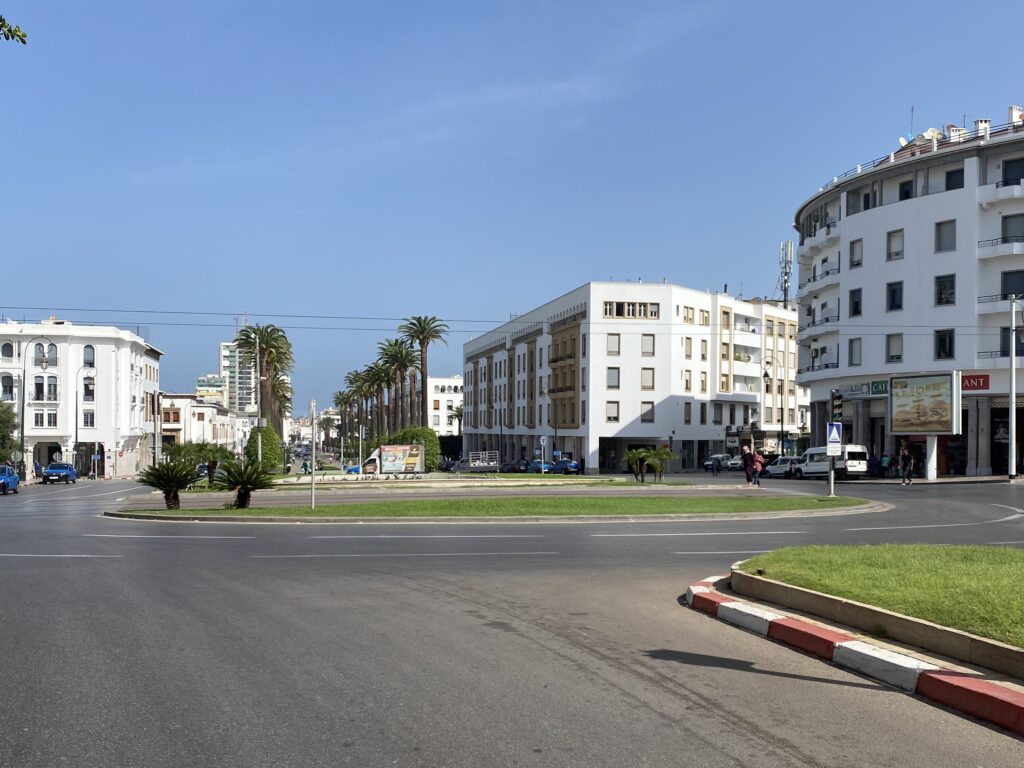
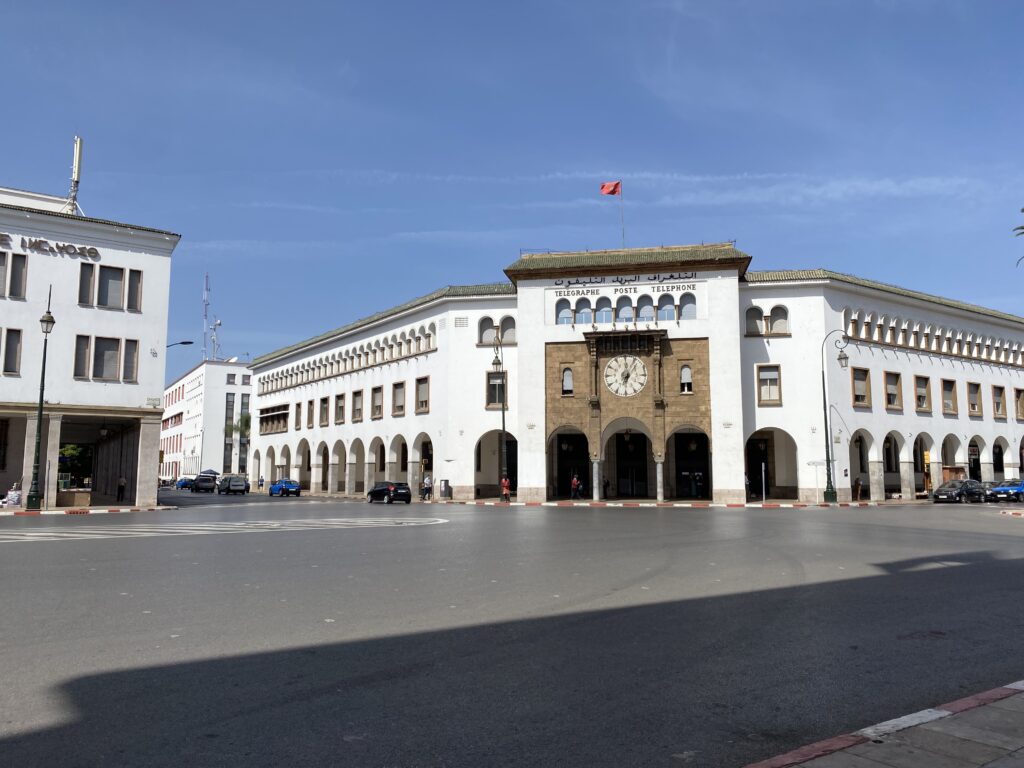
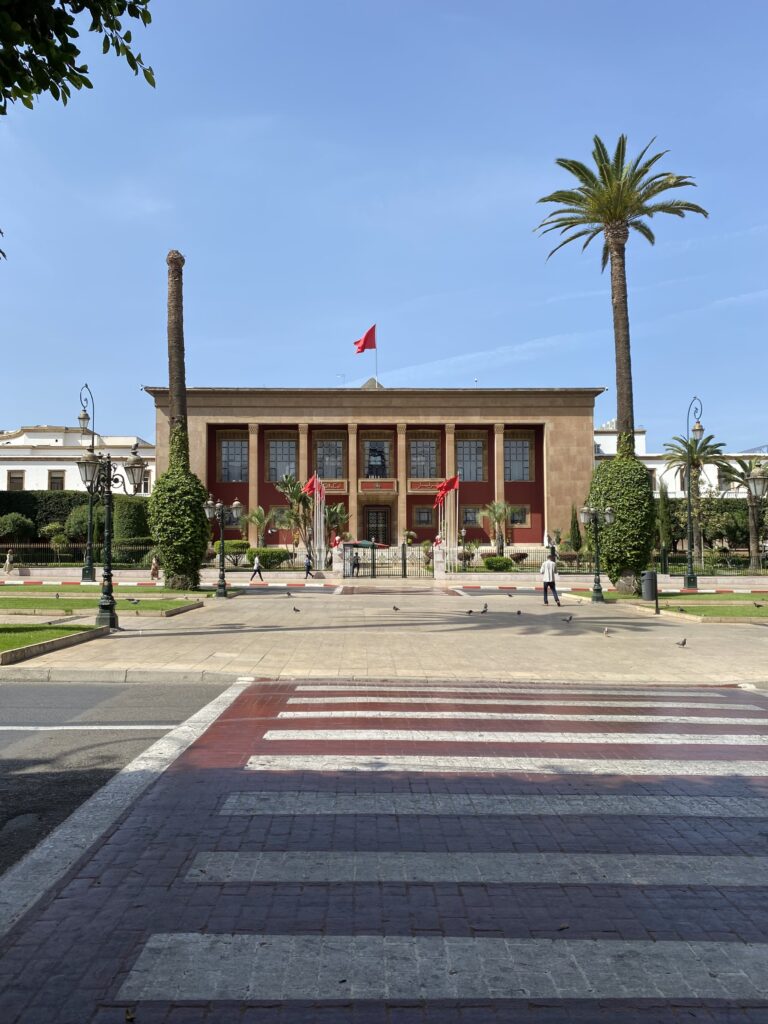
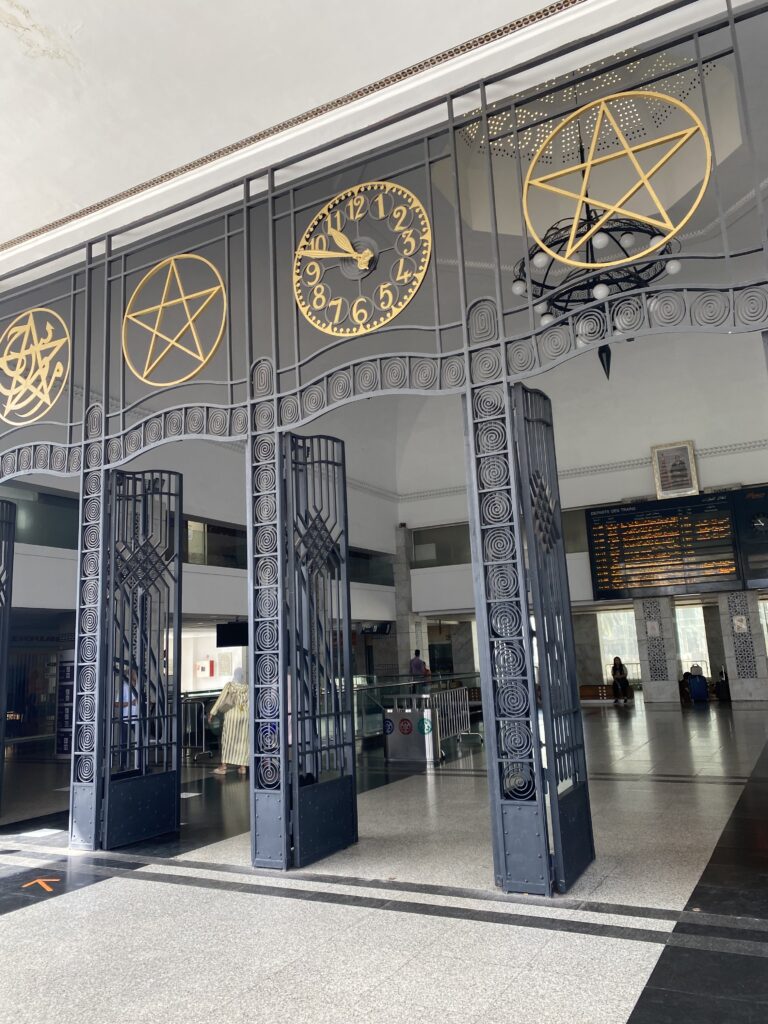
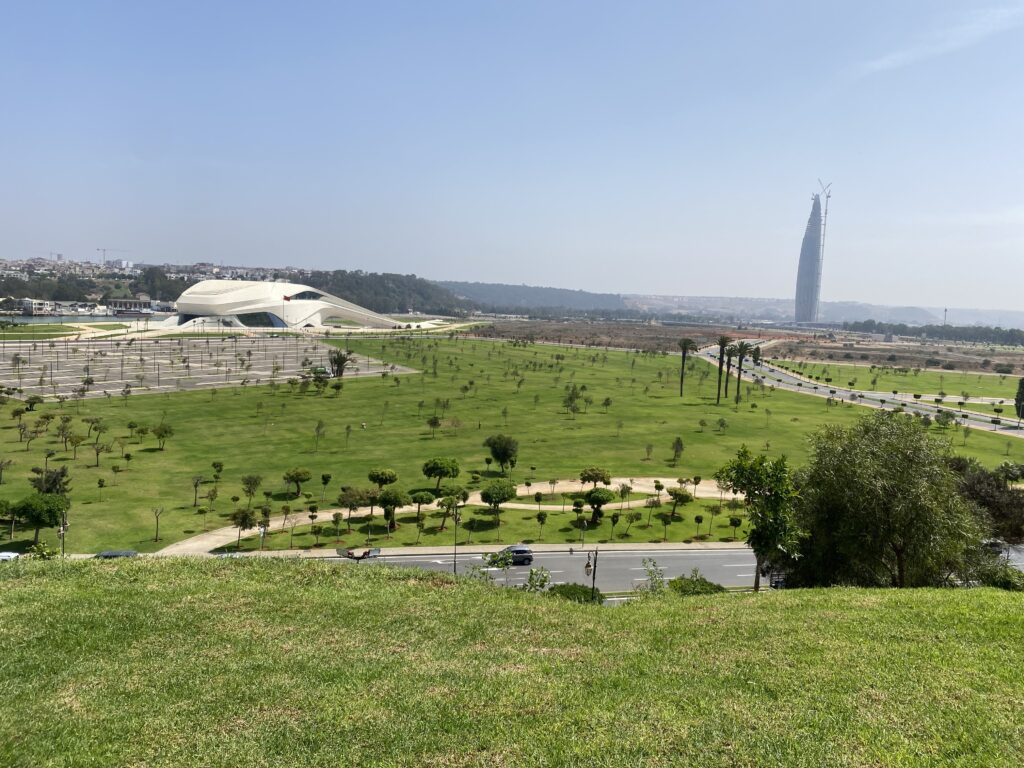
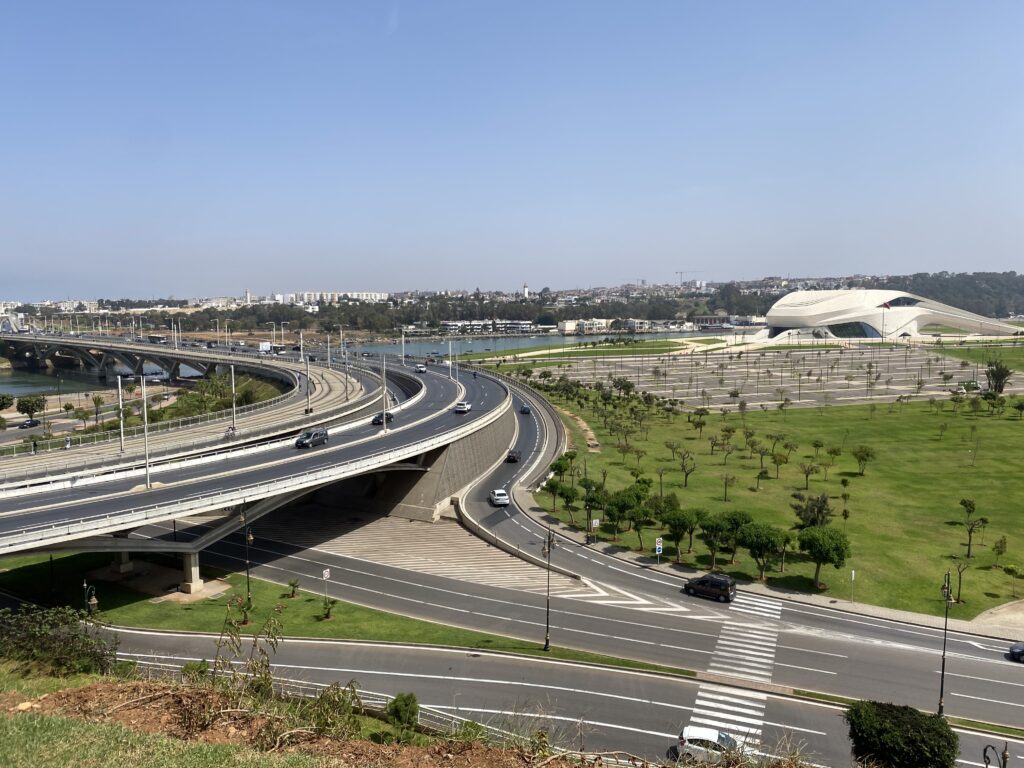
Hassan Tower and Mausoleum of Mohammad V
Hassan Tower is part of an unfinished mosque from the 12th century. The unfinished tower/minaret and mosque were meant to be the largest in the world, but construction stopped when the Caliph who commissioned it died. Guards on horseback sit outside the two entrances and welcome you to take photos of and with them.
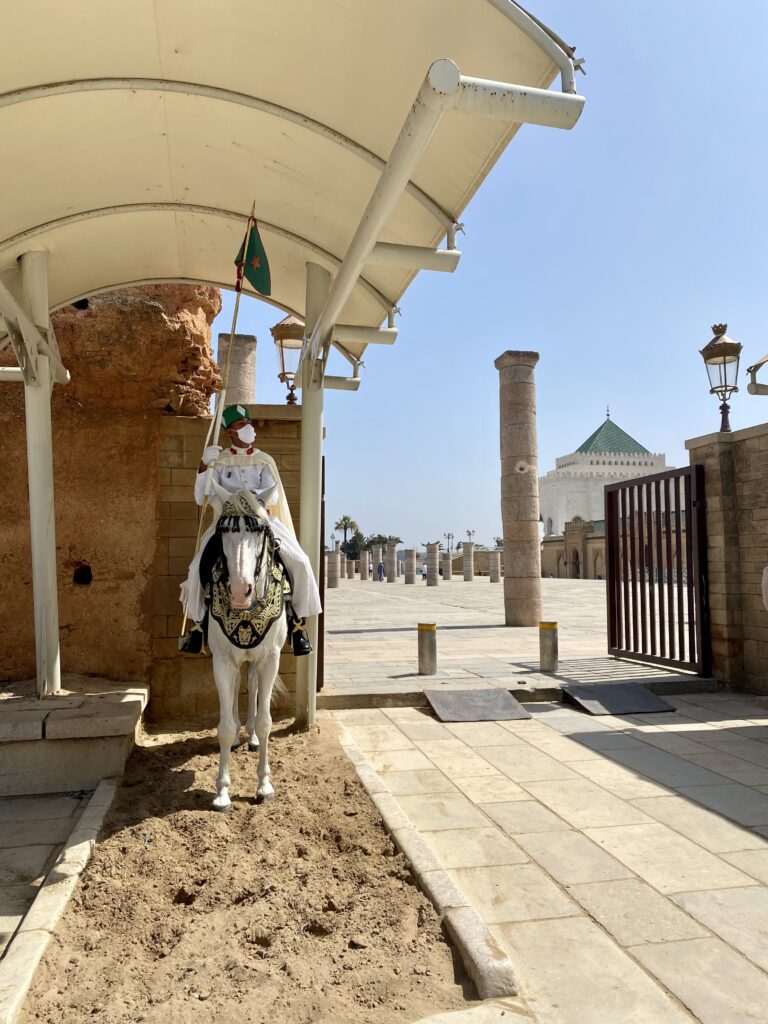
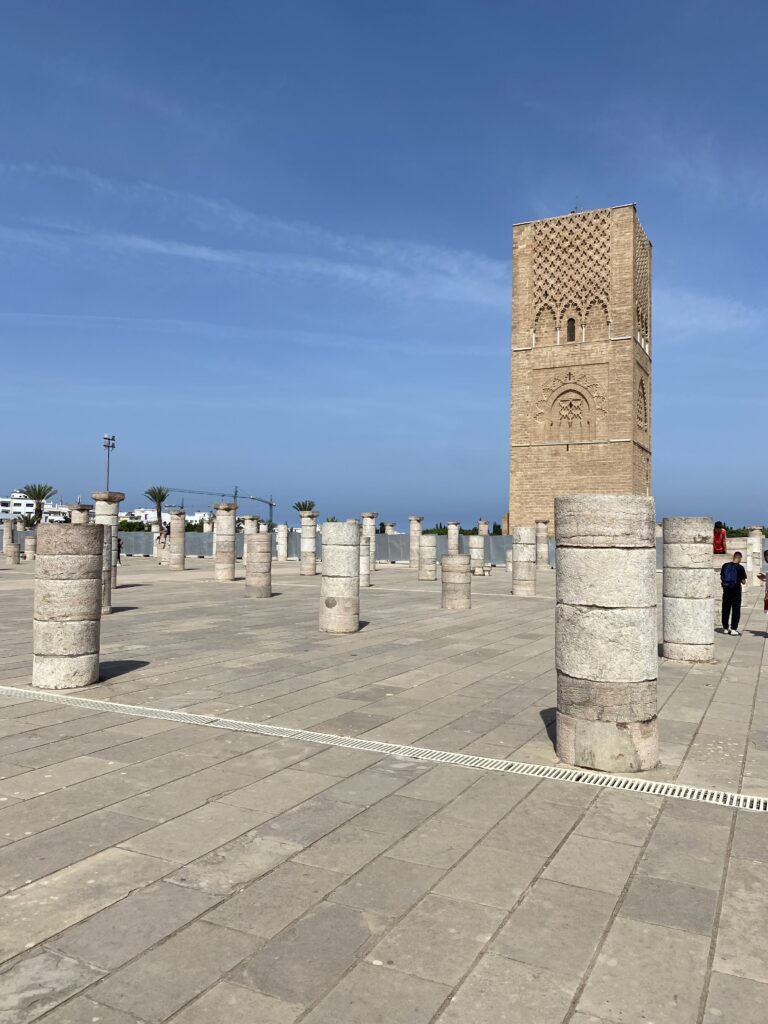

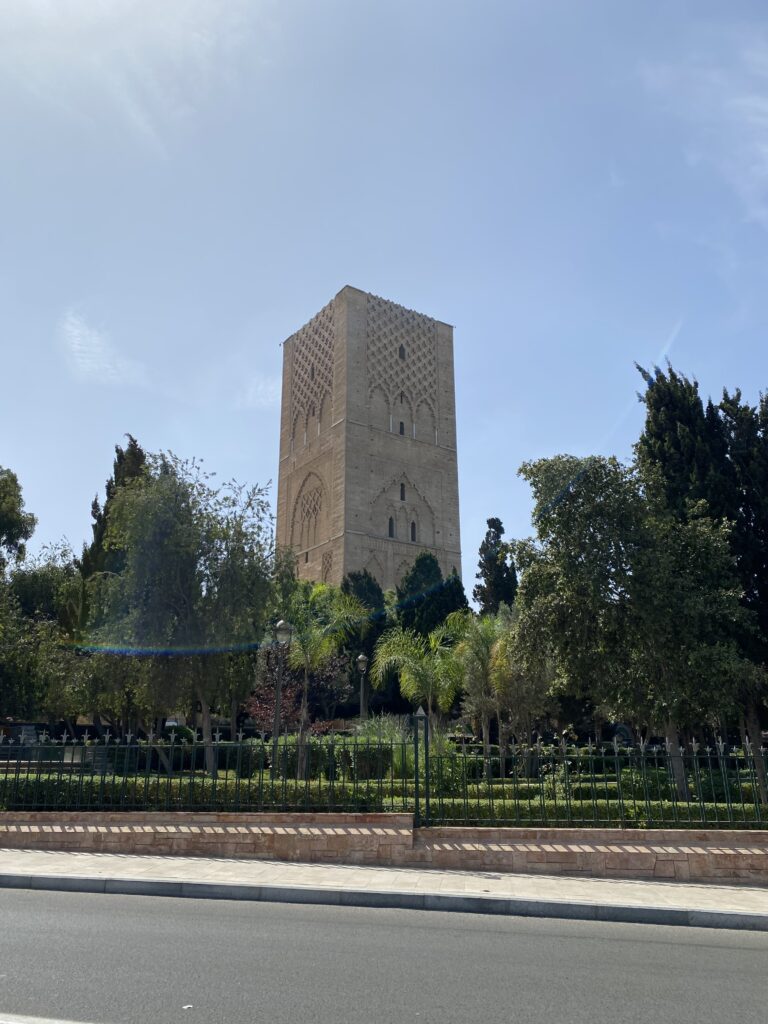
Opposite the unfinished minaret and pillars is the mausoleum of Mohammad V and an attached mosque. From the outside, you can admire the Islamic art of carved white onyx, woodwork, mosaic, and other details.
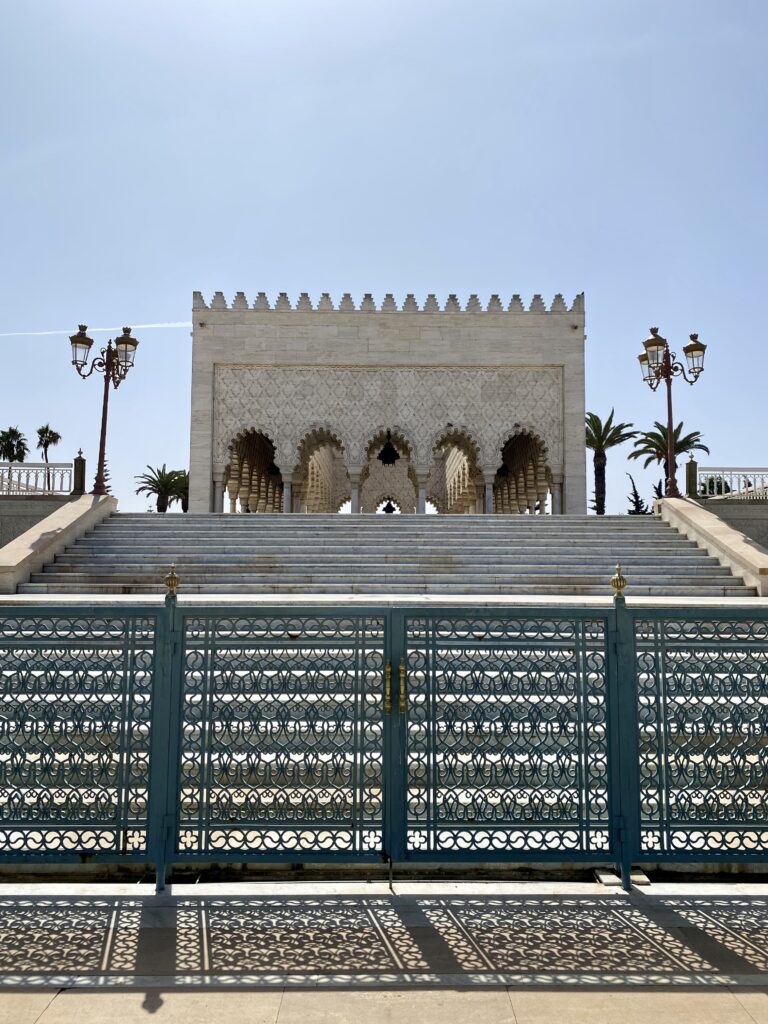

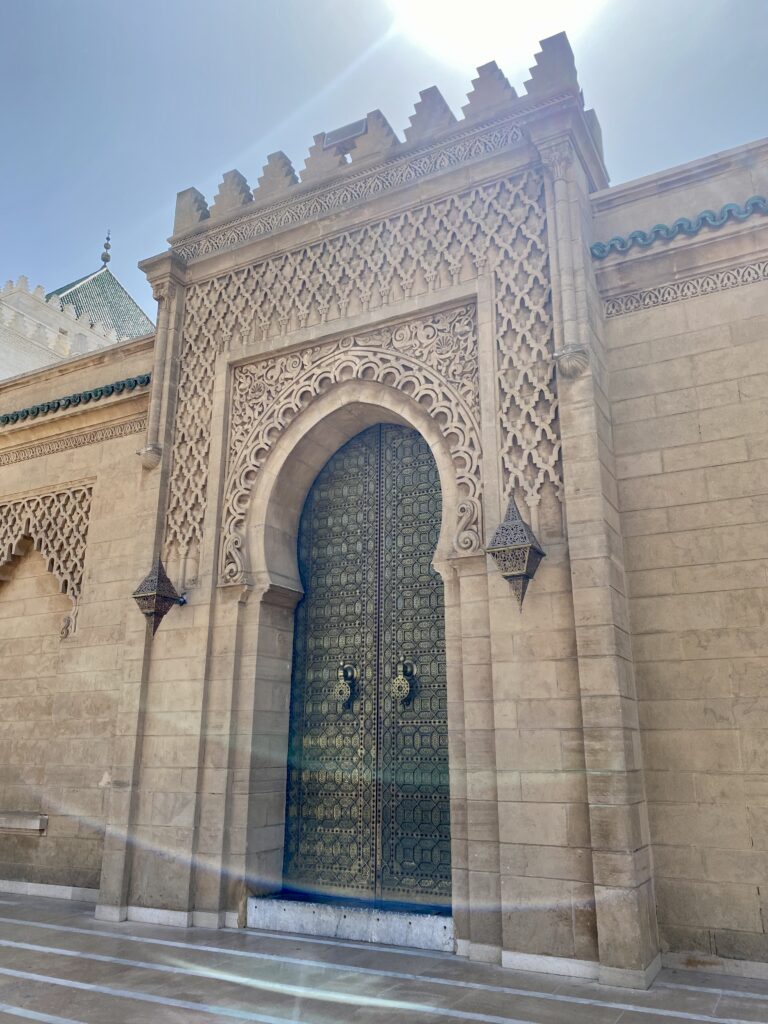

Rabat medina
Like the city itself, Rabat’s medina has wider streets and is a bit less hectic than other medinas I visited. It’s in a convenient location too, walking distance from the train station and close to the Kasbah of the Udayas, the beach, and Hassan Tower.
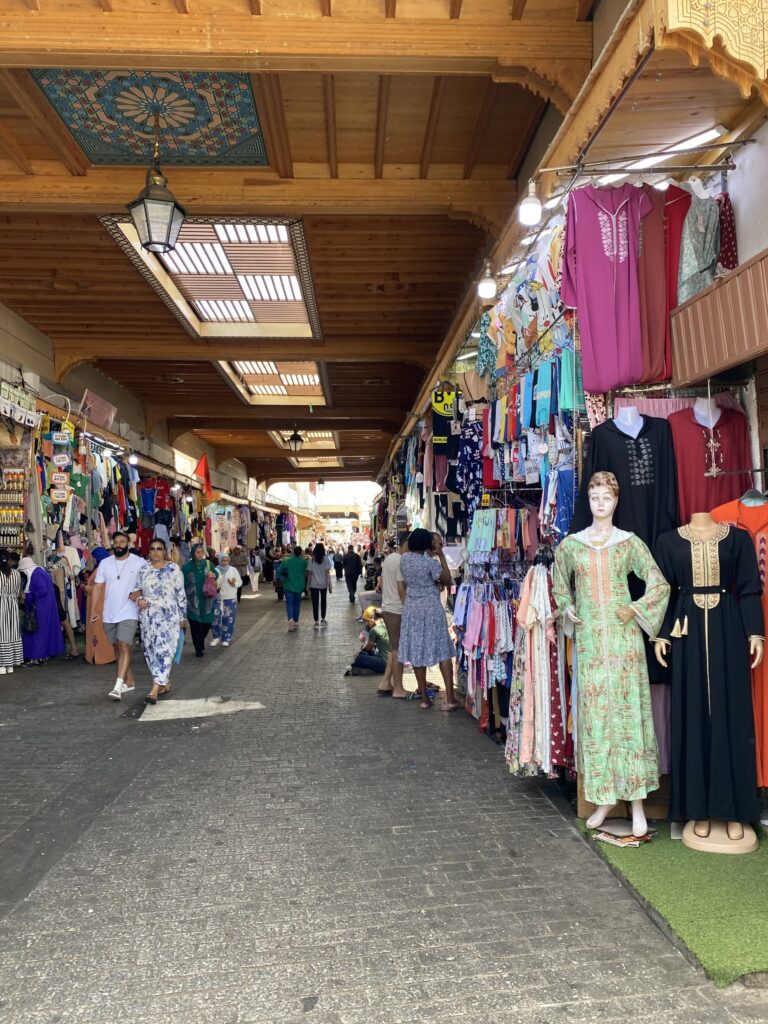
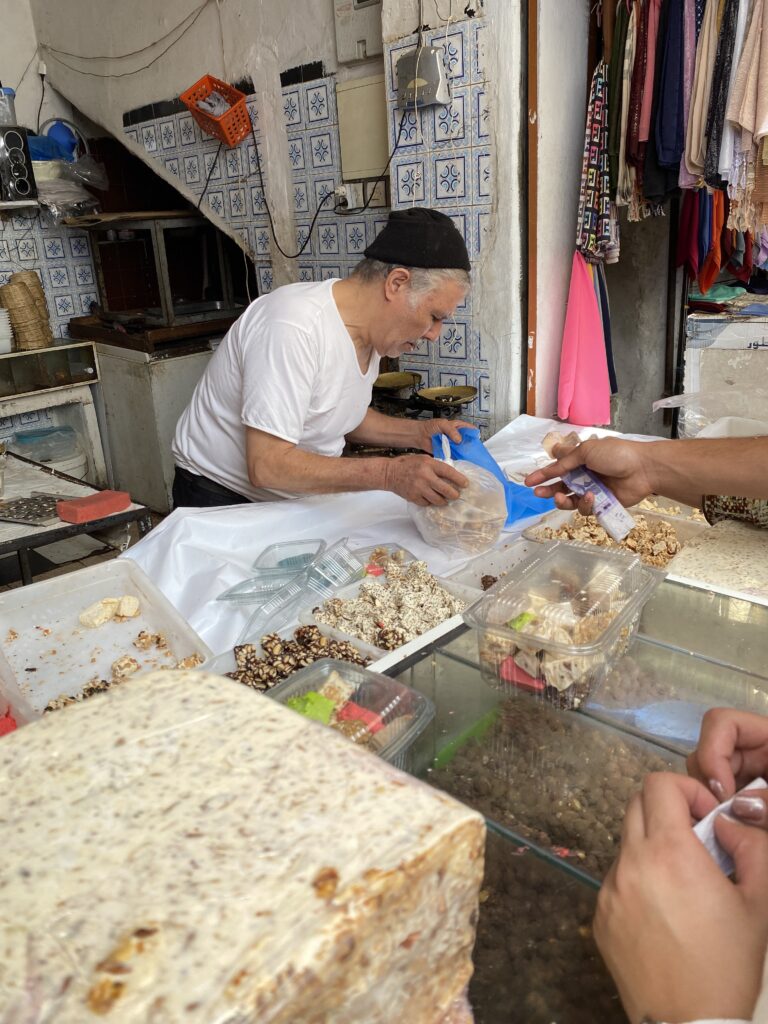
Other sights you should check out include:
- Chellah. Chellah is an ancient archeological site and necropolis. It was first occupied by Phoenicians in the first millenium BC, then it was the ancient Roman city of Sala Colonia, and then became a necropolis of the Marinid dynasty (late 13th century).
- Kasbah of the Udayas. This mid-12th century kasbah (citadel) is an UNESCO World Heritage Site. The walled area overlooks the Bou Regreg River and is located on the edge of the medina. Inside, it’s known for its blue and white walls and contains the Andalusian Garden, Pavilion of Moulay Ismail/Oudayas Museum, The Old Mosque, and the Gate of the Kasbah (Bab Oudaya).
- Gardens and green spaces. Andalusian Garden, Botanical Garden, Hassan Tower Garden, Nouzhat Hassan Garden, Hassan II Park, Les Jardins Exotiques de Bouknadel (The Exotic Gardens)
- Beaches. Rabat Beach, Salé Beach
- Museums. Mohammed VI Museum of Modern and Contemporary Art, Archeological Museum, National Photography Museum
- Royal Palace of Rabat. The King of Morocco has palaces in multiple cities, but this is his primary and official residence.
Stop #3: Moulay Idriss, a Holy City
The town of Moulay Idriss has historic and religious significance as the burial place of Idris I, who was the founder of the first Islamic state of Morocco at the end of the 7th century. In August, Muslims make the pilgrimage here to honor it. Because of the town’s holy status, it was only in 2005 that non-Muslims were allowed to stay here overnight and they couldn’t visit at all until 1912. It’s still a very quiet place with minimal tourism.
We arrived to the nearby city of Meknes by train and then took a taxi into town. Moulay Idriss is spread over two hills at the base of Mount Zerhoun, so be prepared to climb up steep hills and steps. To get your luggage up to your lodging from the main road, you can hire a mule to carry it.
We stayed overnight at a homestay owned by a local family, called La Colombe Blanche. This was my second-favorite lodging of the entire trip. There were rooms on three floors with a great view at the top, and included a home-cooked Moroccan dinner.
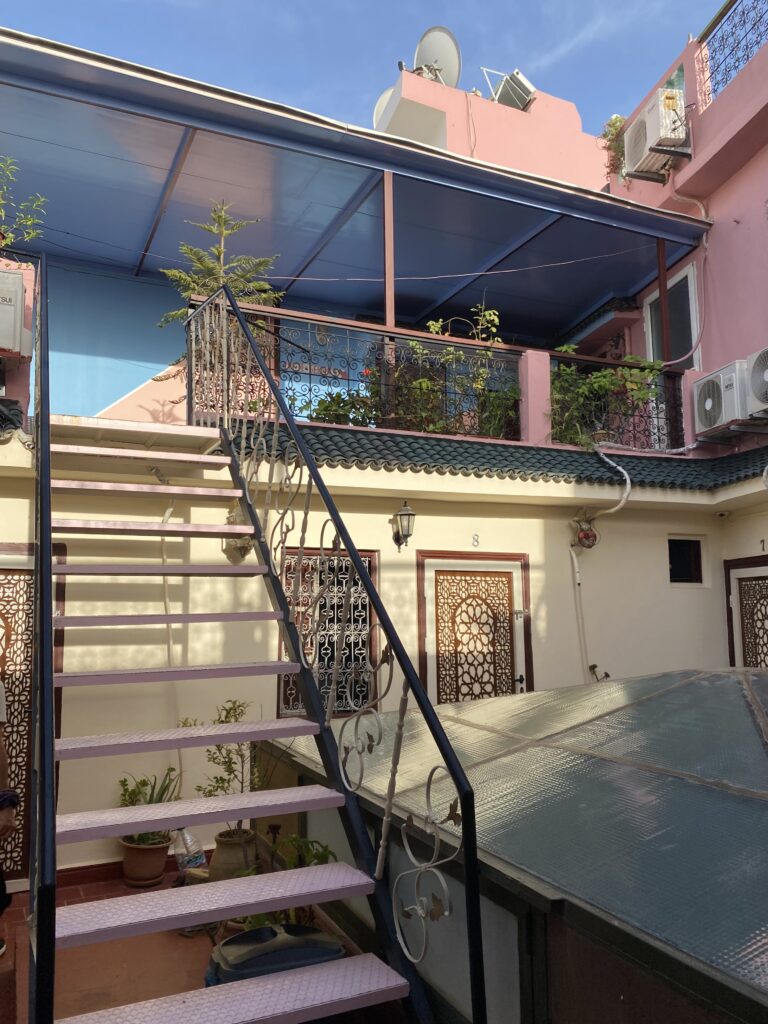
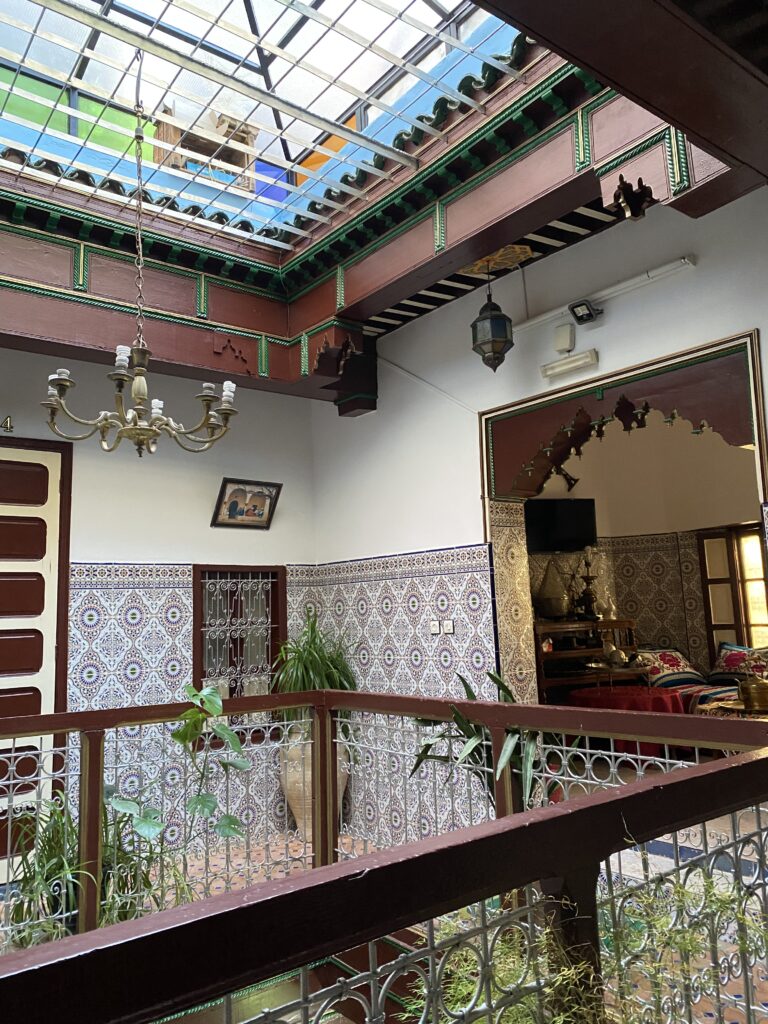


Once settled, we took a walking tour led by a local guide, ending with a sunset view during the evening call to prayer. From high up we could see the rest of town, the mountains, and even Volubilis (keep reading!) in the distance.
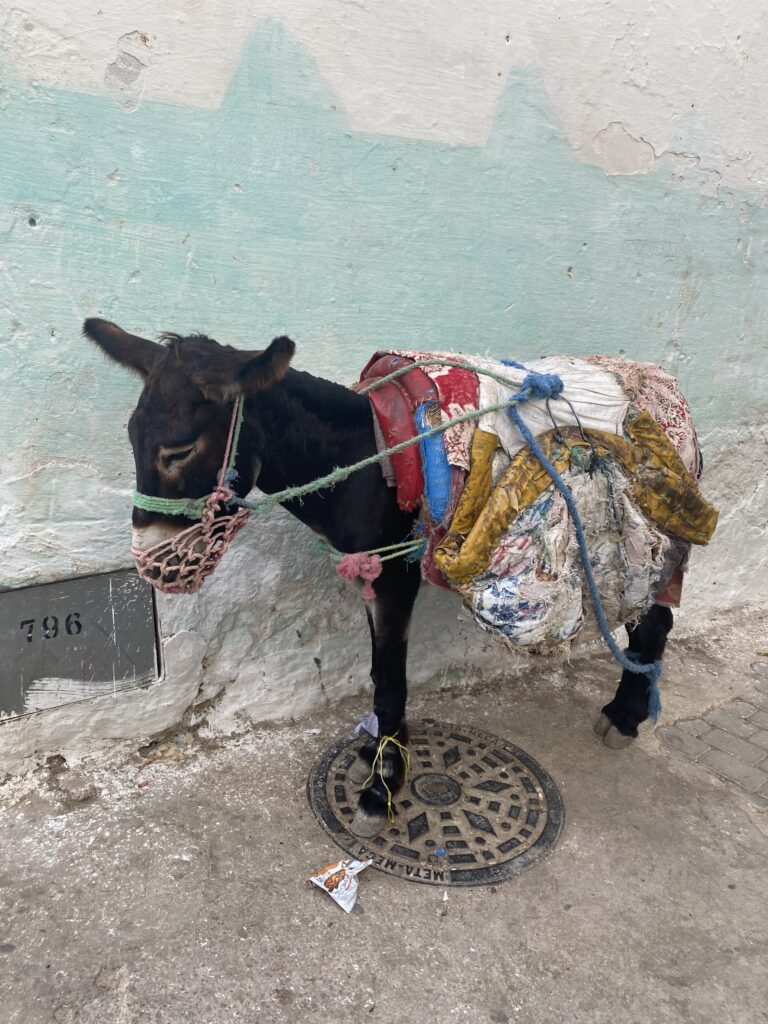
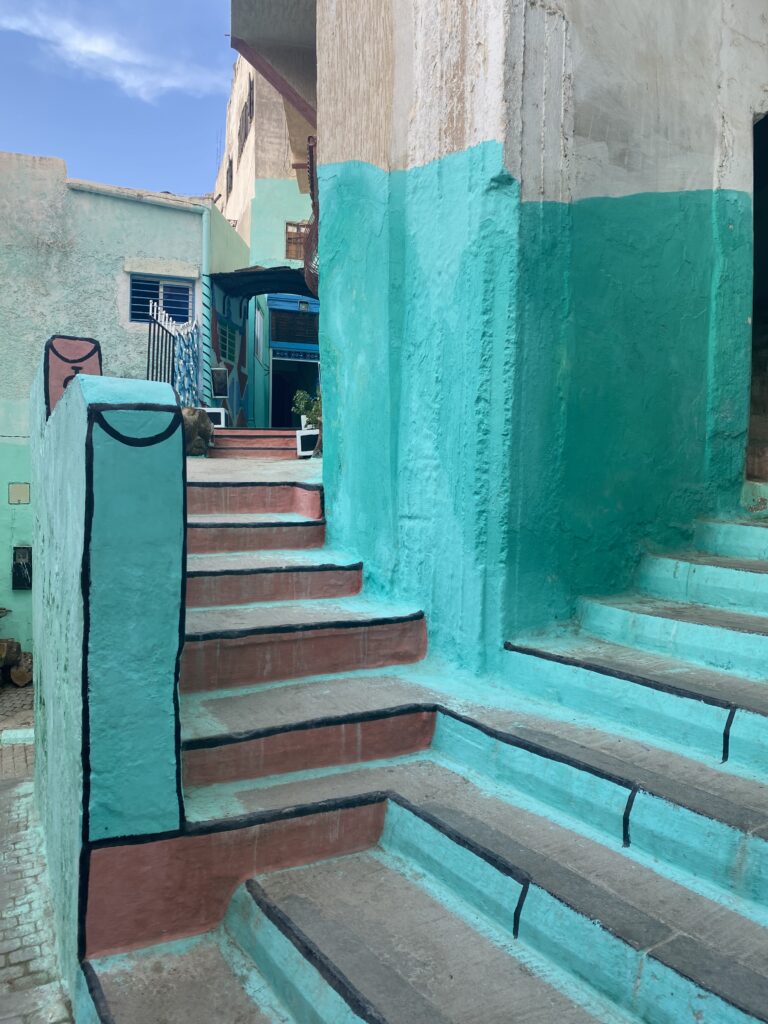
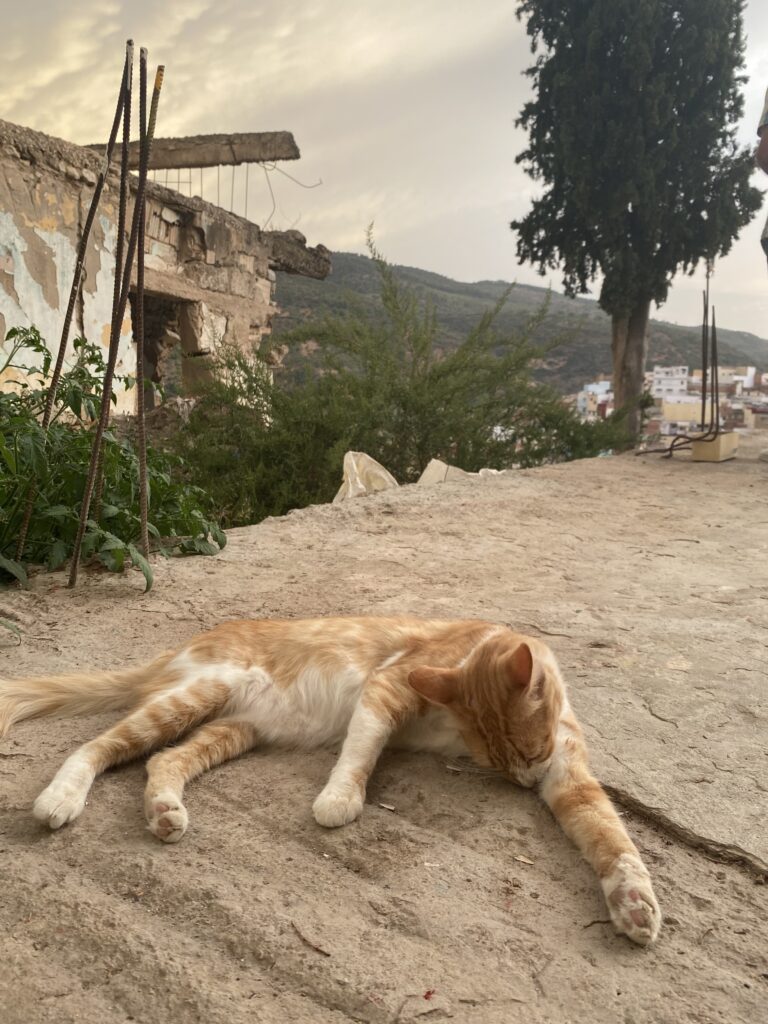
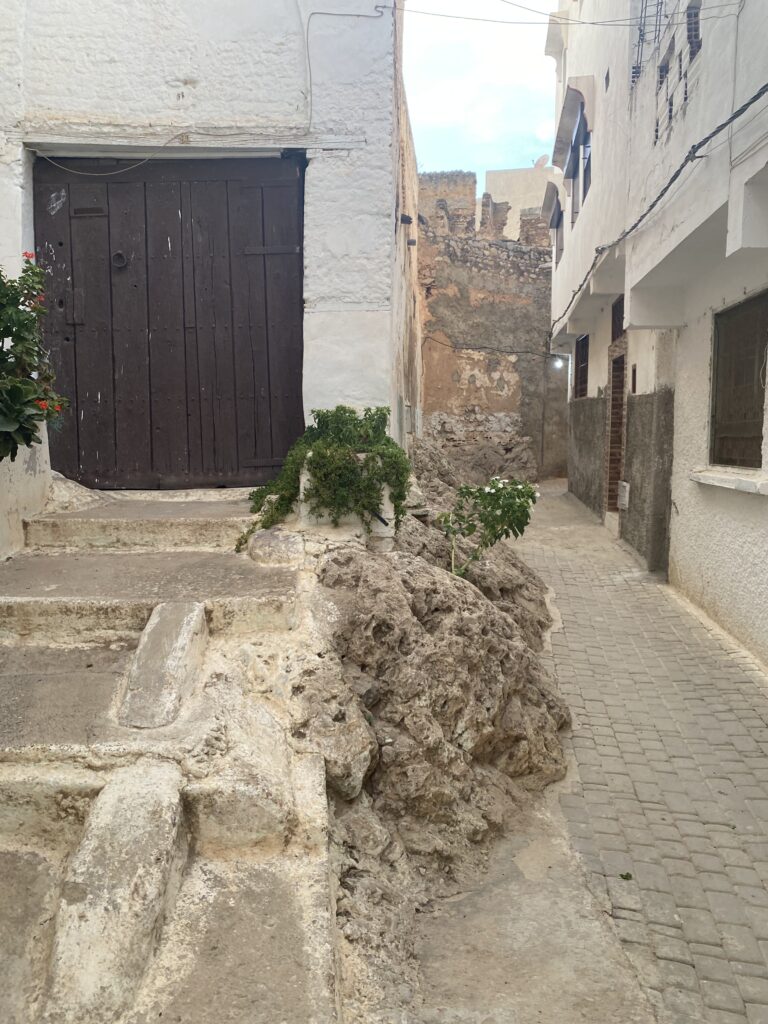

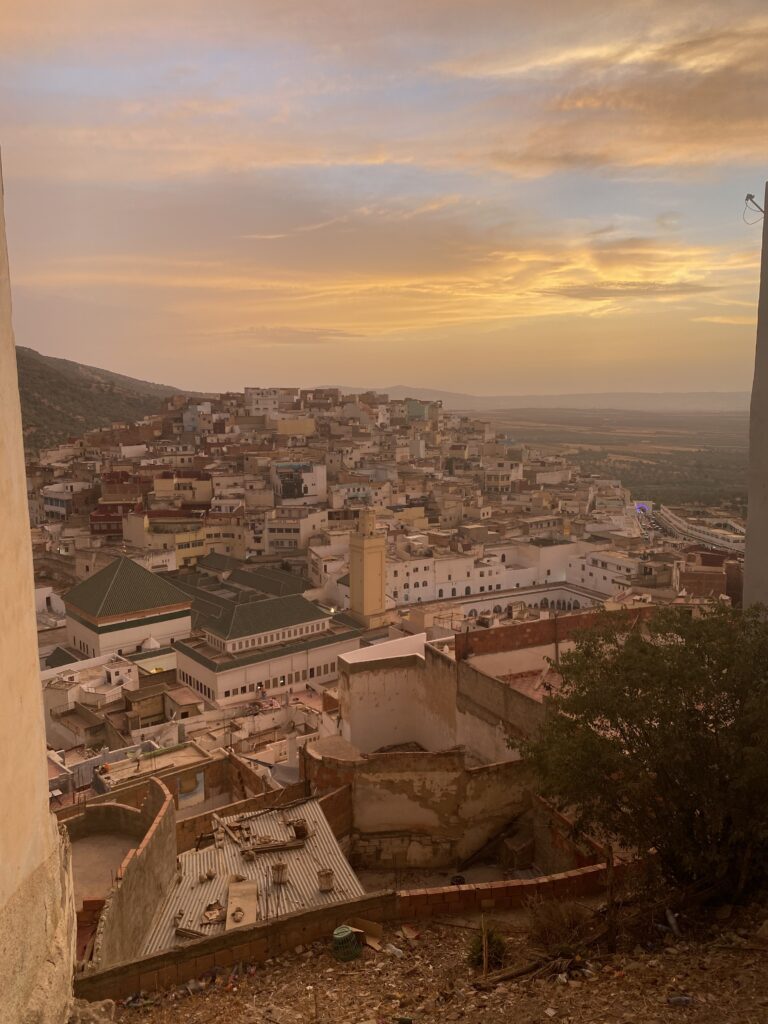
Stop #4: Volubilis, a Well-Preserved Amazigh-Roman City
The ancient Amazigh-Roman city of Volubilis is breathtaking and required viewing. This UNESCO World Heritage site is located near Meknes and Moulay Idriss, so we stopped there before heading back to the Meknes train station.
Volubilis was on the edge of the Roman Empire, which included parts of North Africa. Before becoming the capital of the kingdom of Mauritania, it was an Amazigh, then proto-Carthaginian settlement. Residents made money from olive growing and you can still see signs of wealth in large homes with elaborate mosaic floors.
The site also has a temple, triumphal arch, huge main road, bathhouse, and plenty of other structures you may not recognize just by looking at the ruins. The same local tour guide we had in Moulay Idriss led us through Volubilis. I’m glad we had a guide because he shared a lot of interesting facts about Roman life and how they used different structures in the city.
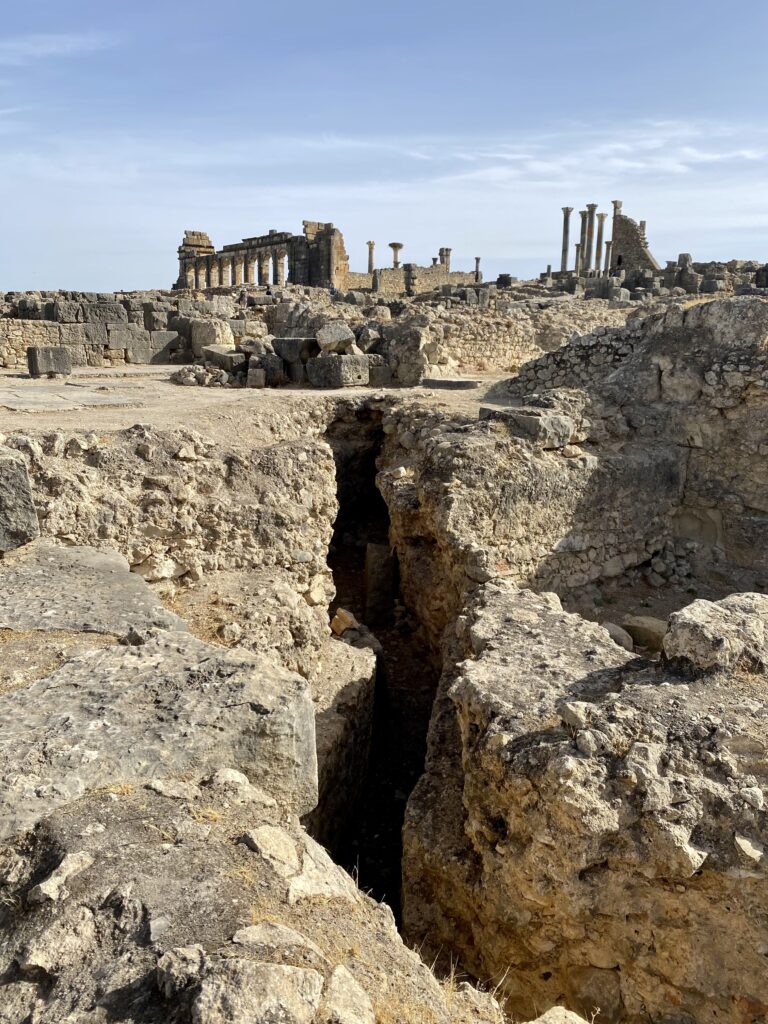
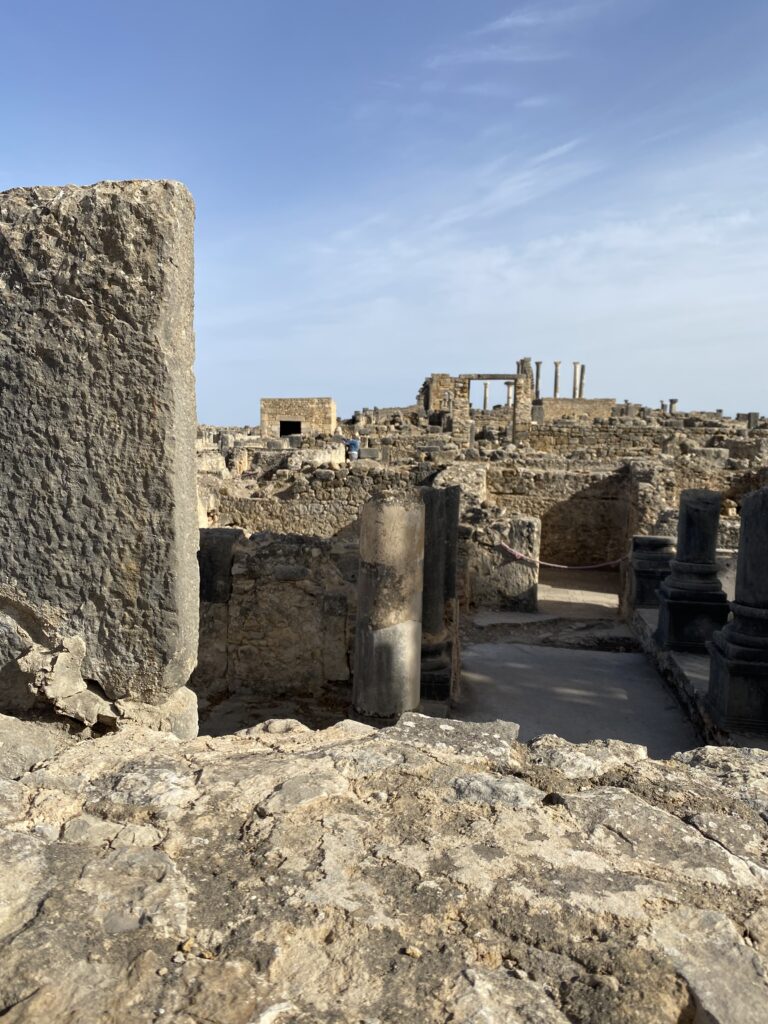
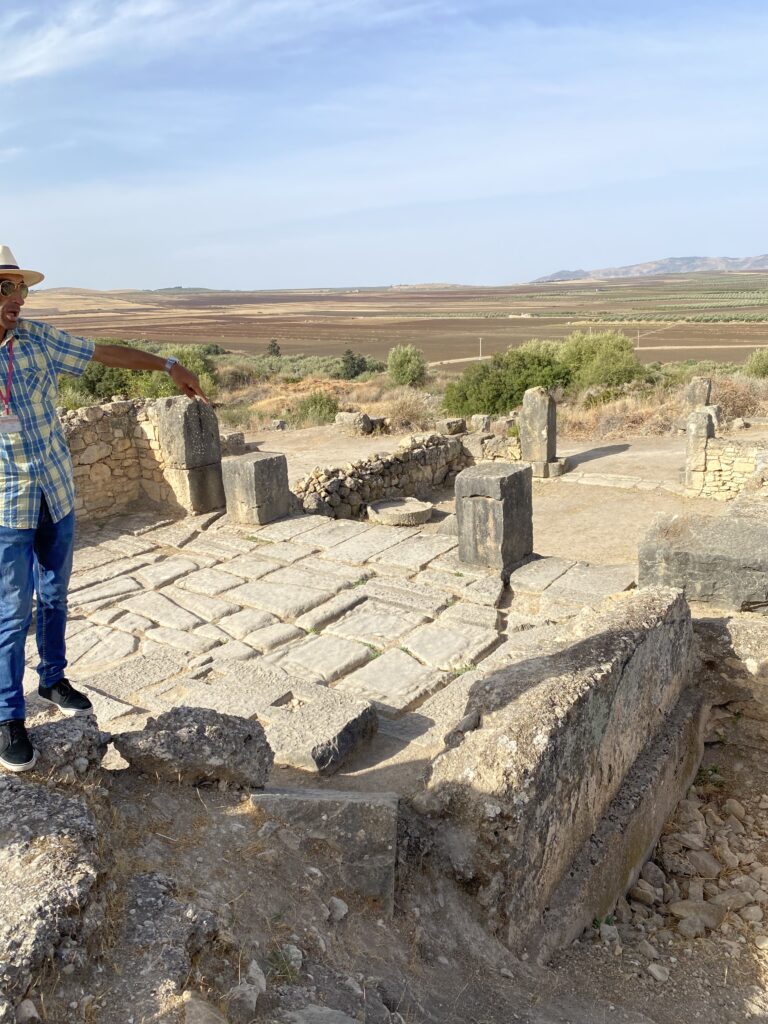
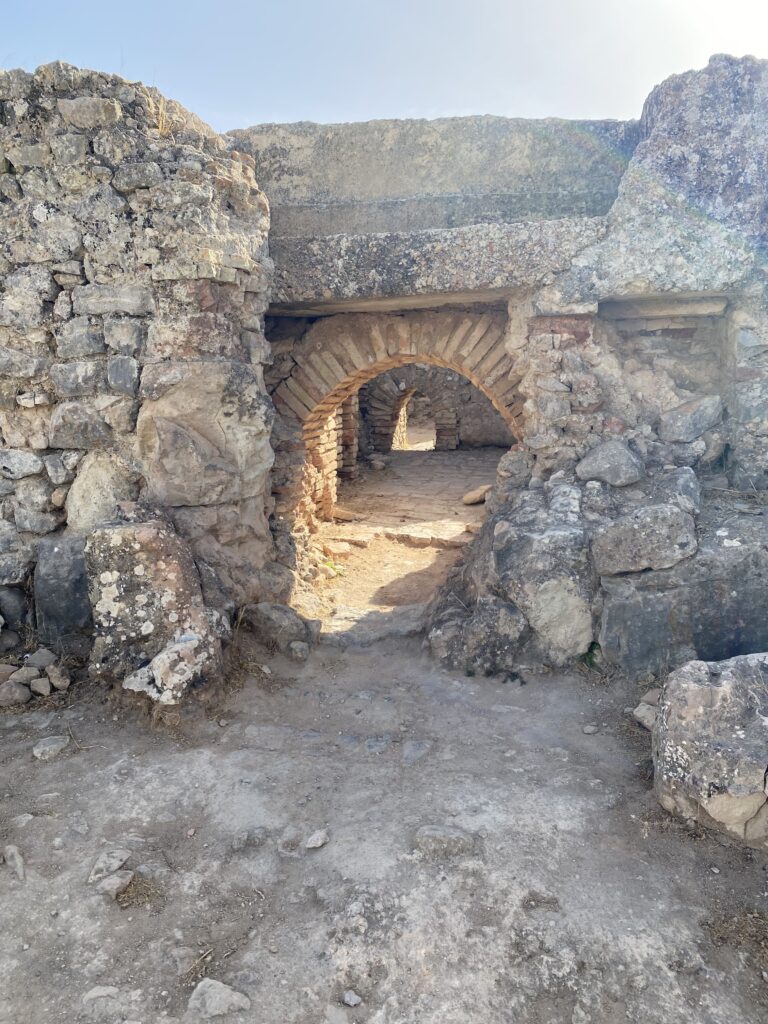
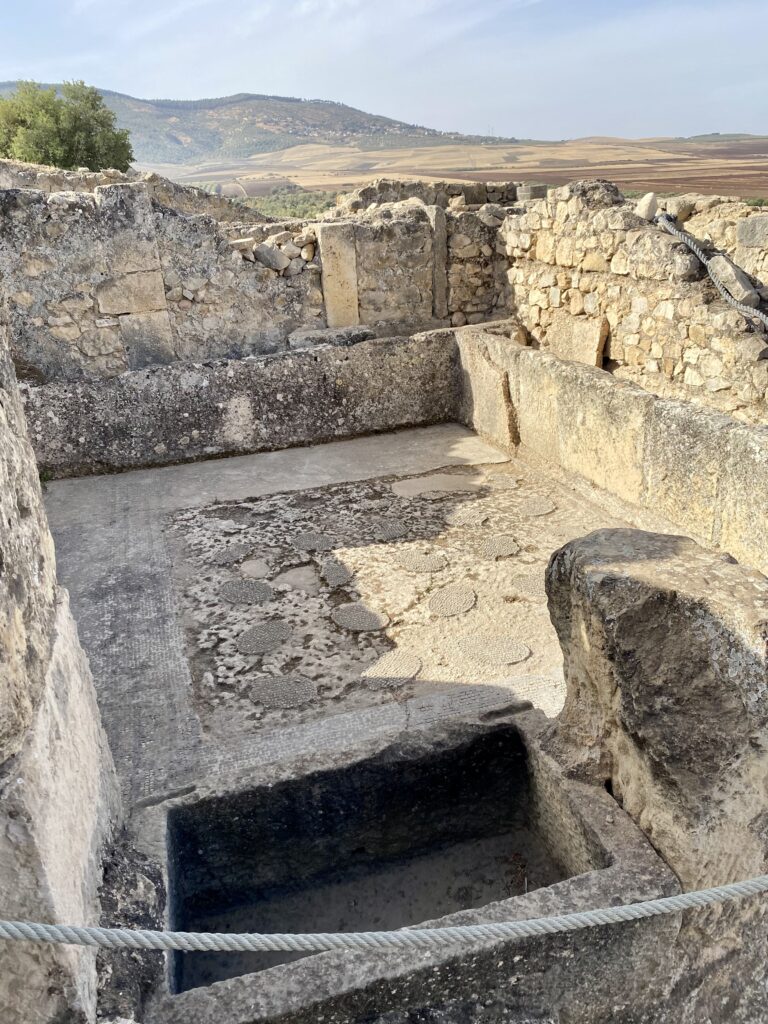





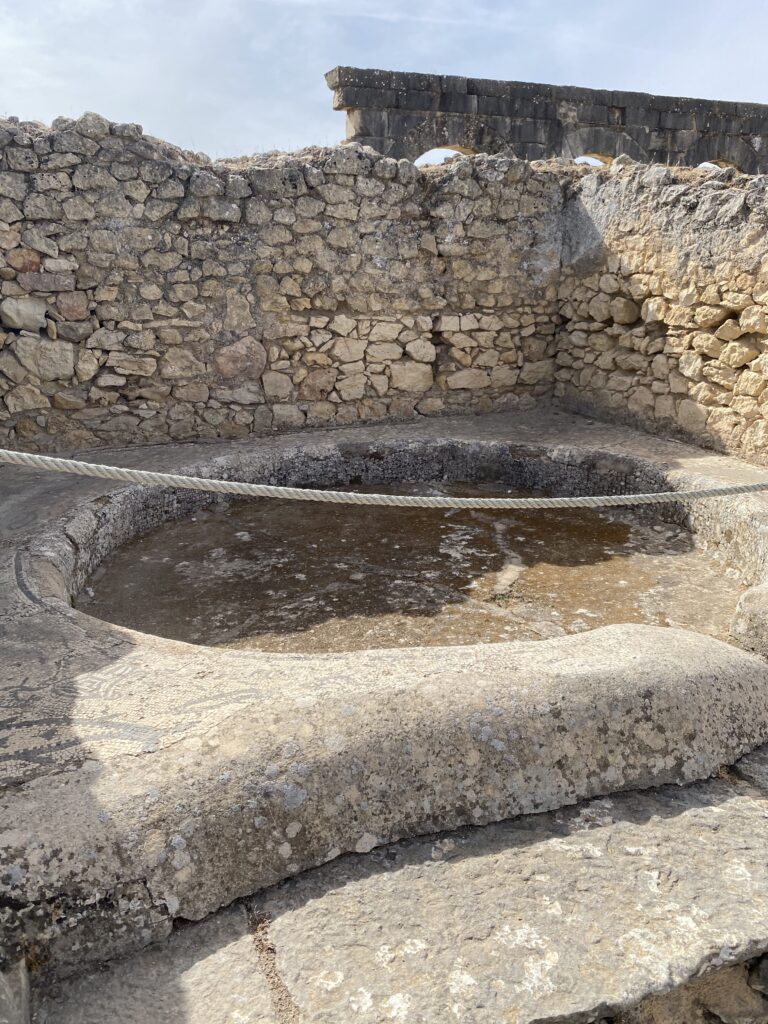
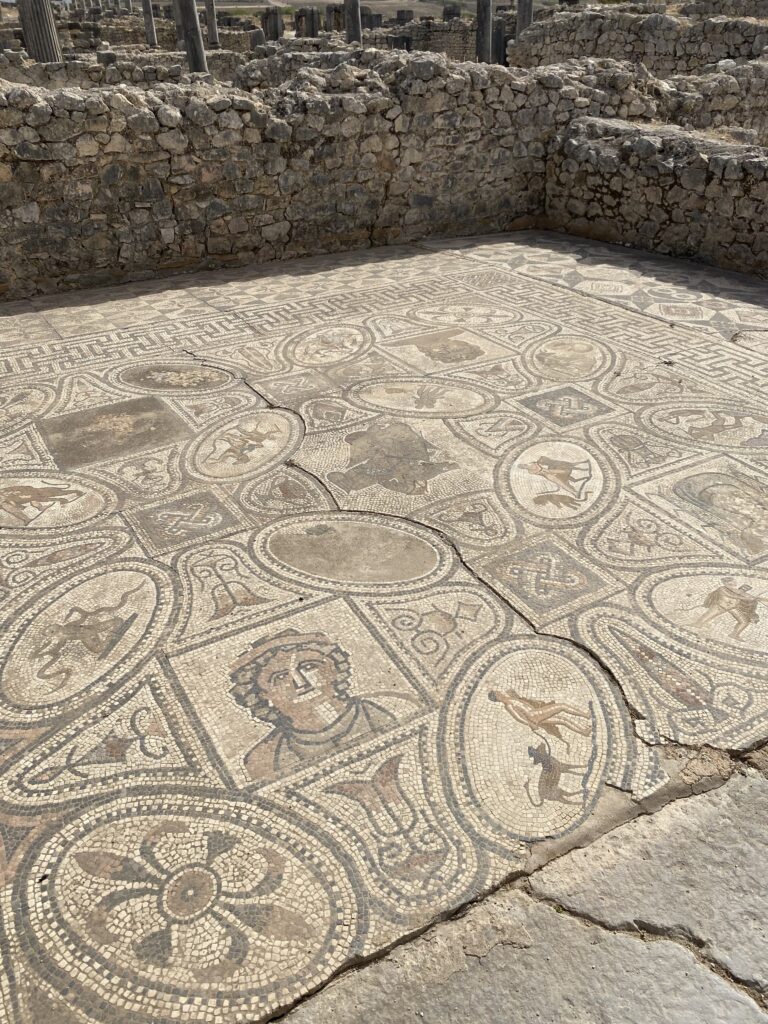
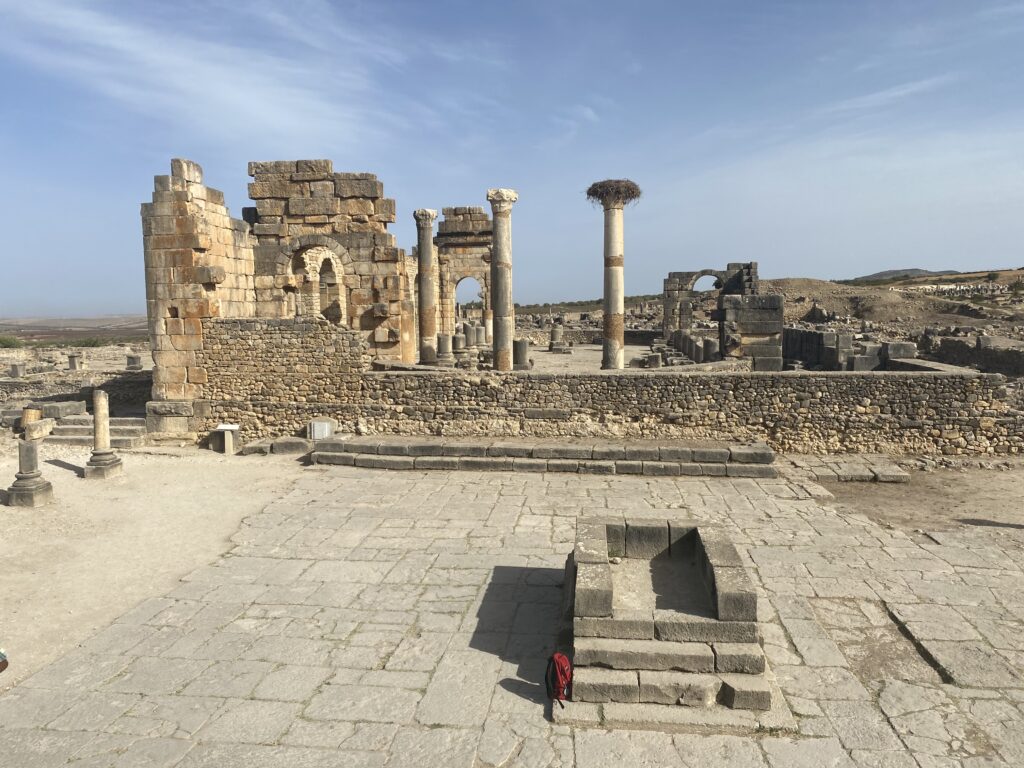
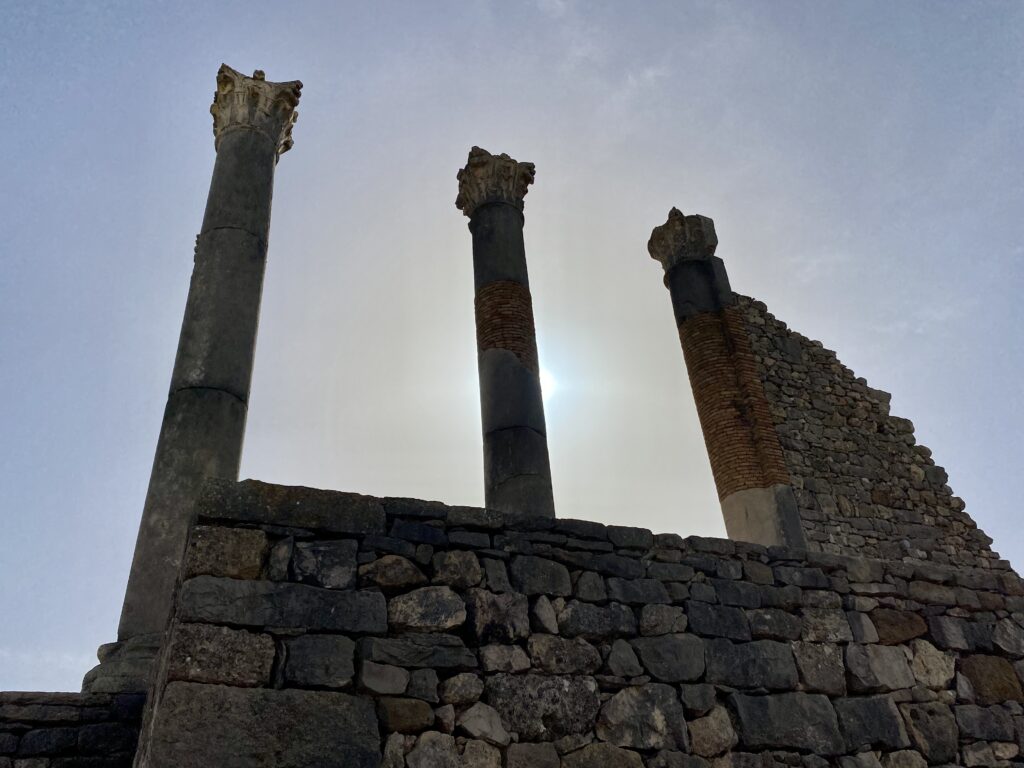
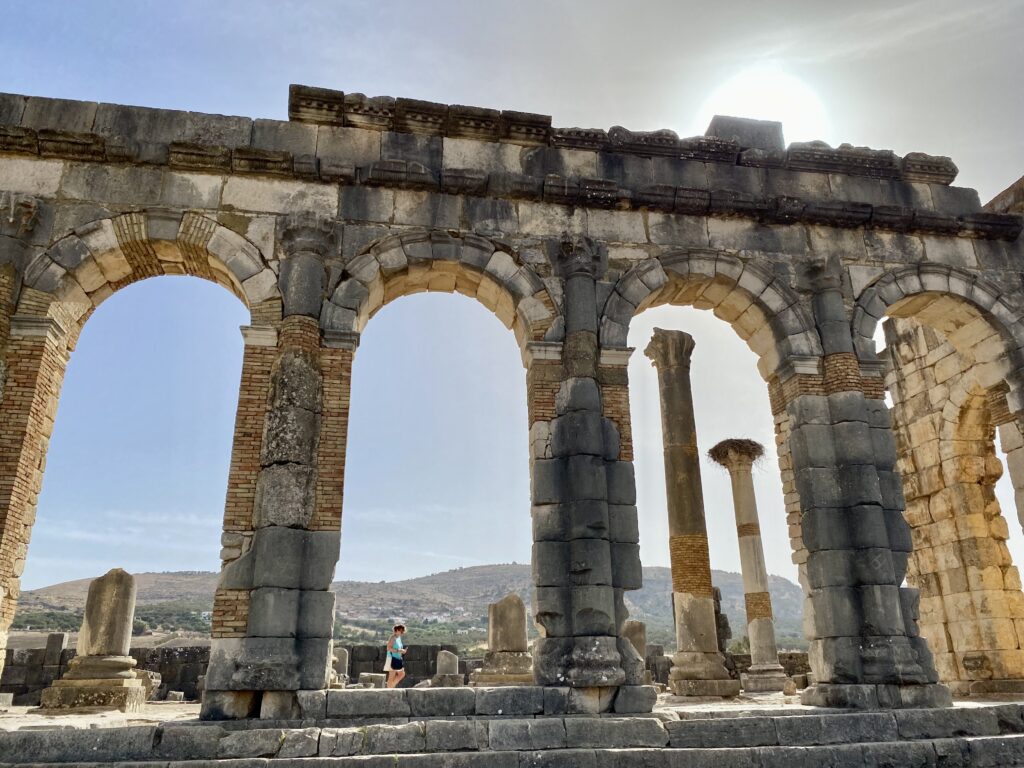

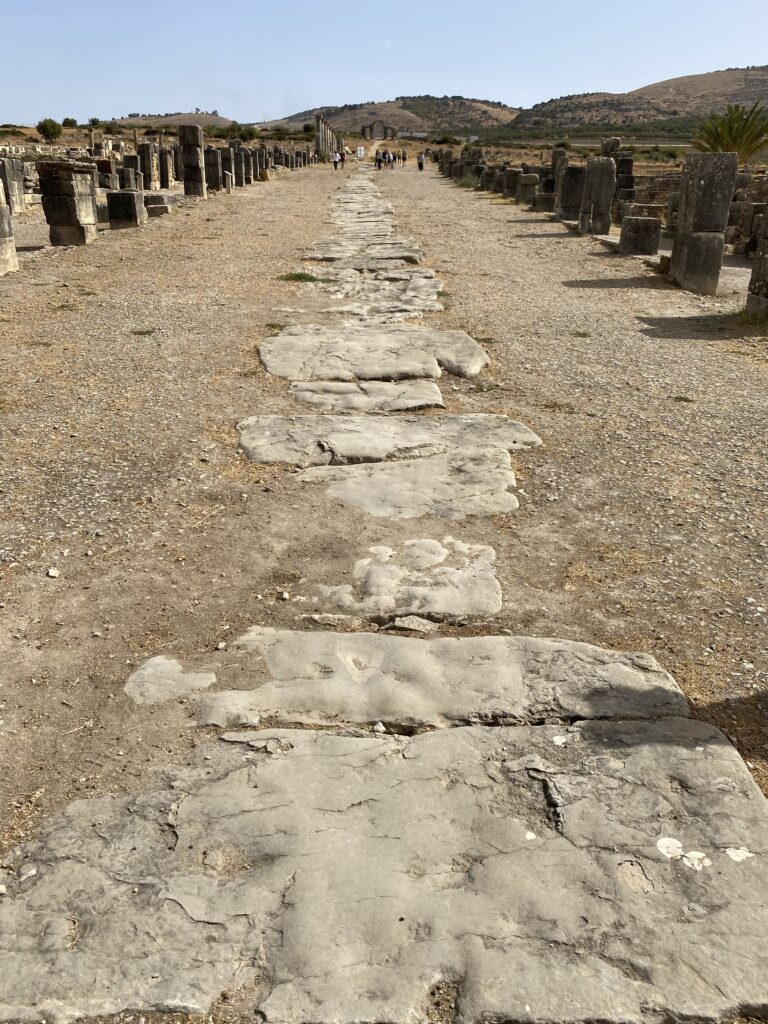
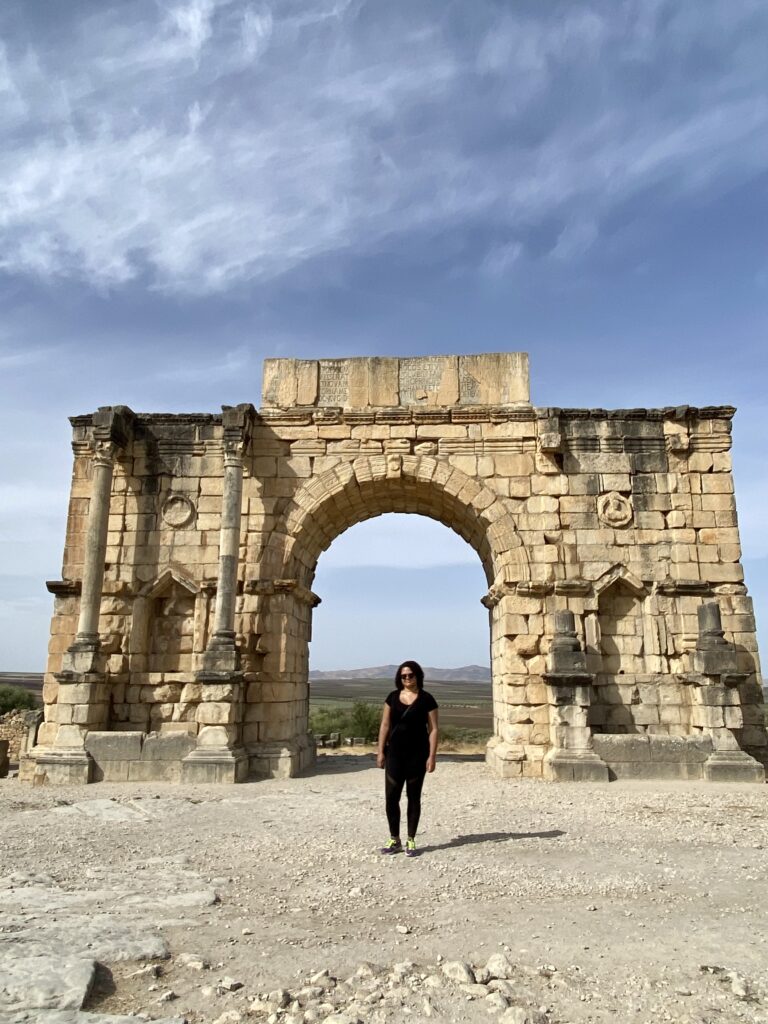
The site is completely unprotected from the sun, so make sure to prepare with sunscreen, a hat, and appropriate clothing. There’s a small cafe at the entrance so you can buy bottled water if you didn’t bring your own. There’s also a small indoor exhibit with some history and artifacts found at the site.
Stop #5: Meknes, the “Versailles of Morocco”
Meknes is a historic city that was declared an UNESCO World Heritage site for its preservation of 17th century Islamic architecture. It’s one of Morocco’s four imperial cities and often overlooked by visitors, but worth a visit.
Moulay Ismail Mausoleum
After Volubilis, we drove into Meknes and visited the mausoleum of Moulay Ismail just outside the medina walls. Moulay Ismail was sultan of Morocco from 1672-1727. The complex includes courtyards and multiple rooms, including the mausoleum chamber. The tilework, carvings, and architecture make it a worthwhile visit.
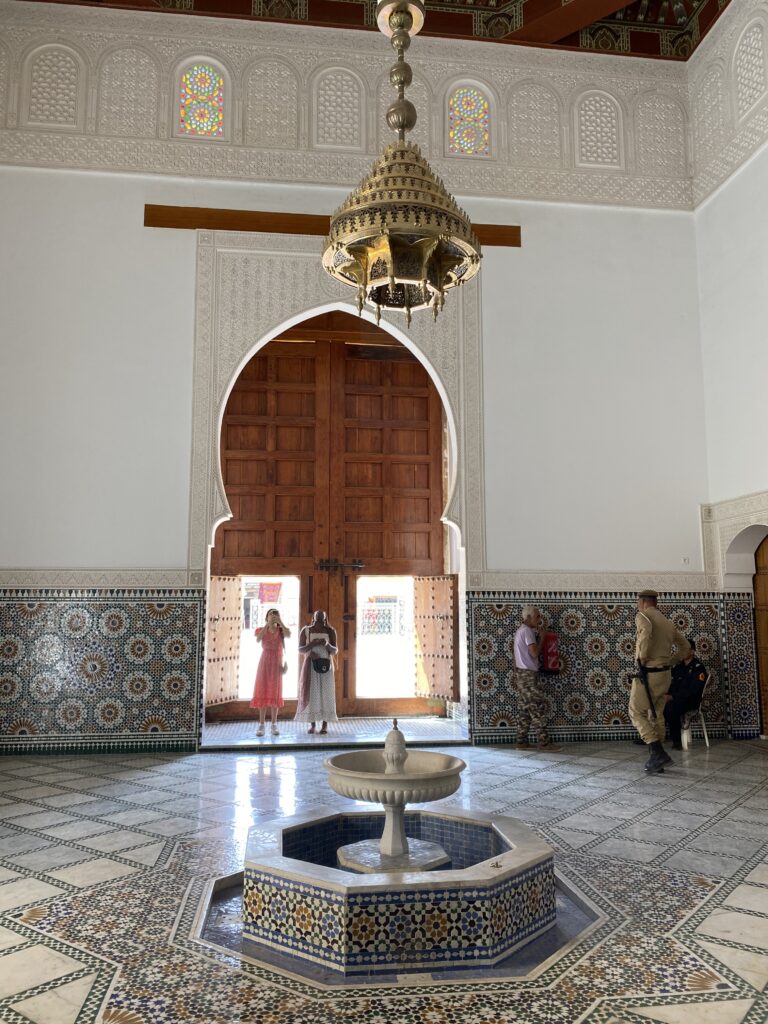

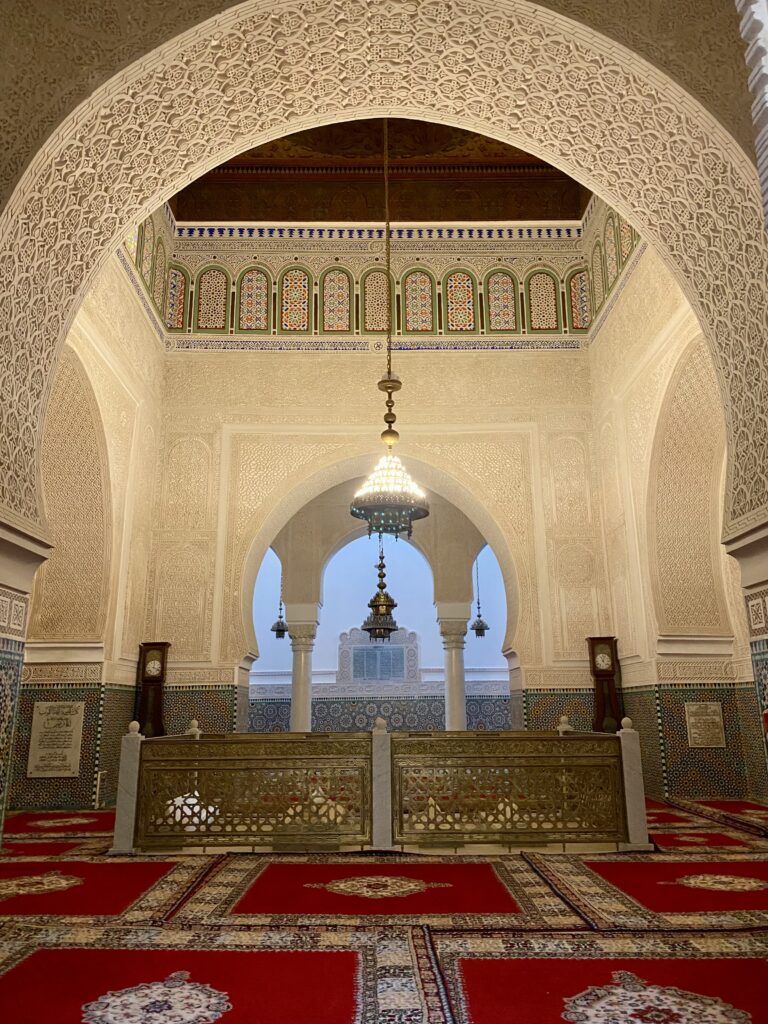
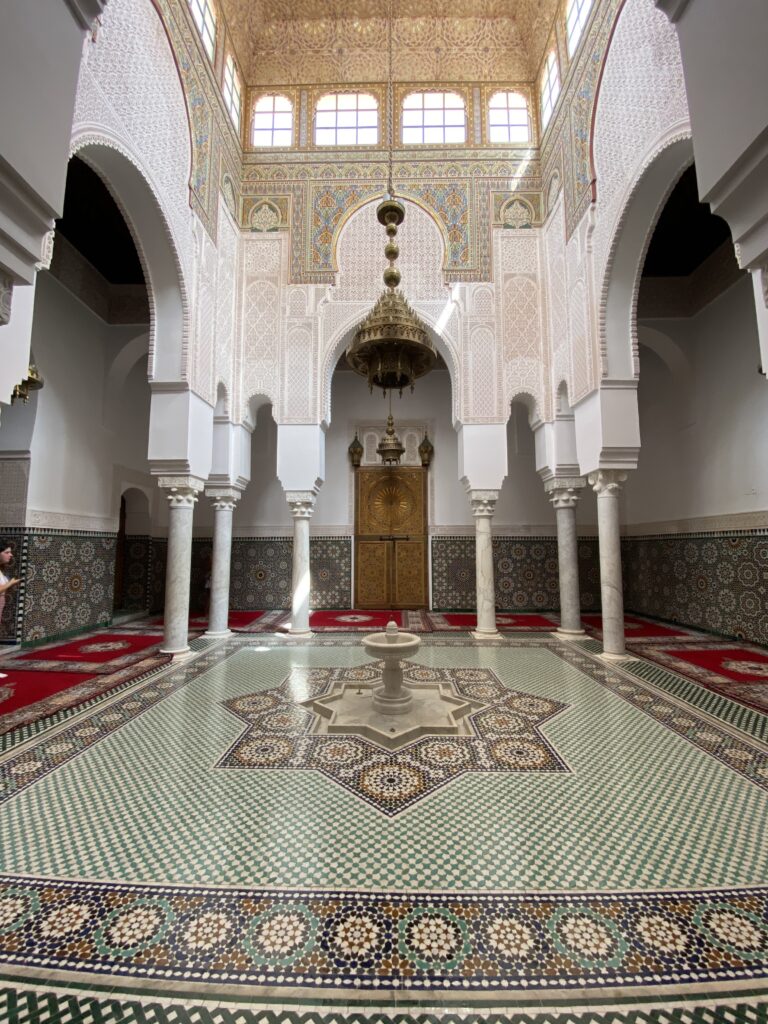
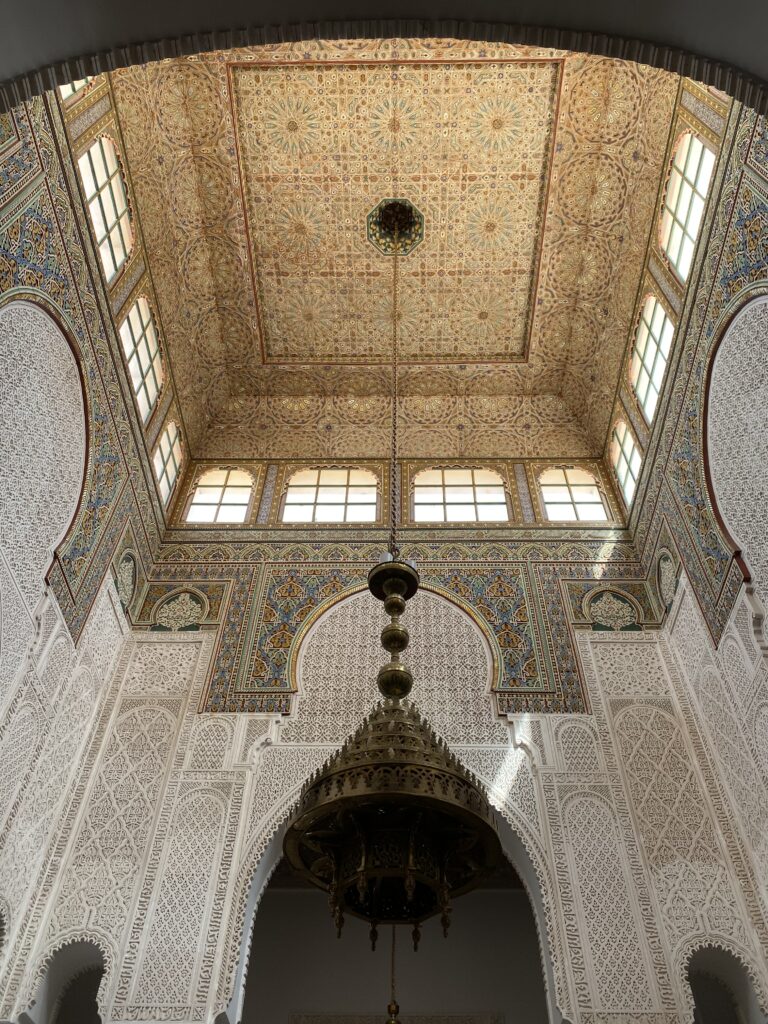
Afterwards, we stopped by an artisan’s studio down the street. We learned about traditional Amazigh stitching and metalwork from the artisans and had the opportunity to shop.


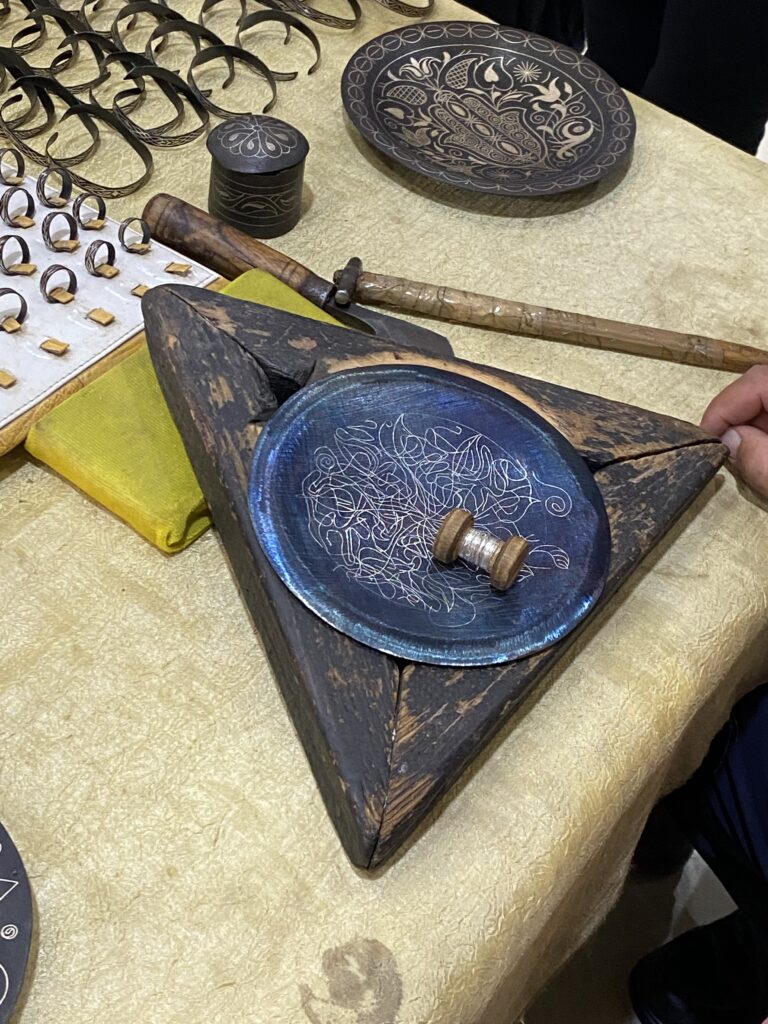

Camel burgers in the Meknes medina
Then it was lunchtime. We ate at a local family’s home nearby in the medina. Camel burgers were served, which were camel meatballs in a pita bun. They were pretty good! As usual, it came with Moroccan mint tea.
A personalized experience like this is one of the perks of a group trip. This family didn’t manage a restaurant for the public. We were only able to have this experience because we were on an Intrepid Travel tour.
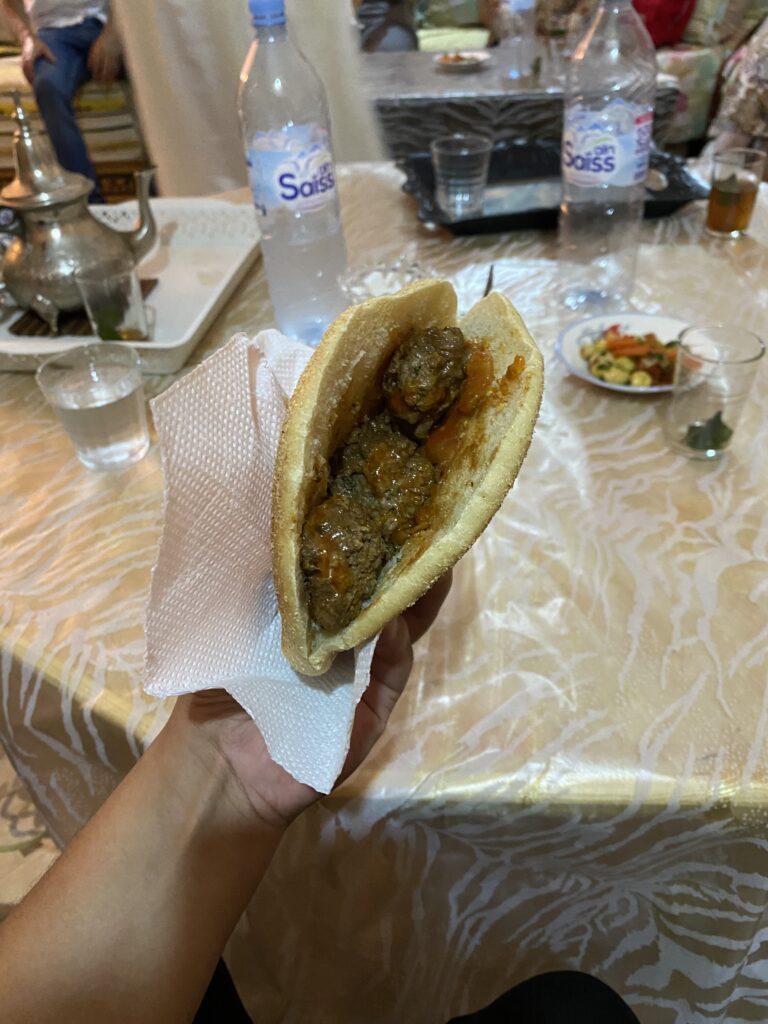

After lunch, we took a short stroll through the Meknes medina and then off to the next stop, Fes.

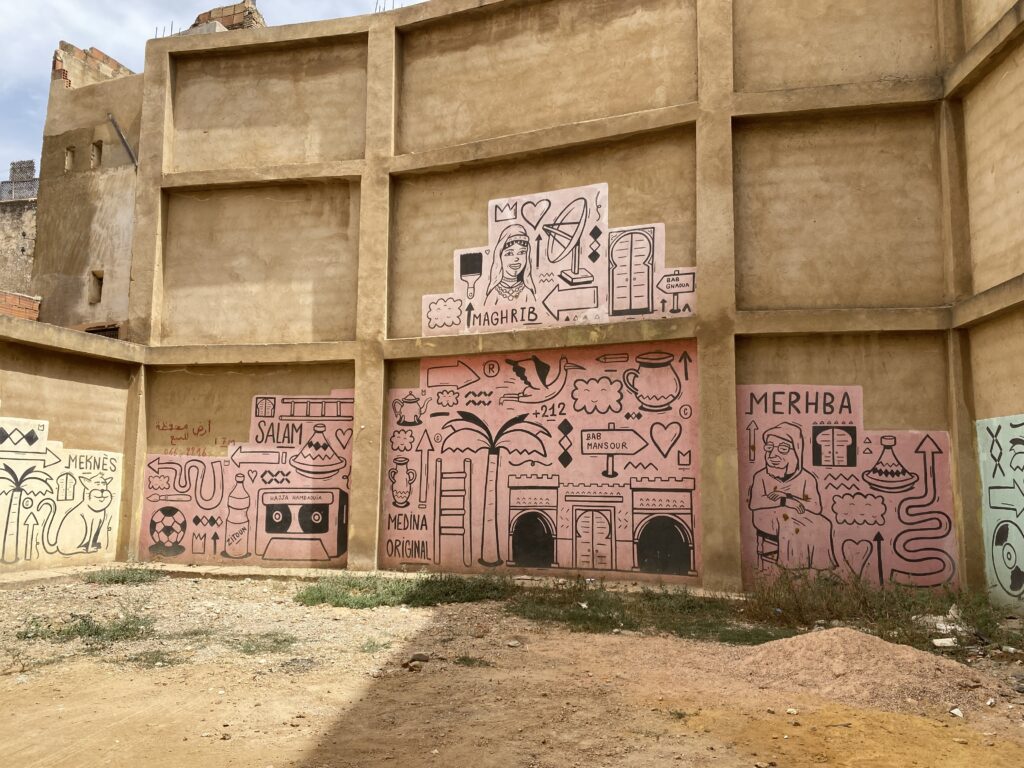
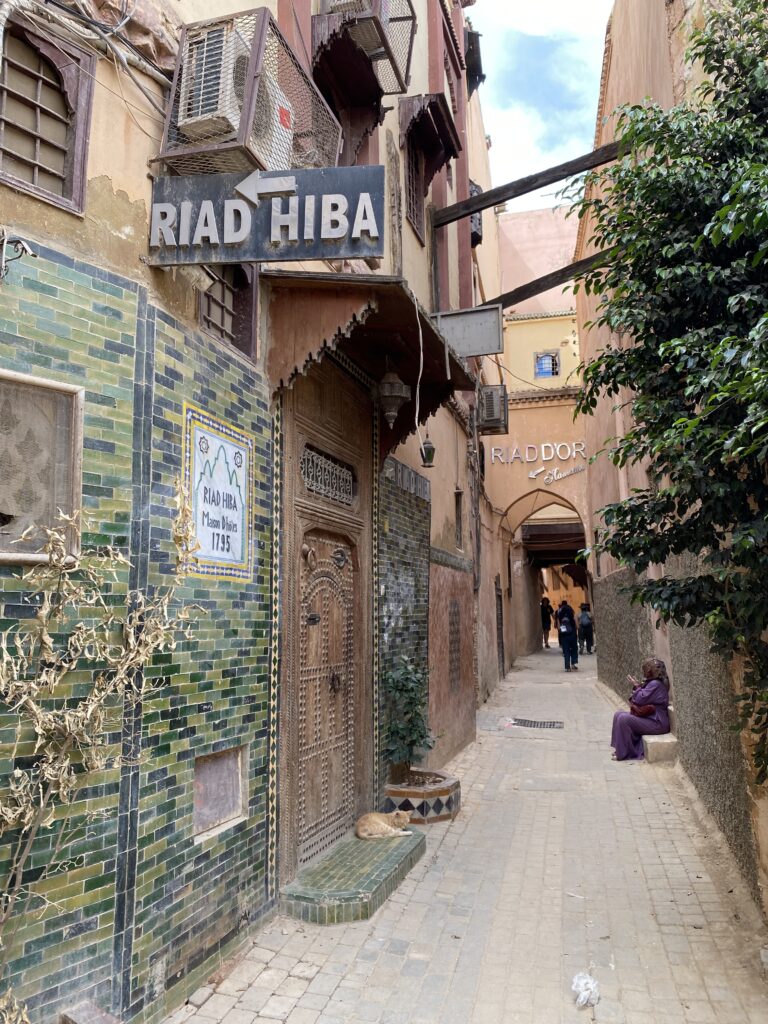

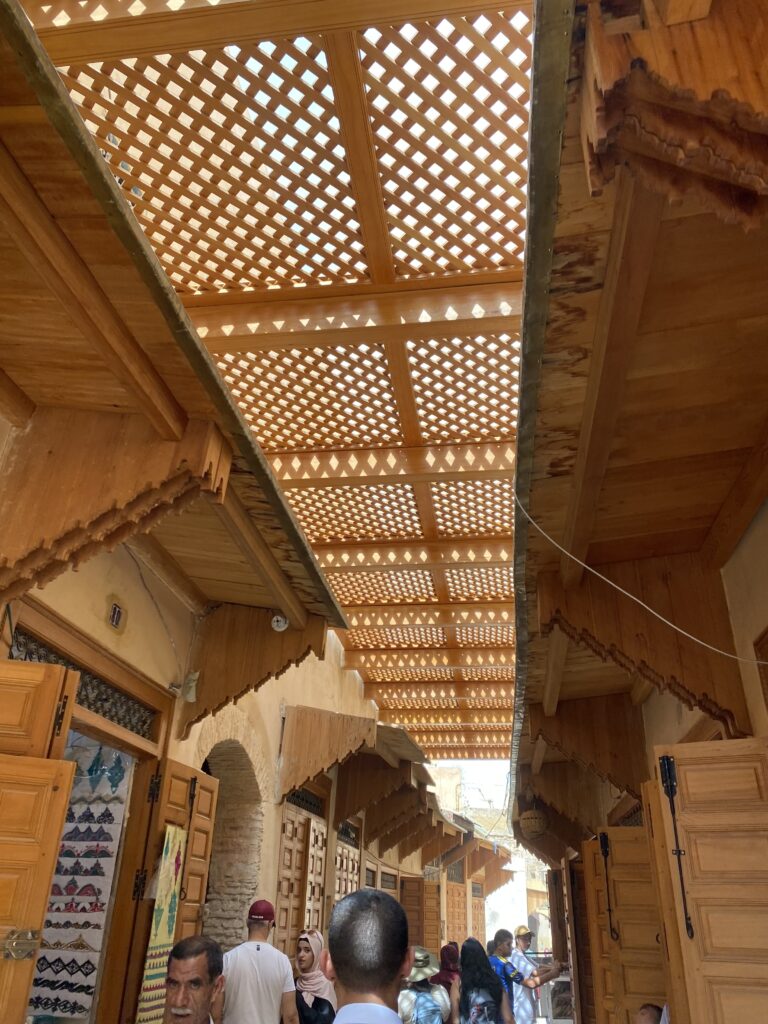
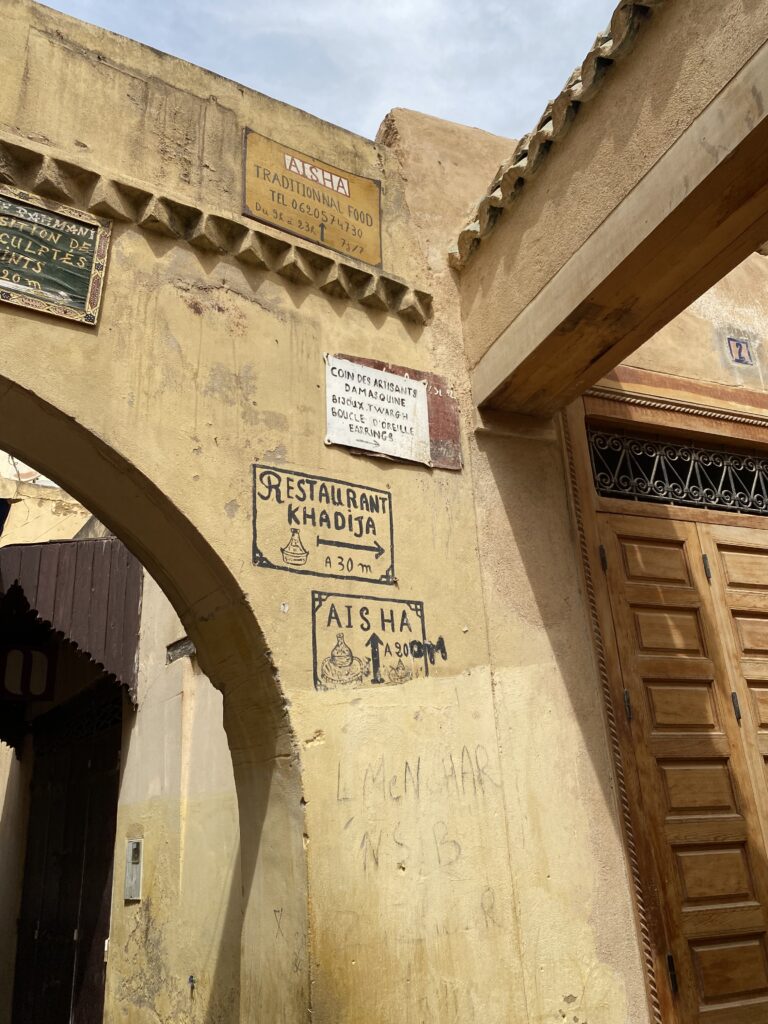
Stop #6: Fes, the Old Capital City
Fes is the former capital city of Morocco and home to the largest medina in the world. We took the train from Meknes to Fes, arriving at the Gare de Fes train station in the modern urban center.
Before venturing into the winding streets of the medina, we first stopped by a pottery center for a tour. The guide took us through the process, from the raw clay to different finished products, as we watched the artisans in action.

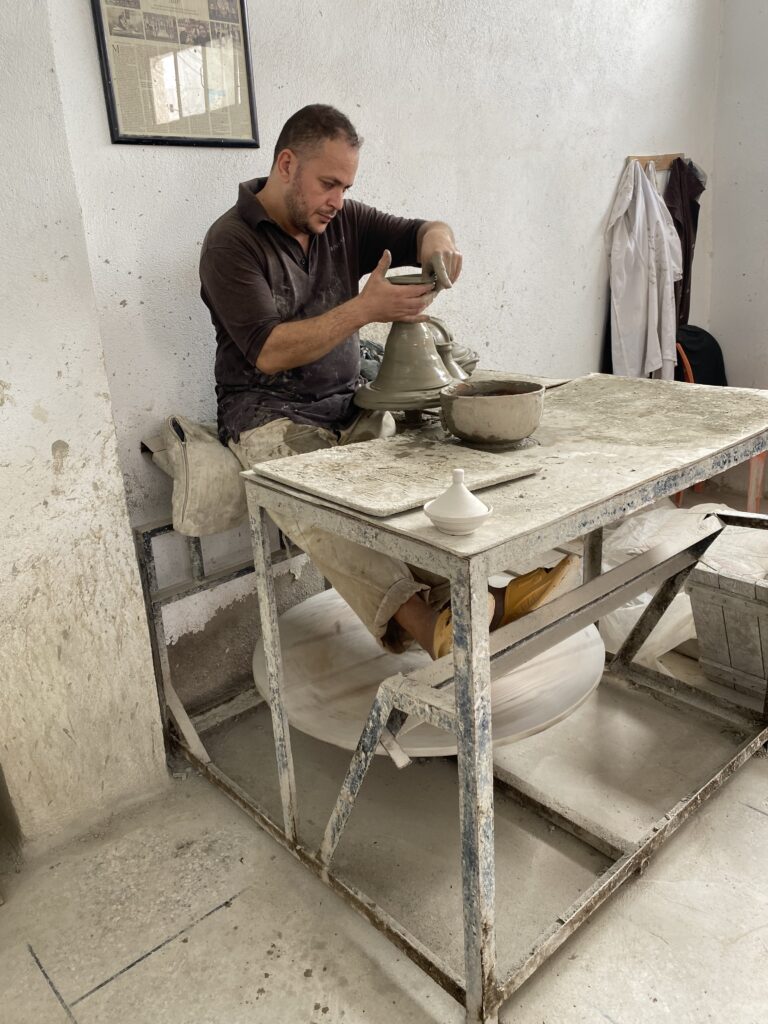

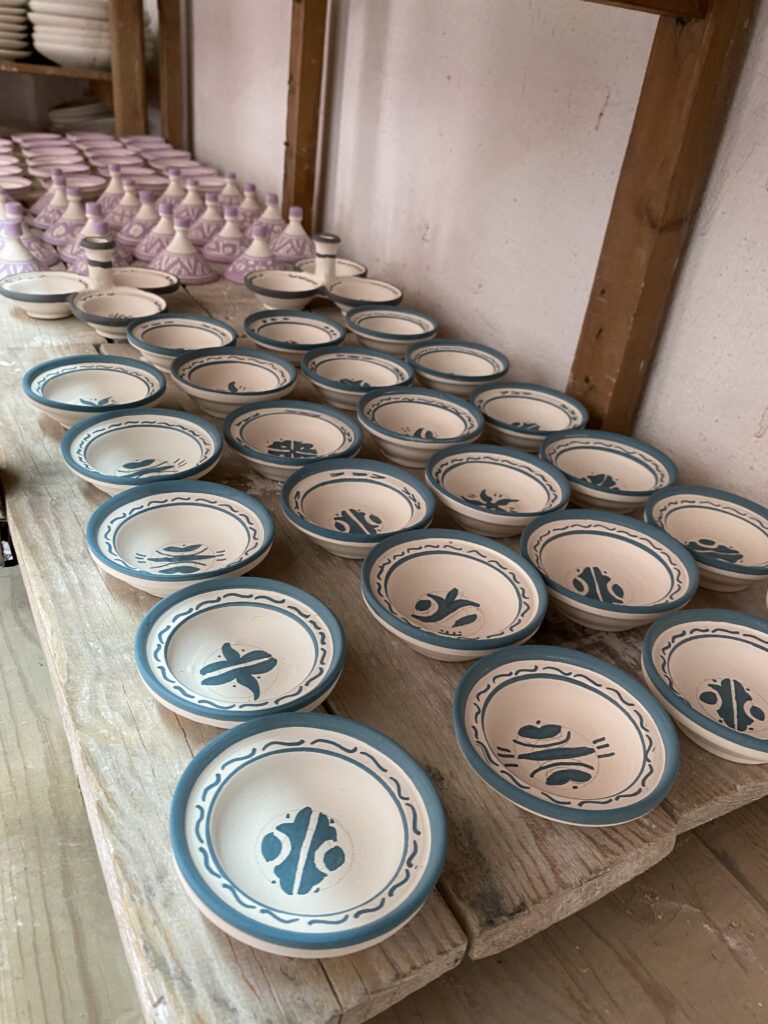

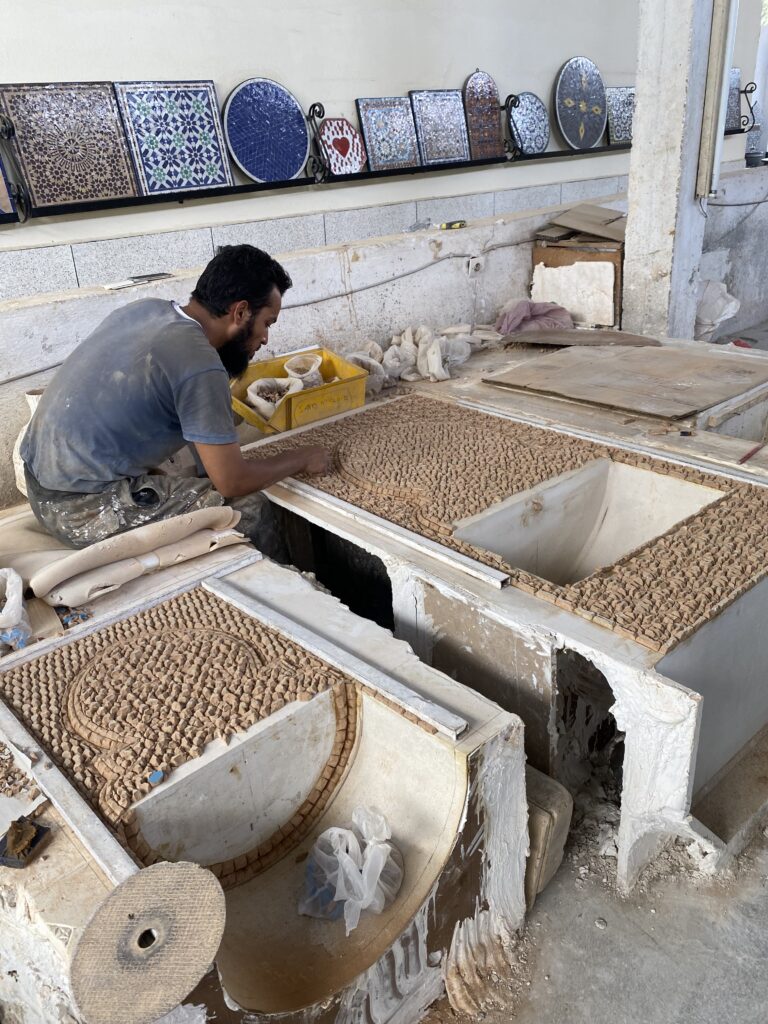
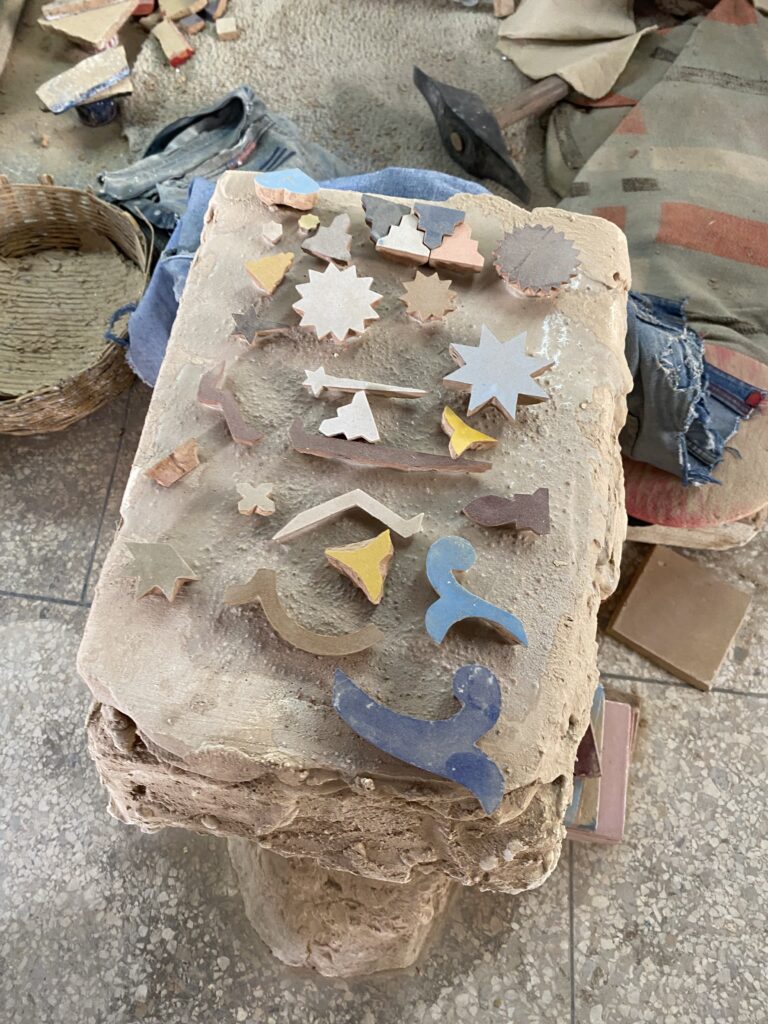
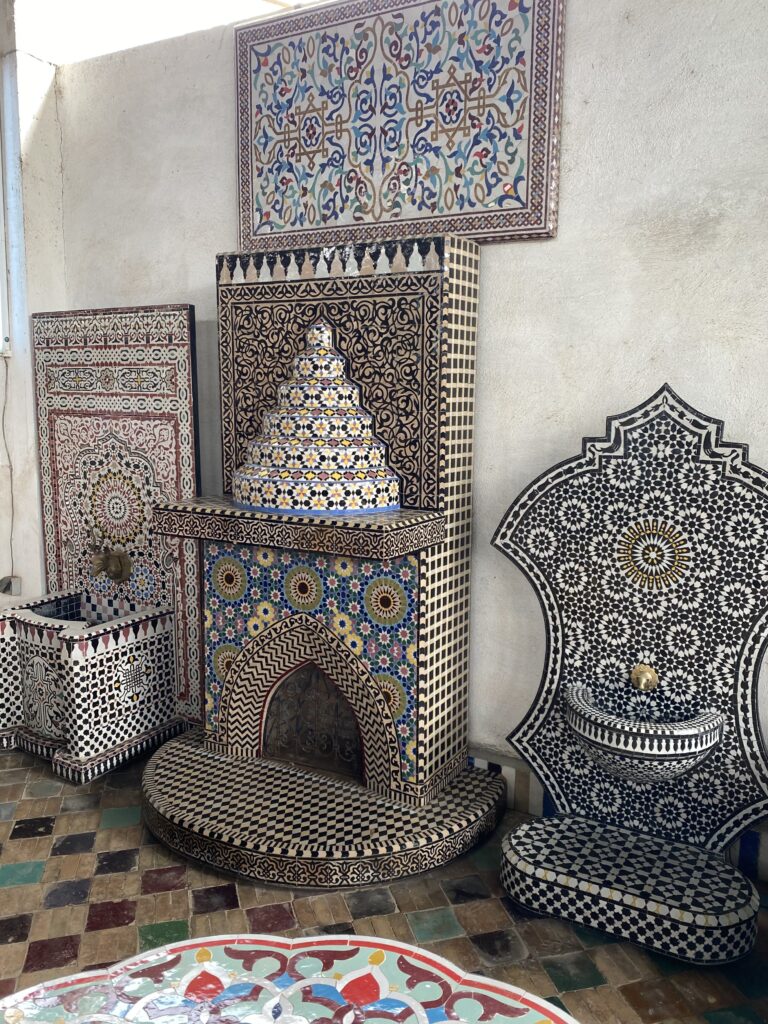
Fes medina
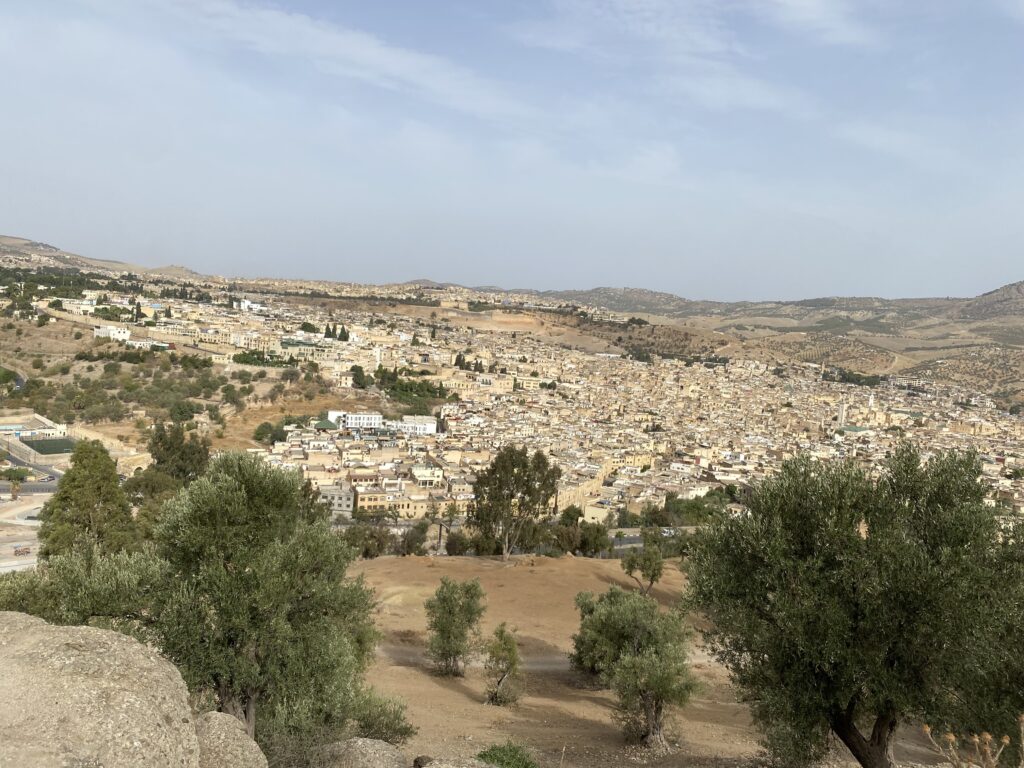
Then we moved on to the medina, founded in the 9th century and currently an UNESCO World Heritage site. This was another time when I was thankful for a tour guide. It would be very easy to get lost among the thousands of streets within the medina walls.
A few of the highlights are below.
Al-Attarine Madrasa
Al-Attarine Madrasa was built in the 14th century during the Marinid Dynasty. It’s craftmanship still stands. The madrasa includes a courtyard surrounded by students’ quarters on the second and third floors.
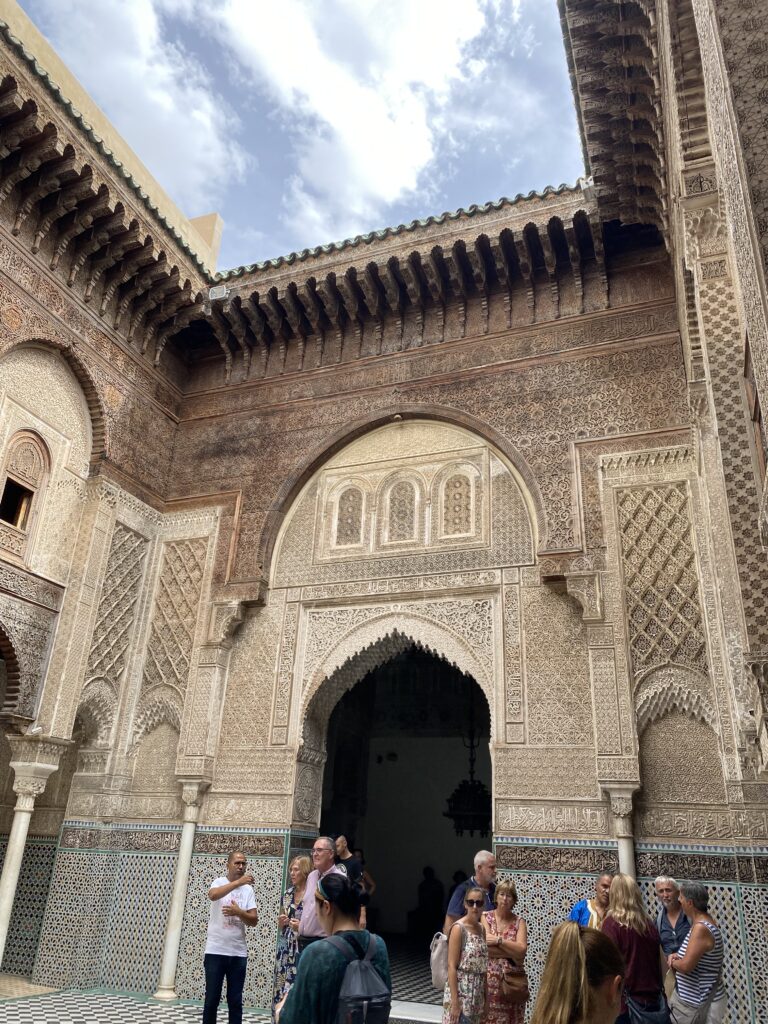

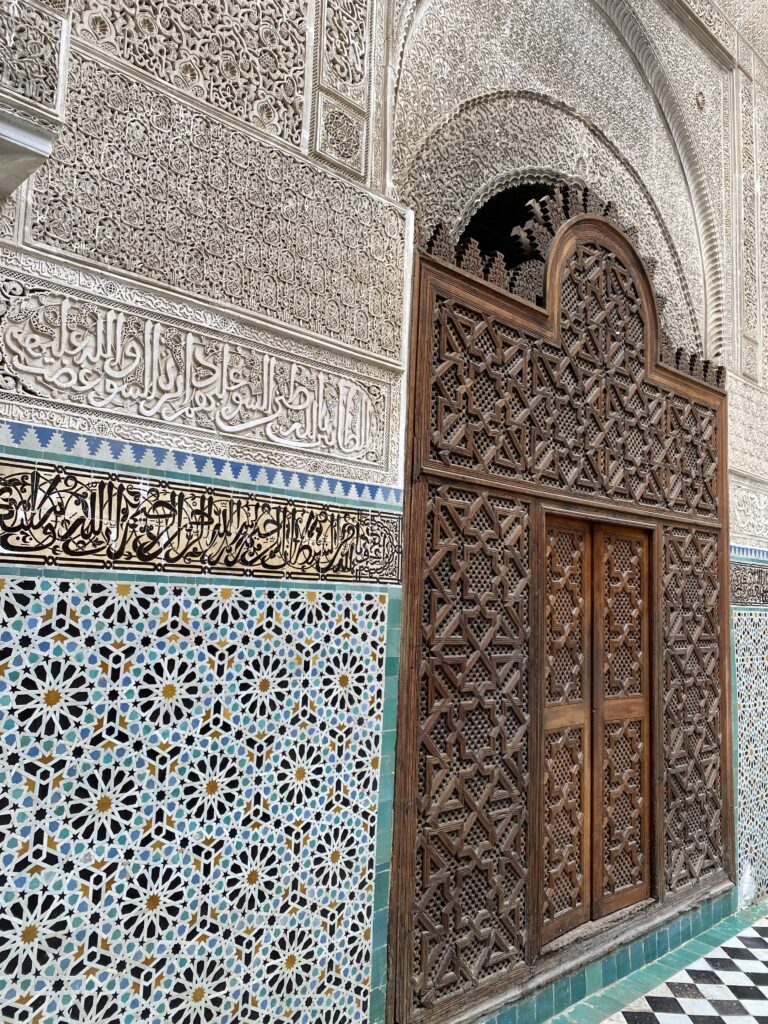
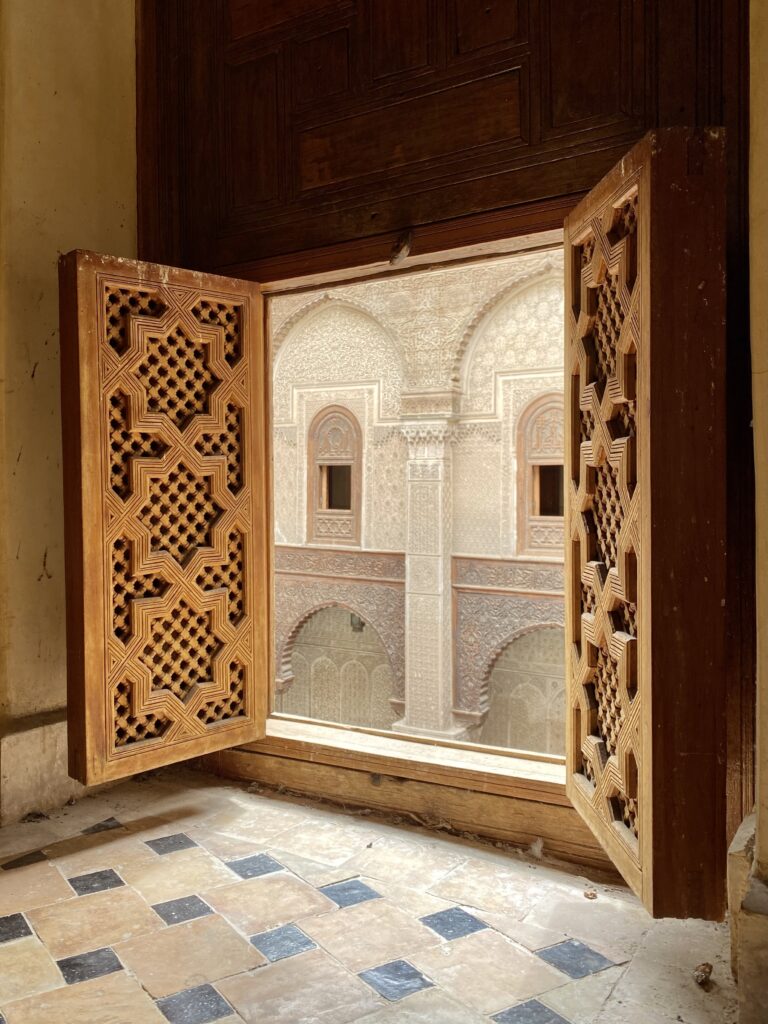
Chouara Tannery
There are four historic tanneries in Fes, Chouara being the largest one and oldest in the world (over 1000 years old). When you enter, you’ll receive some mint leaves to provide a little relief from the strong smell. In the outdoor space behind the building, you can see workers dying skins in honeycombed earth pits. Inside, you can browse multiple floors of high-quality leather goods – jackets, ottomans, bags of all types, shoes and slippers.
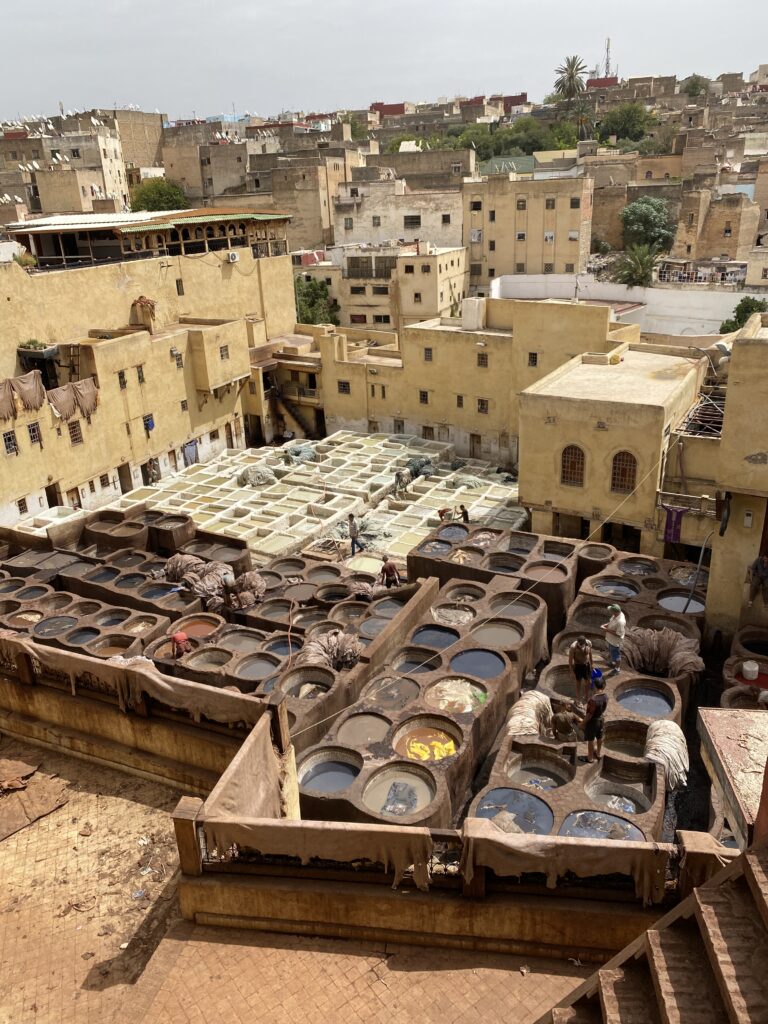
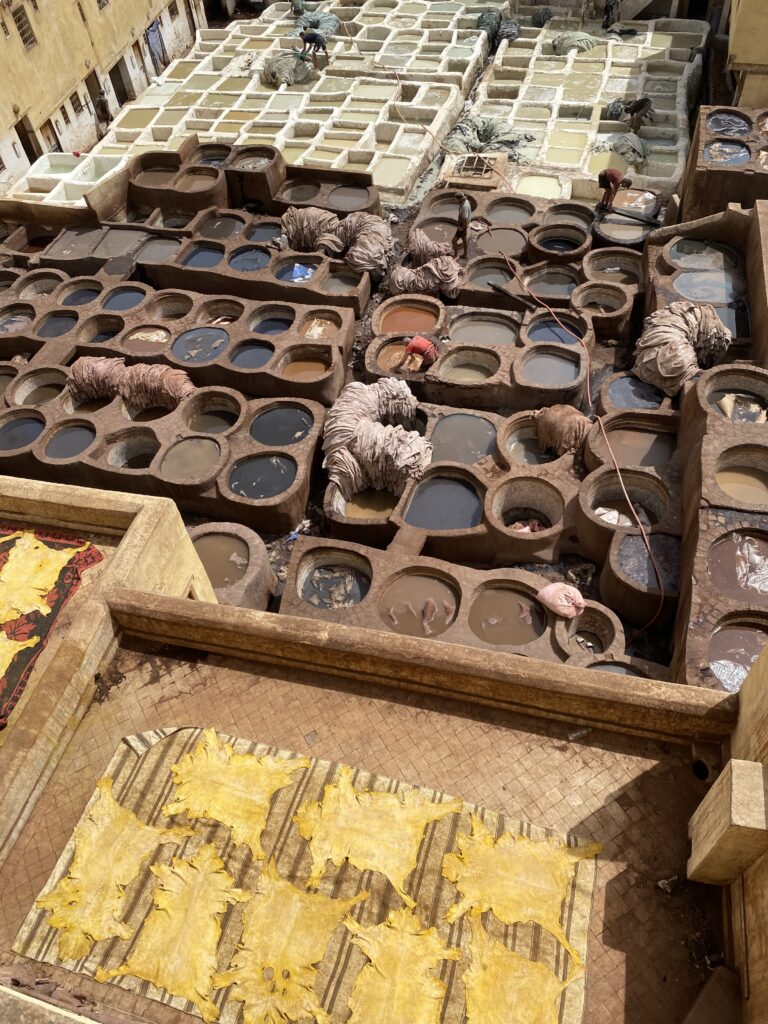
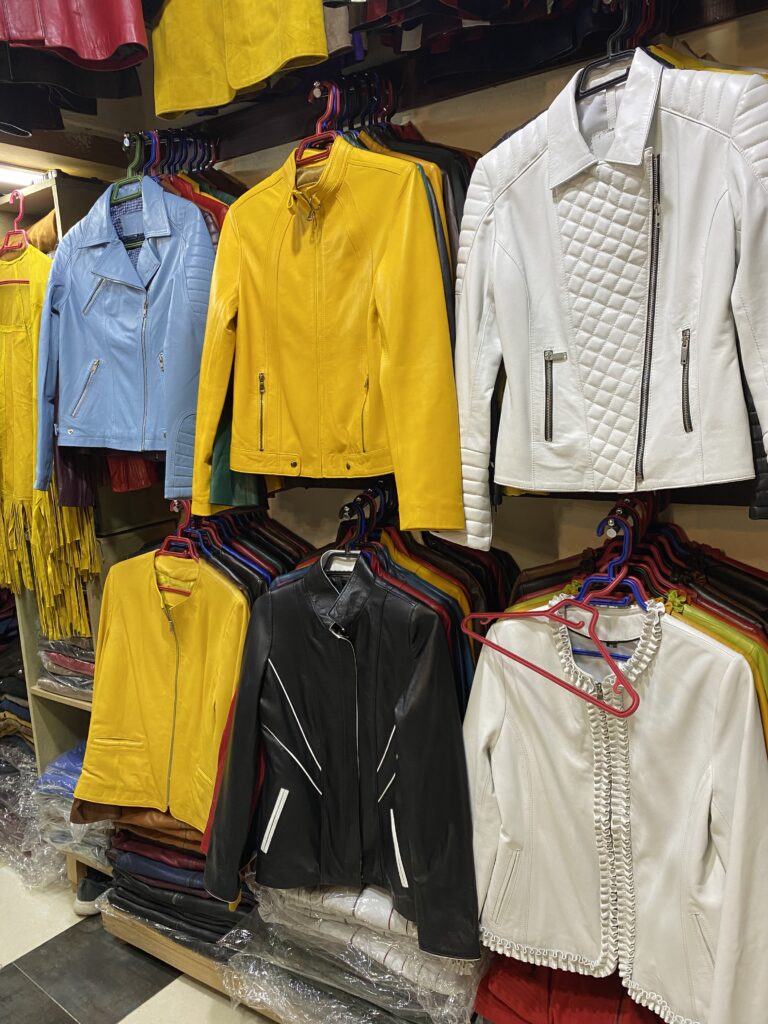
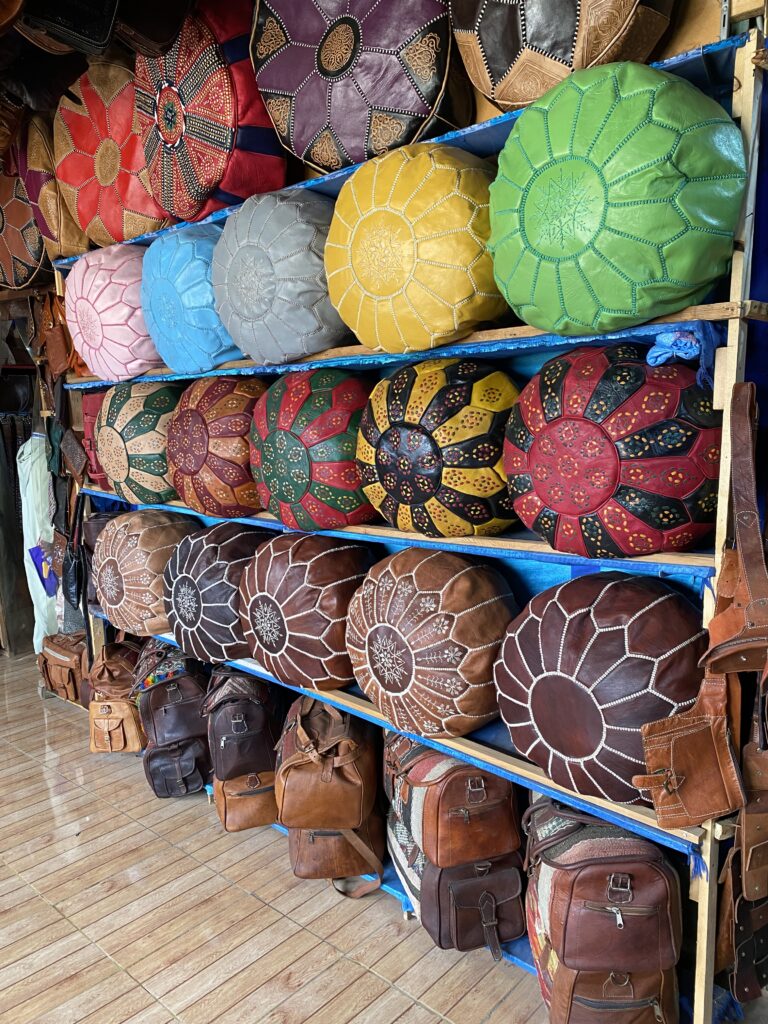
Souks
There are a variety of different souks, all specializing in a specific craft or product.
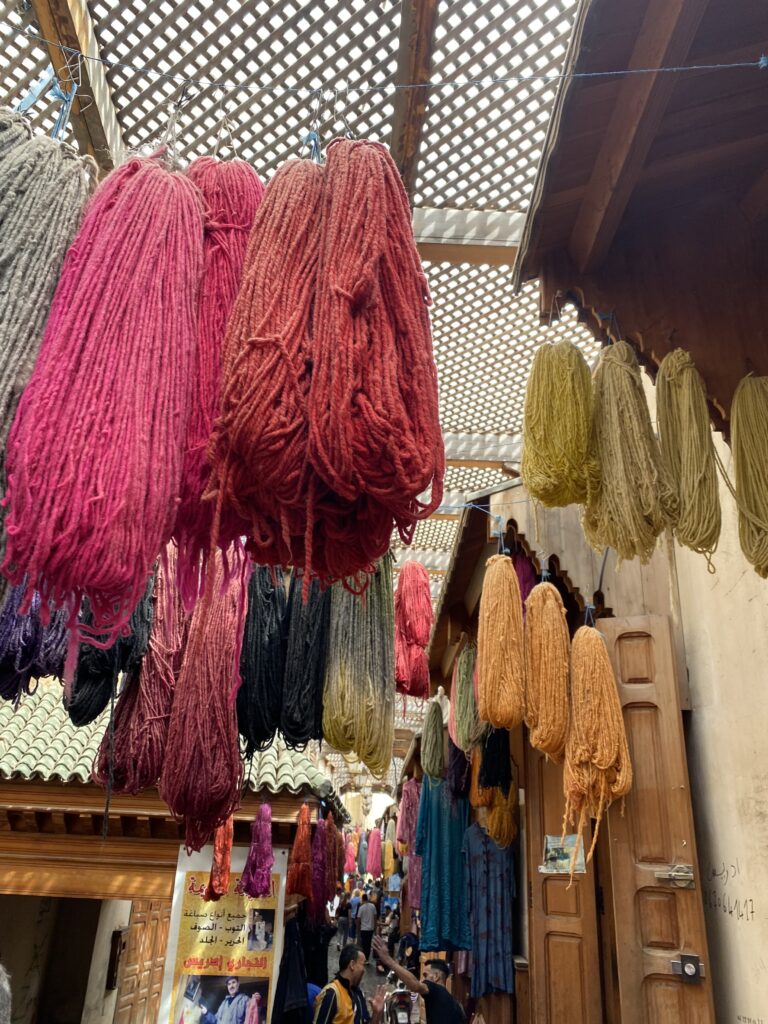
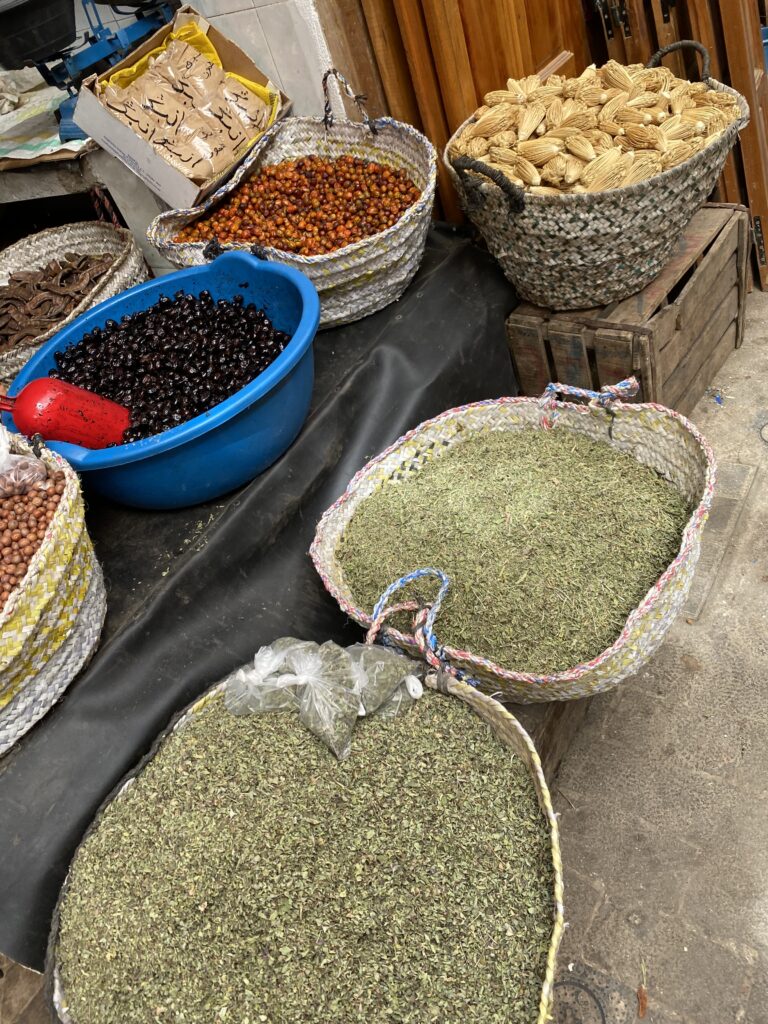
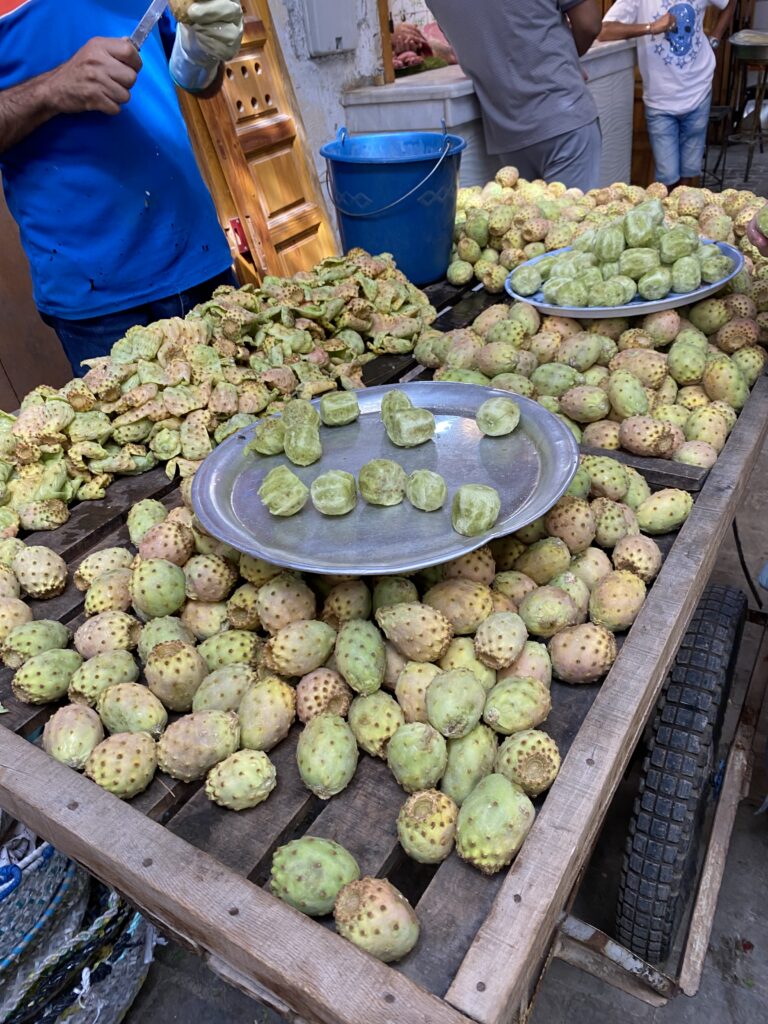
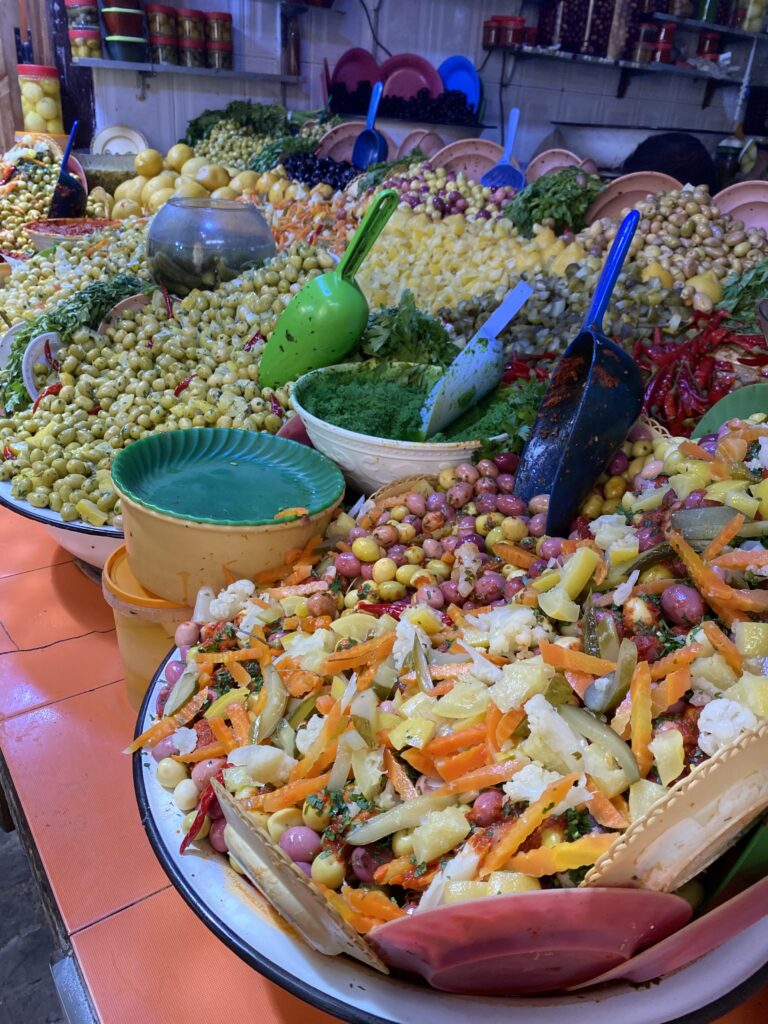

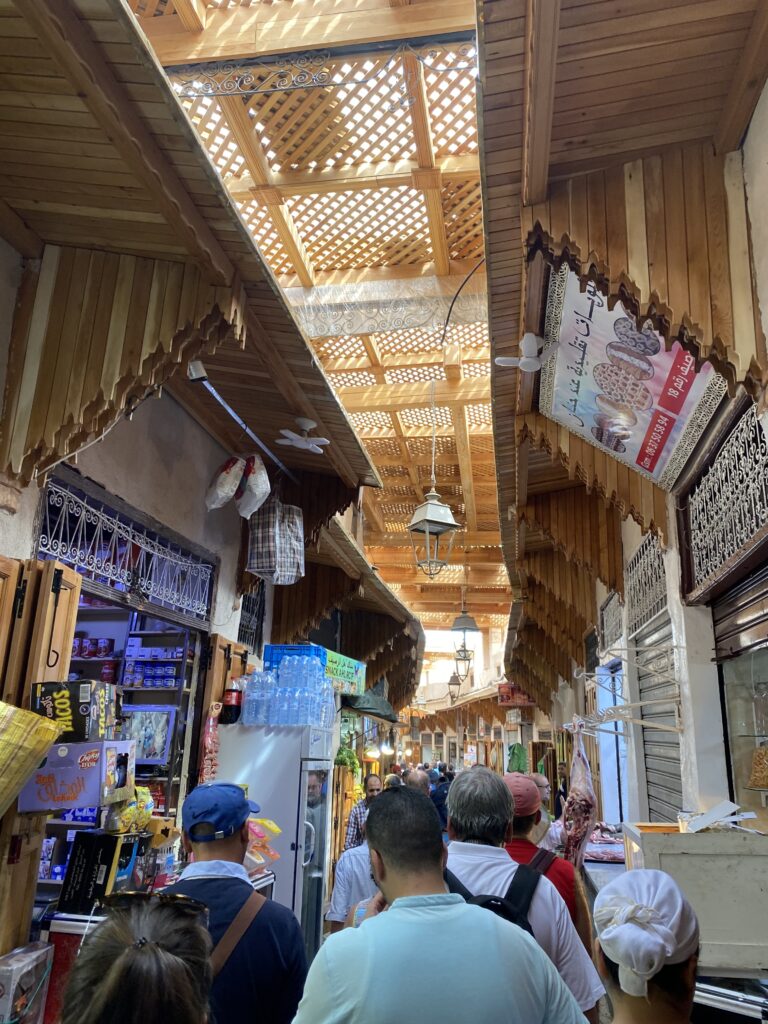

Stop #7: Chefchaouen, the Blue City
After staying overnight in Fes, we drove 3.5 hours on a private bus to our next stop, Chefchaouen. Chefchaouen is called the Blue City for obvious reasons – many of its buildings are painted a baby blue color. I think it’s a must for anyone debating where to travel in Morocco. It was the most relaxing stop on our tour, so it’s a nice addition to the itinerary.
We first stopped at a lookout where you get a great view of the entire town.
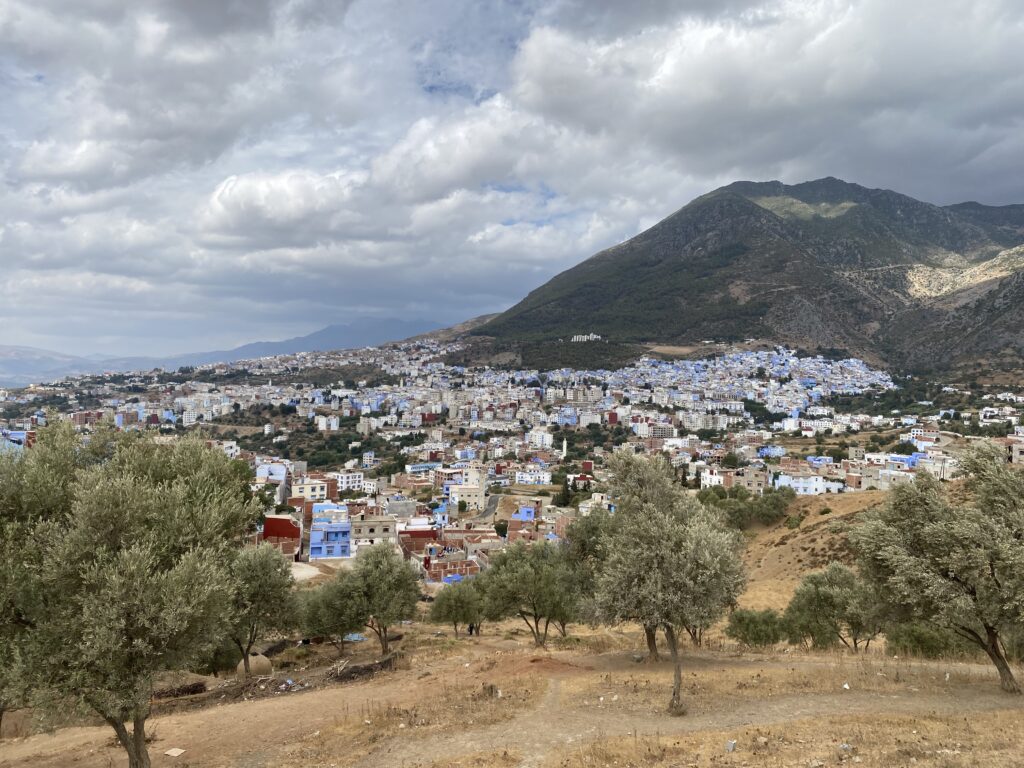
Our hotel was amazing. It was made up of several buildings with stairs and walkways in between them, plus a pool and lounge area. It had great views of the town below, clean and beautifully decorated Moroccan rooms.
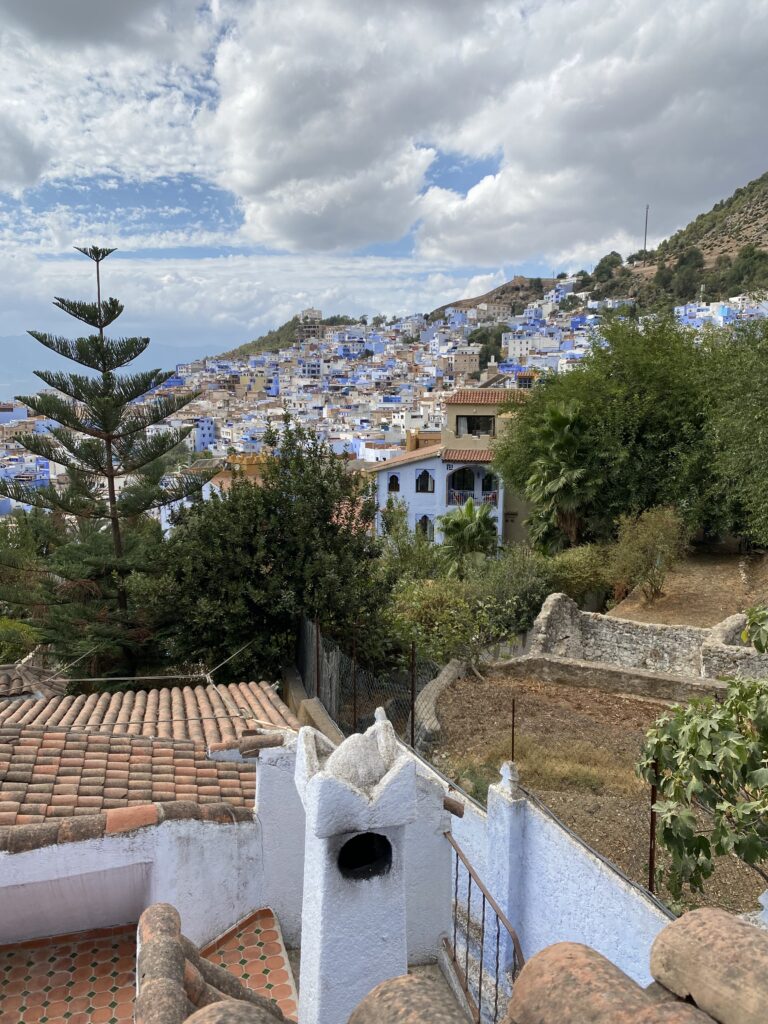
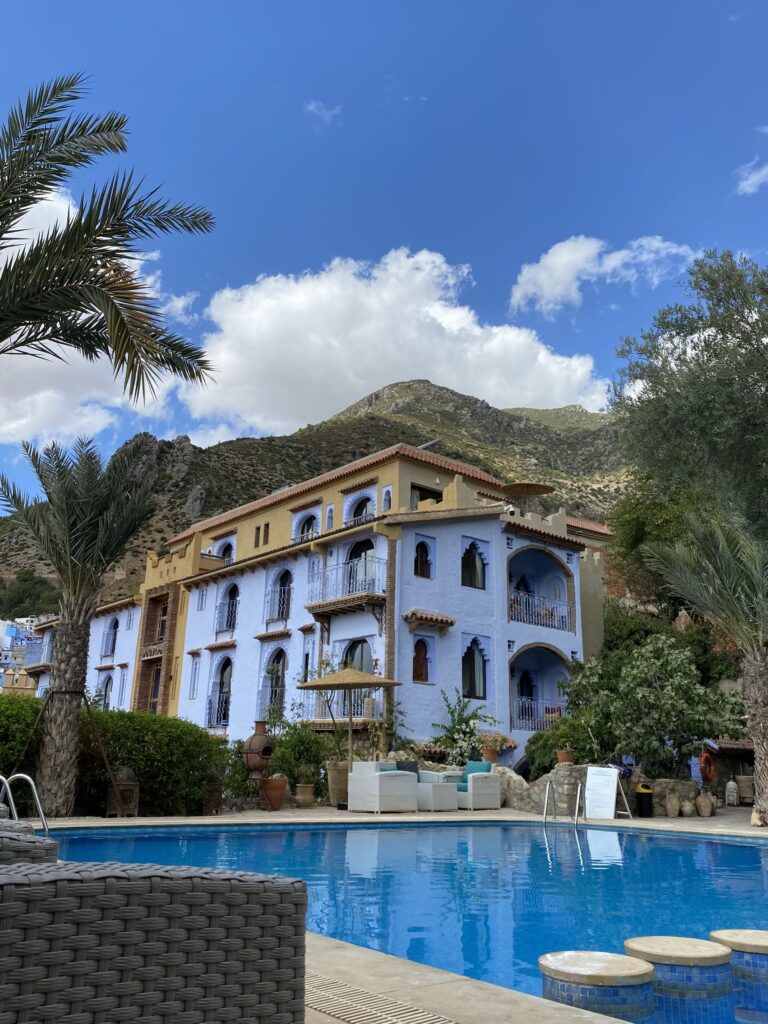
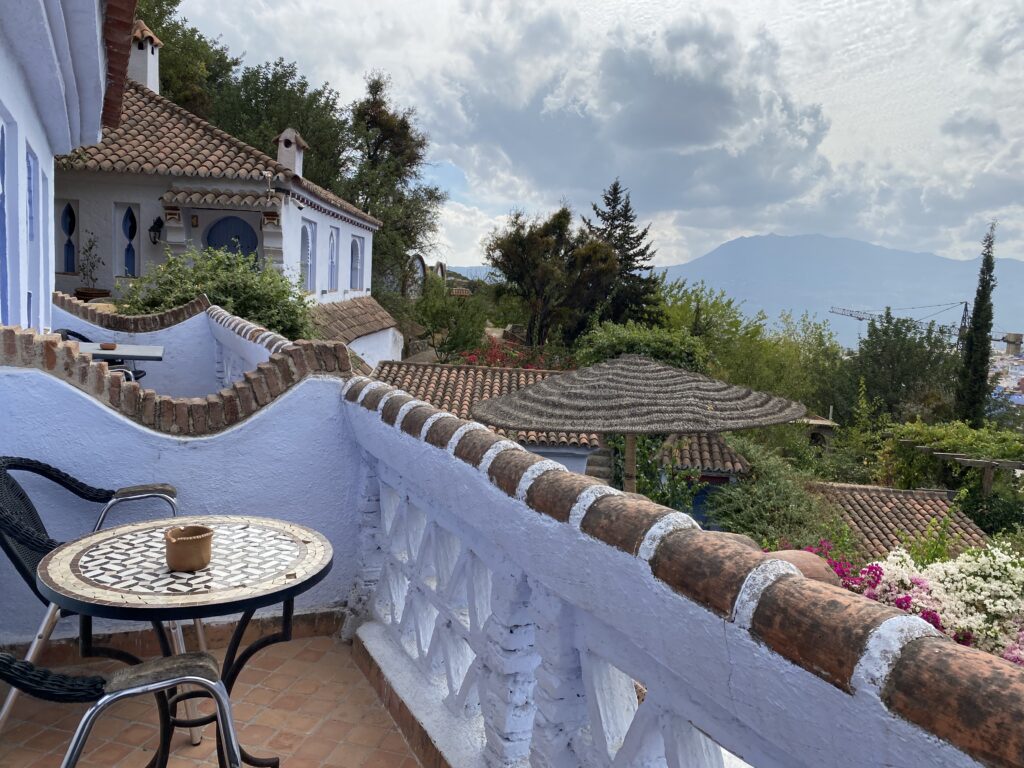
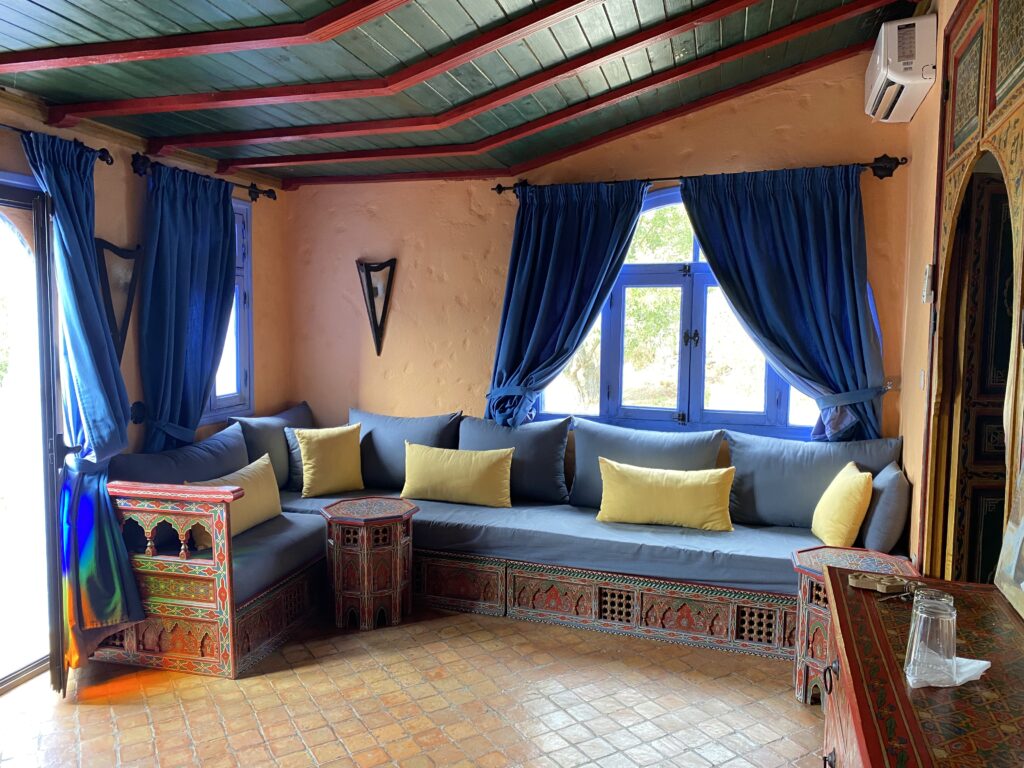
The main activity in Chefchaouen is just to explore the medina. You can also hike in the surrounding mountains. I opted to skip the hike, walk through the medina a bit, and then relax, since I had just gotten sick at this point in the trip. The Chefchaouen medina is smaller, so even if you do get lost you’ll find your way back relatively easily. The locals are very kind and helpful.


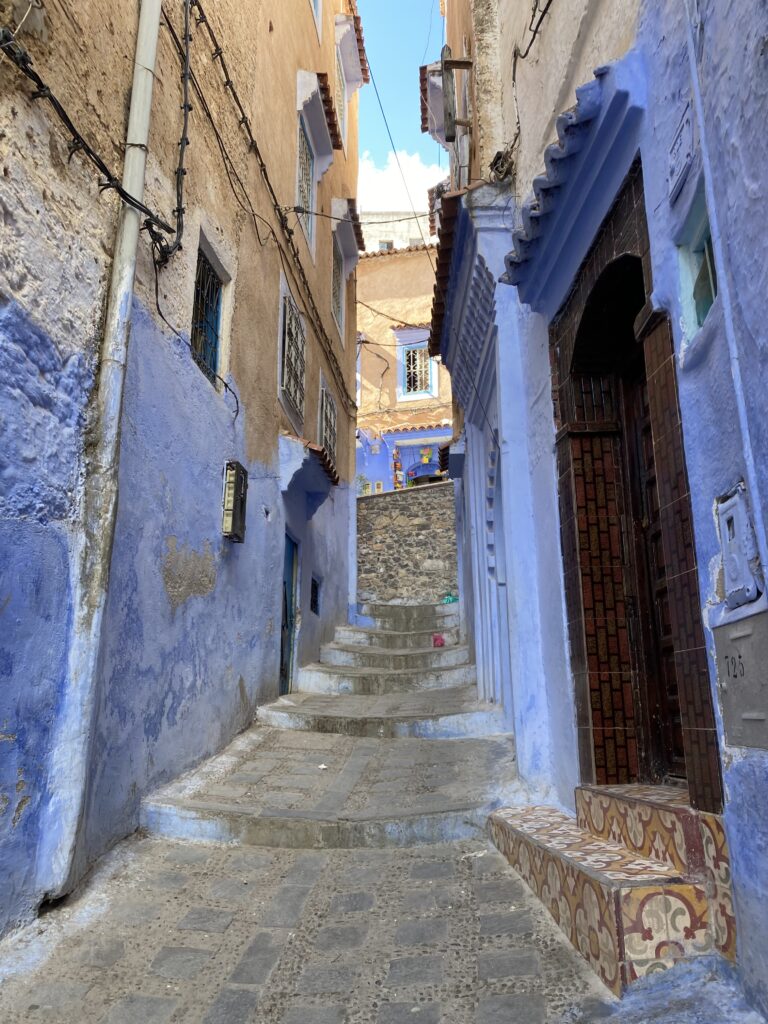
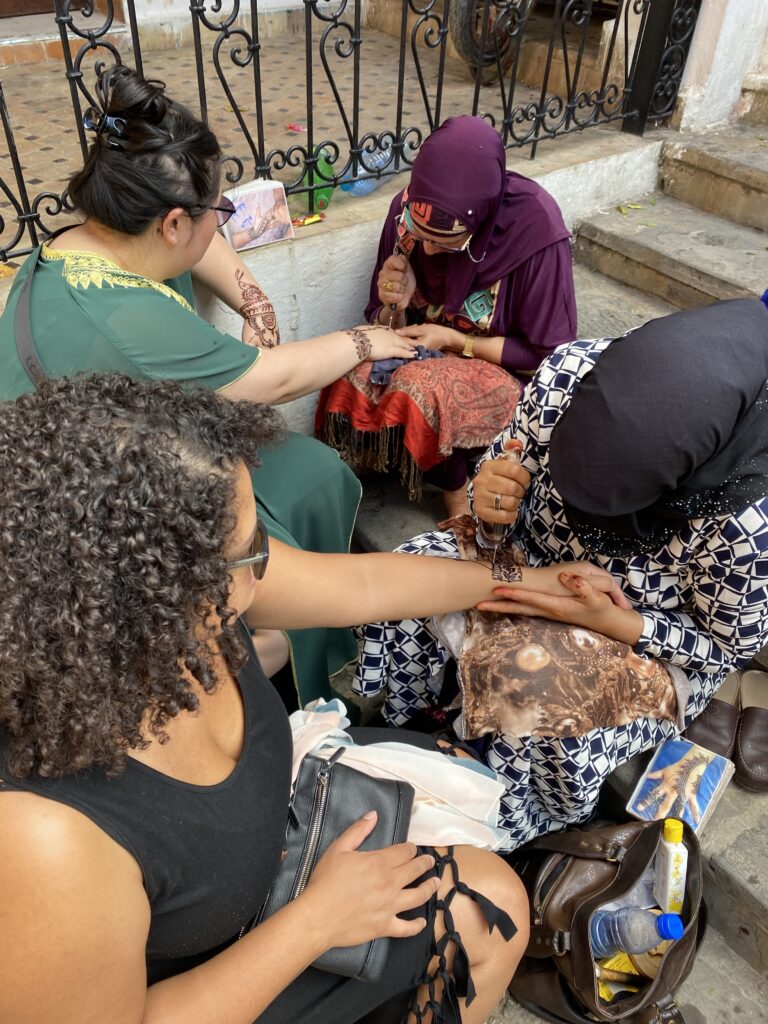

Stop #8: Tangier, the Modern Port City
I found Tangier to be a unique city. It probably had something to do with the fact that it’s on the water, giving it a more open feel. The city is the northern tip of the country, just across the Strait of Gibraltar from the Iberian peninsula.
The first place we visited in Tangier was Cape Spartel. From this overlook, you can see where the Atlantic Ocean meets the Mediterranean Sea and on a clear day, you can see Spain. Achakkar Beach is also closeby, where camels are standing by to give rides.
From there, we headed to Hercules Caves. According to Greek myth, Hercules rested in these caves before doing his eleventh labor. The opening that seems to be in the shape of the African continent when viewed from the sea, called “The Map of Africa,” was believed to be made by the ancient Phoenicians. There are wall markings inside the caves, also believed to be made by the Phoenicians.
We continued the day with a walk through downtown Tangier and then the waterfront, which is a good place for sunset and then getting food and drinks.



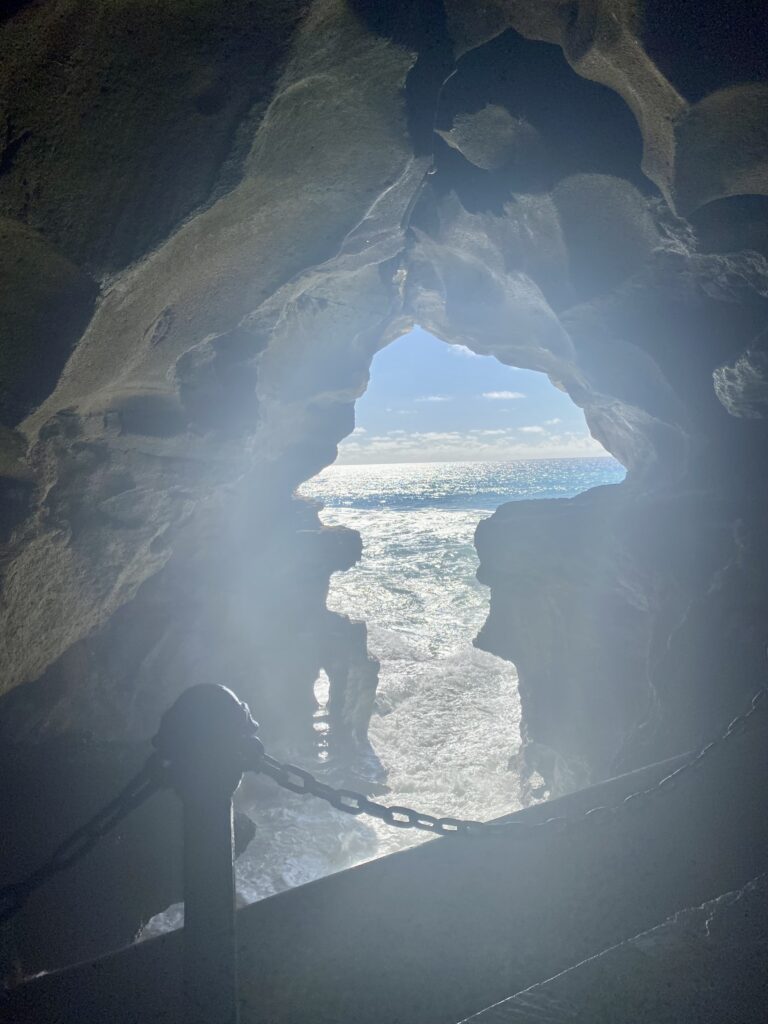
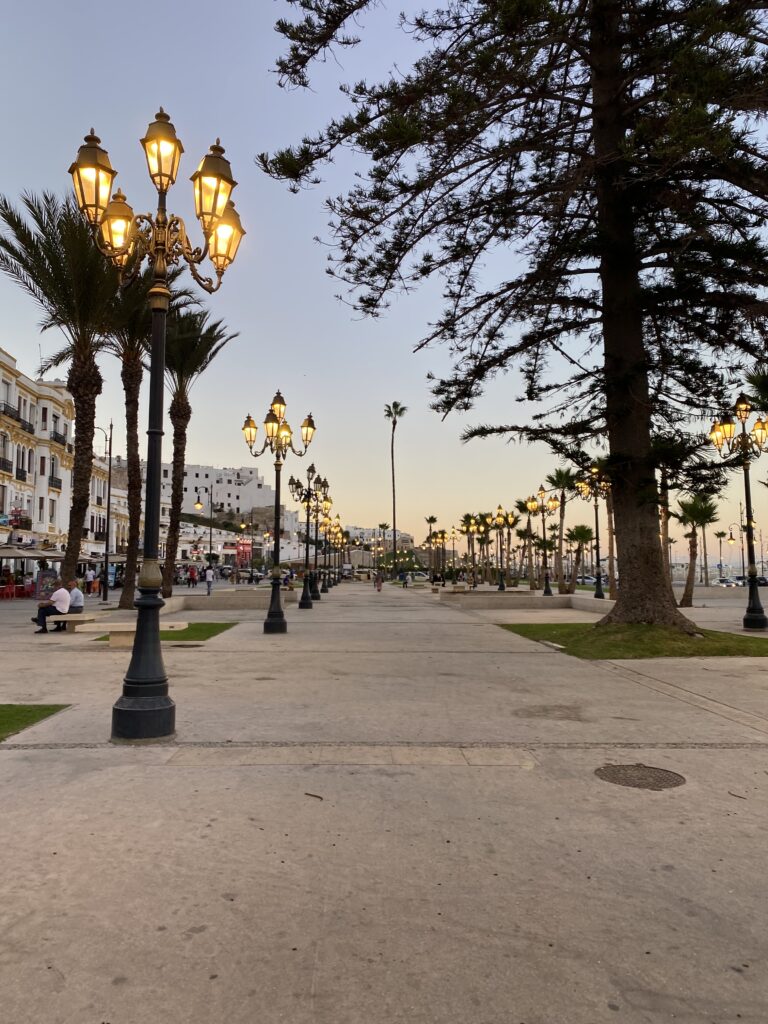
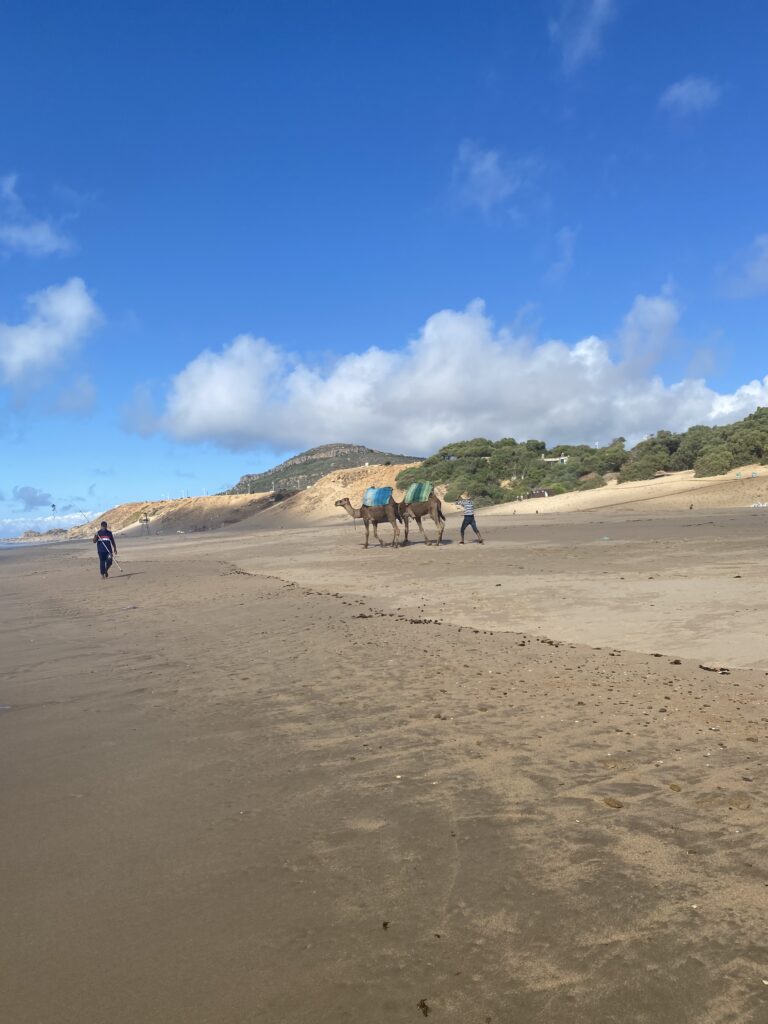
Stop #9: Marrakesh, the Red City
The final stop of our trip was one of the most popular Moroccan tourist cities, Marrakesh. It’s called the Red City for the earthy red color of many of its buildings. There are so many things to do here, so I’ll get right into the ones I covered.
Medina and Jamâa El-Fna Square
You can spend forever just wandering the Marrakesh medina. I visited a lot of medinas during my trip, but this was my favorite. There was a mix of smaller, more traditional shops and modern stores and boutiques. But the modern shops still fit in perfectly with the historic medina.
One appointment I made sure to secure was a hammam visit. I got a black soap body scrub and argan oil hair treatment at Heritage Spa, located inside the medina.

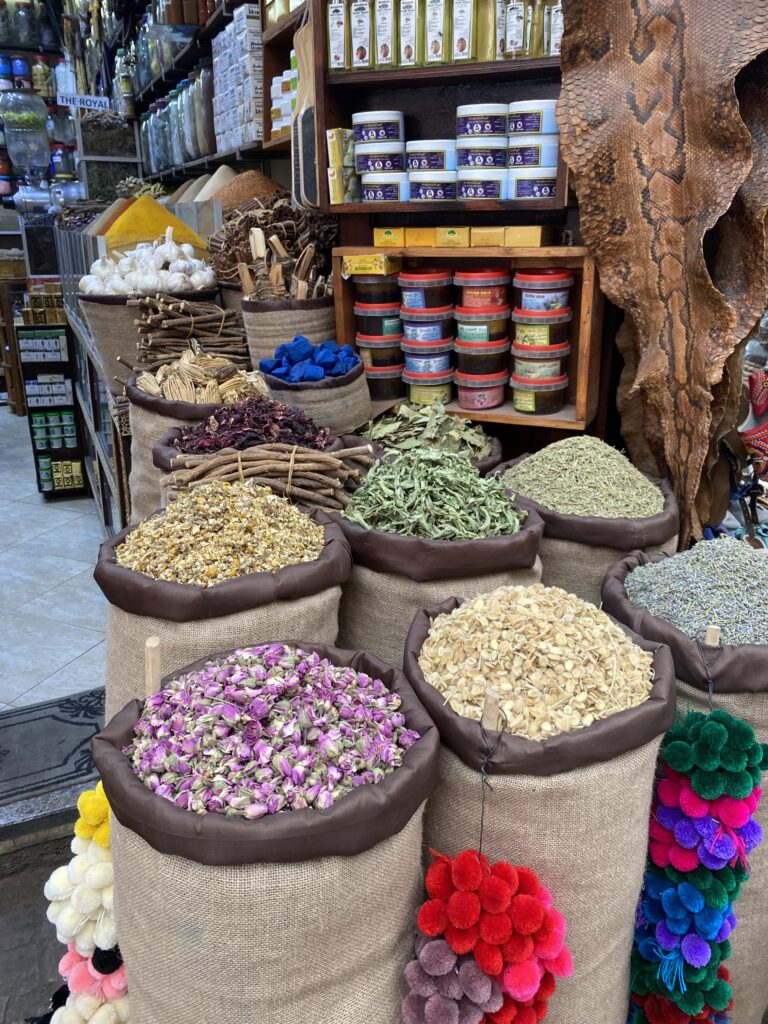
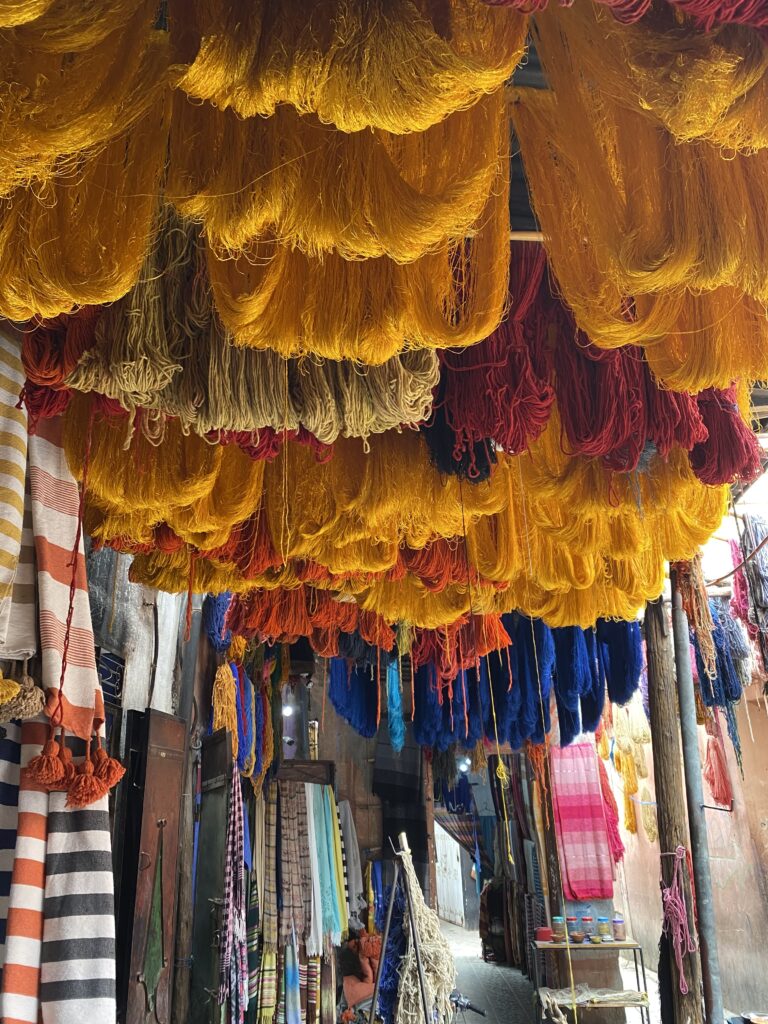
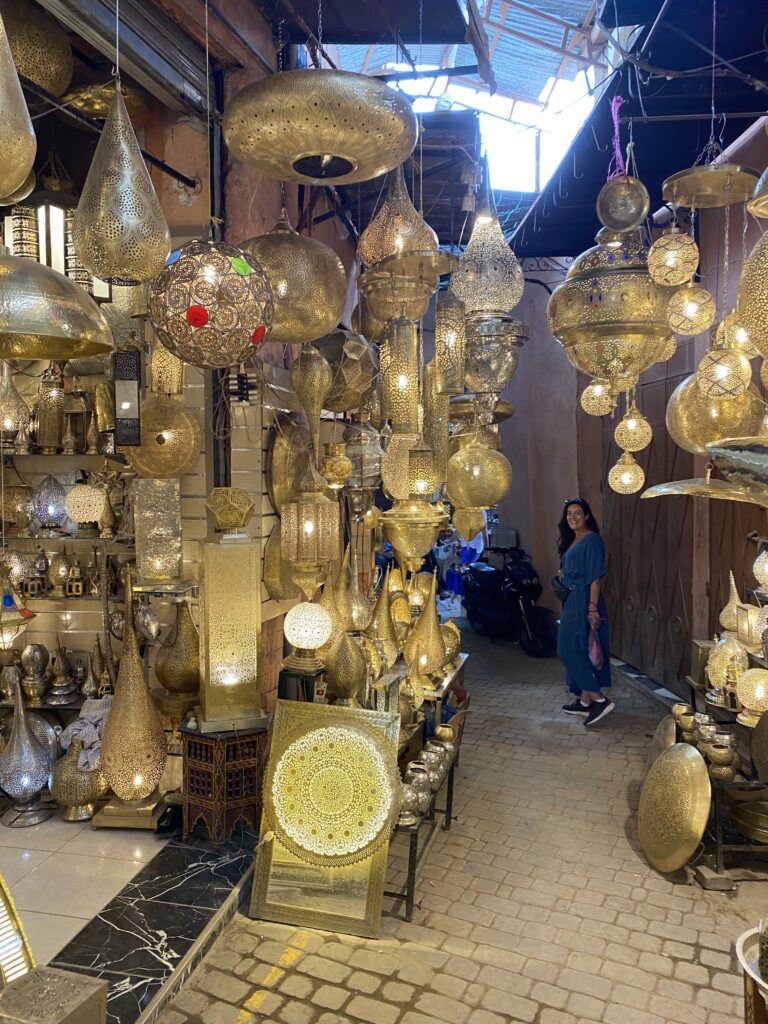
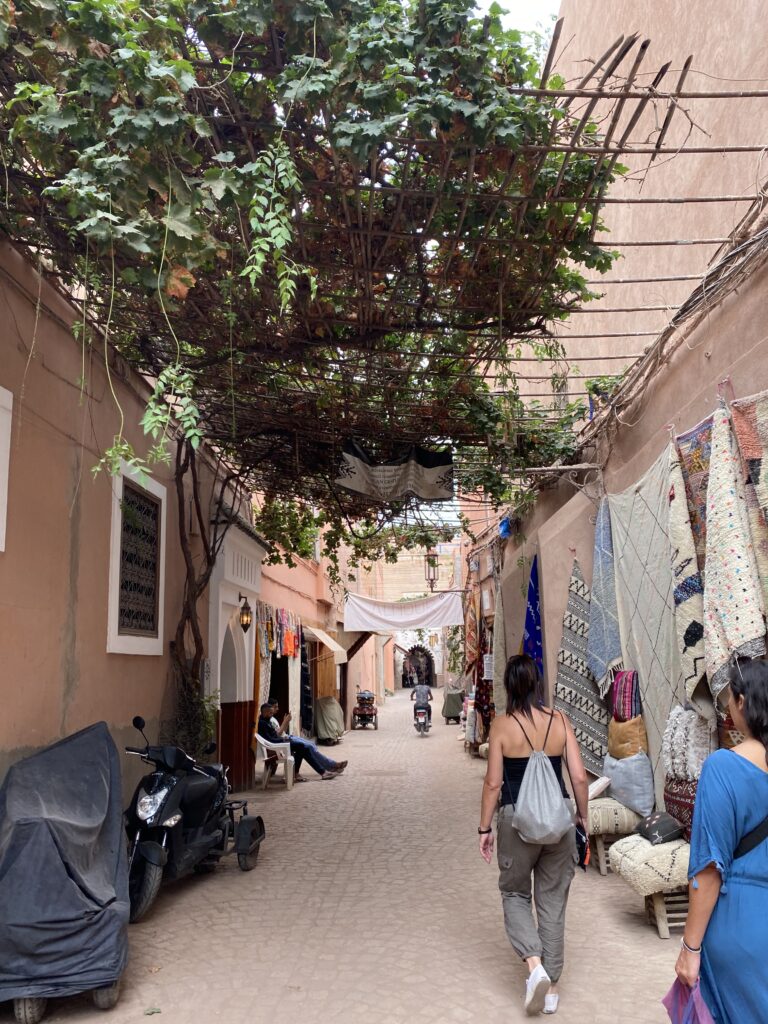
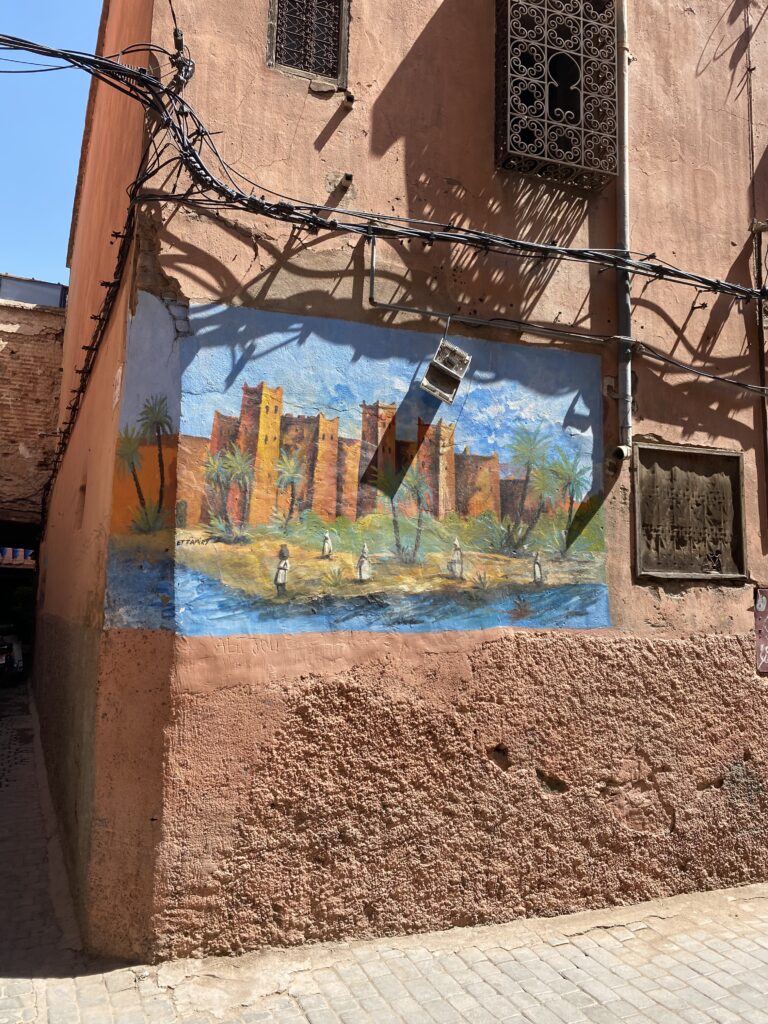
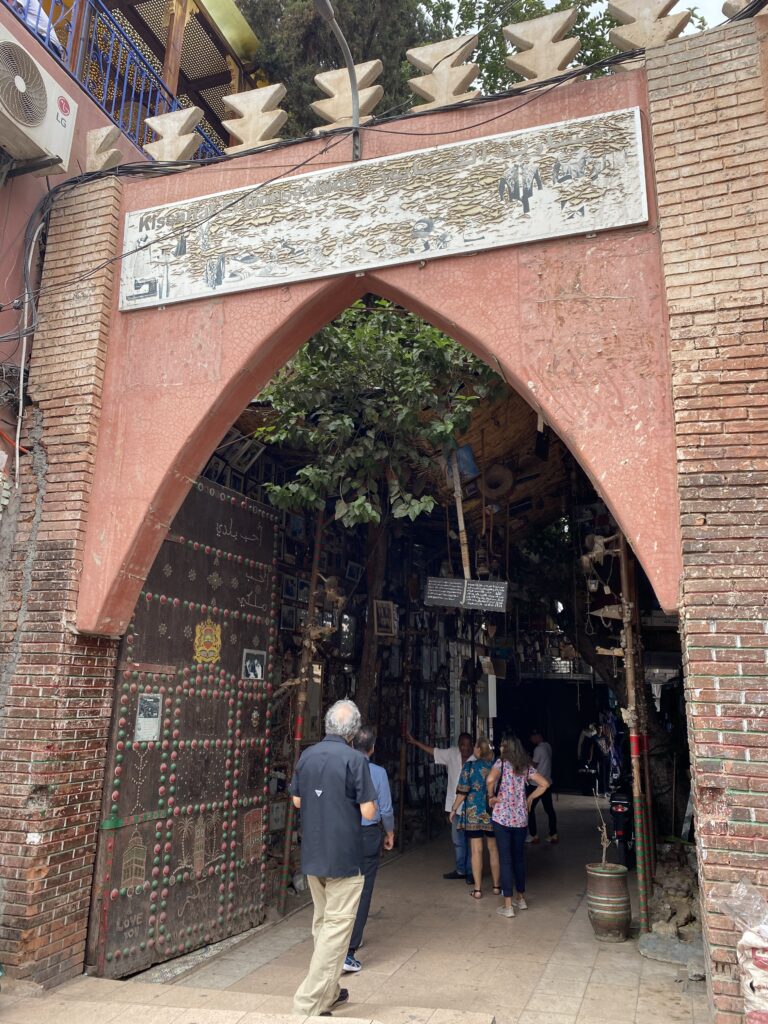
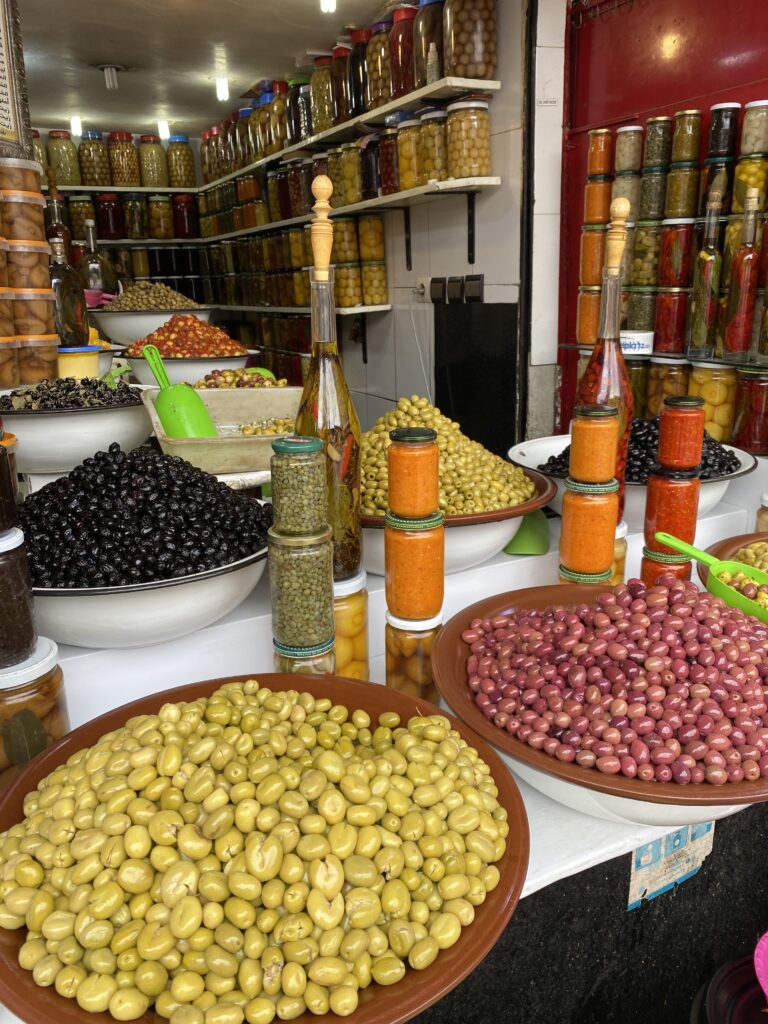
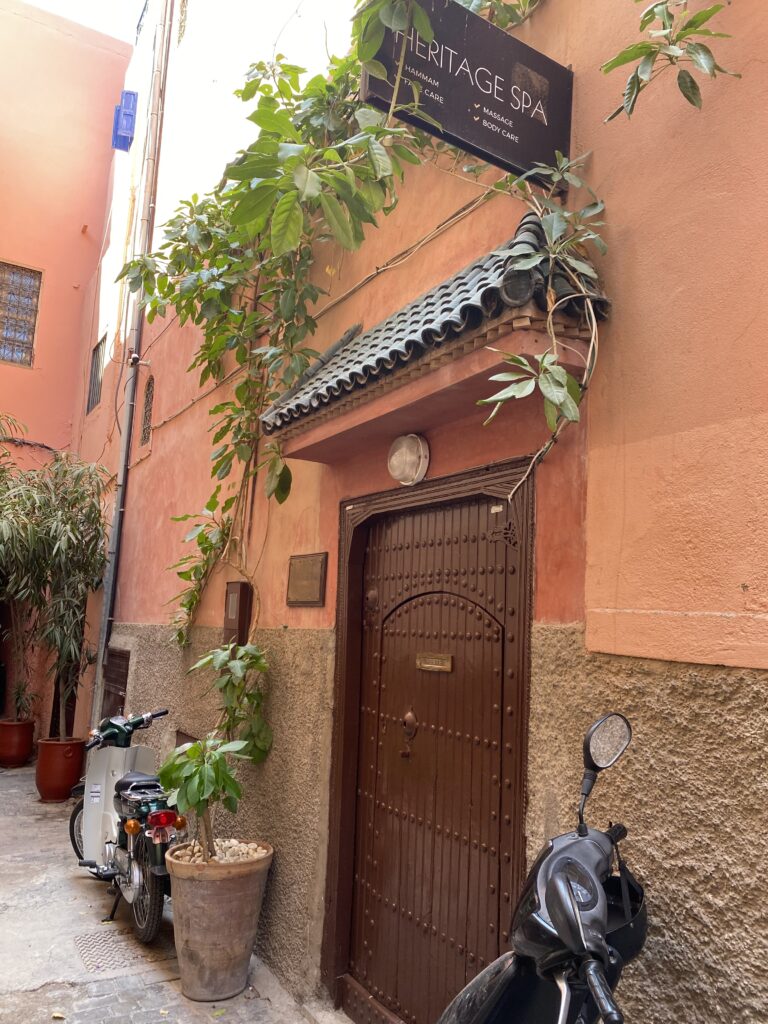
Jamâa El-Fna Square is a large open space on the edge of the medina that’s not just for food and craft vendors to set up, but also for entertainment like snake charmers and monkey trainers. The evening is when the square really comes alive with visitors and locals. People come by to get a whole dinner for very cheap and enjoy the entertainment at the same time.
Bahia Palace
19th century Bahia Palace includes a courtyard garden and plenty of tile mosaics, stucco, and carved wood details. It’s thought to be the first building in North Africa to use stained glass.
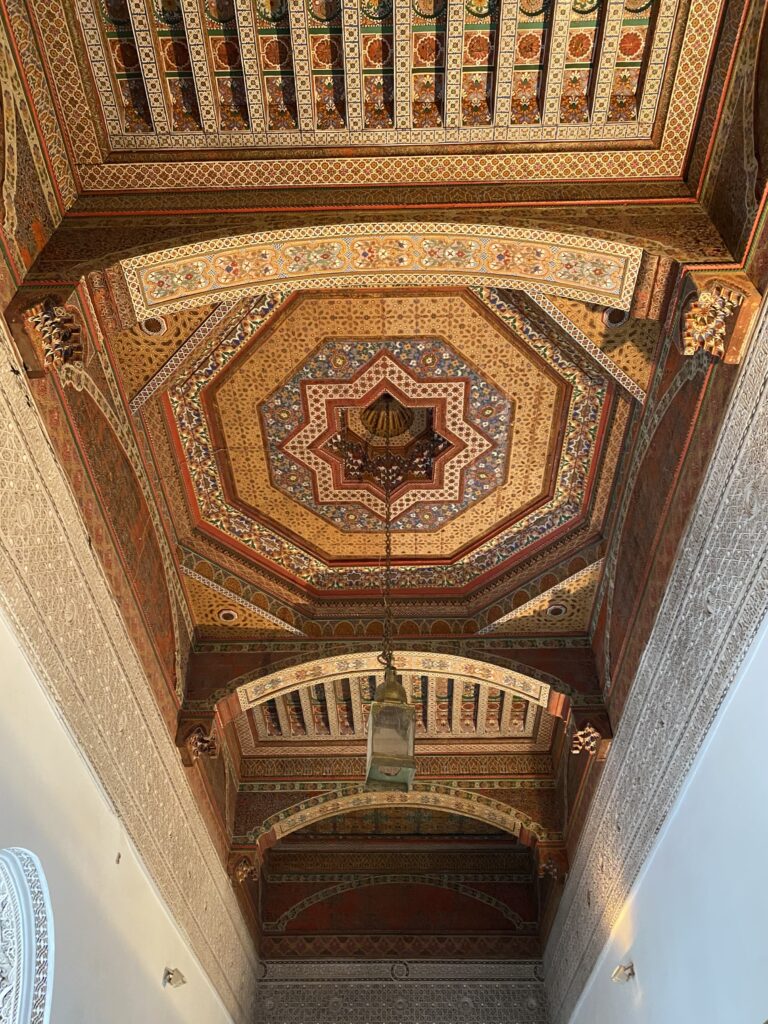


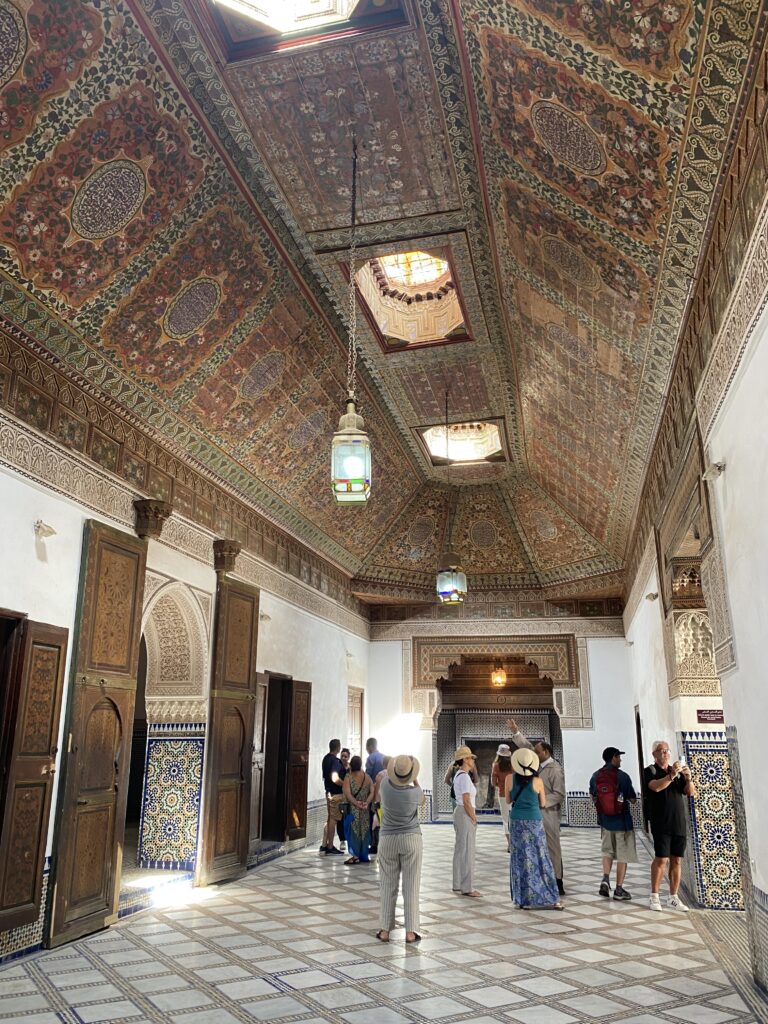

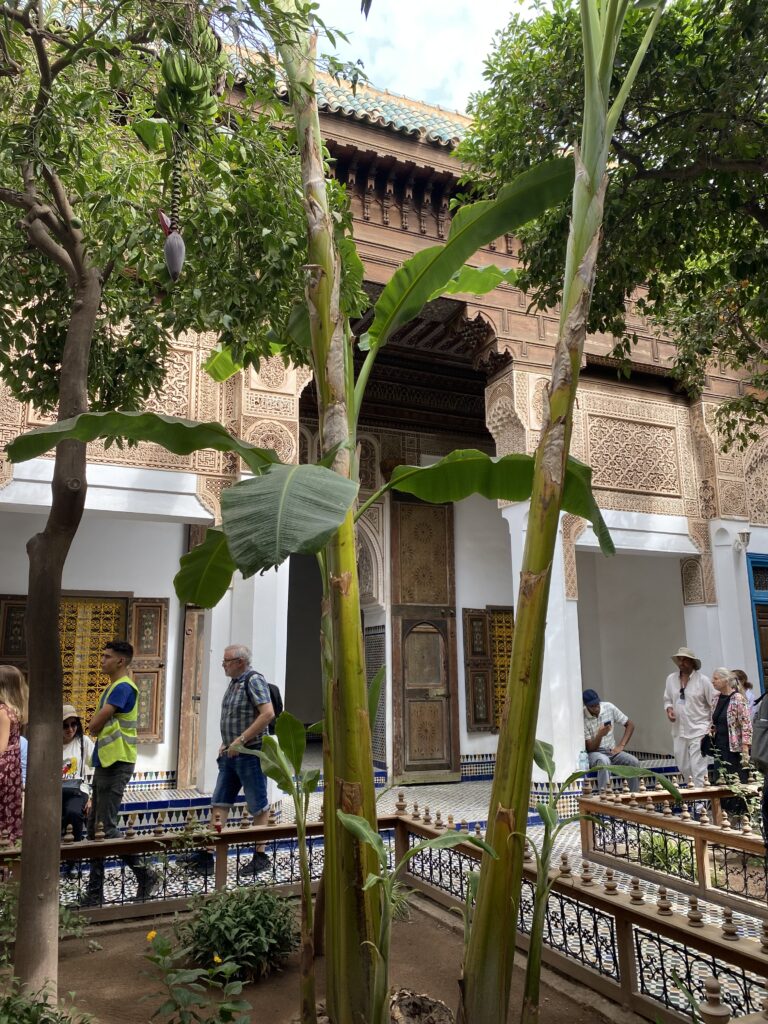

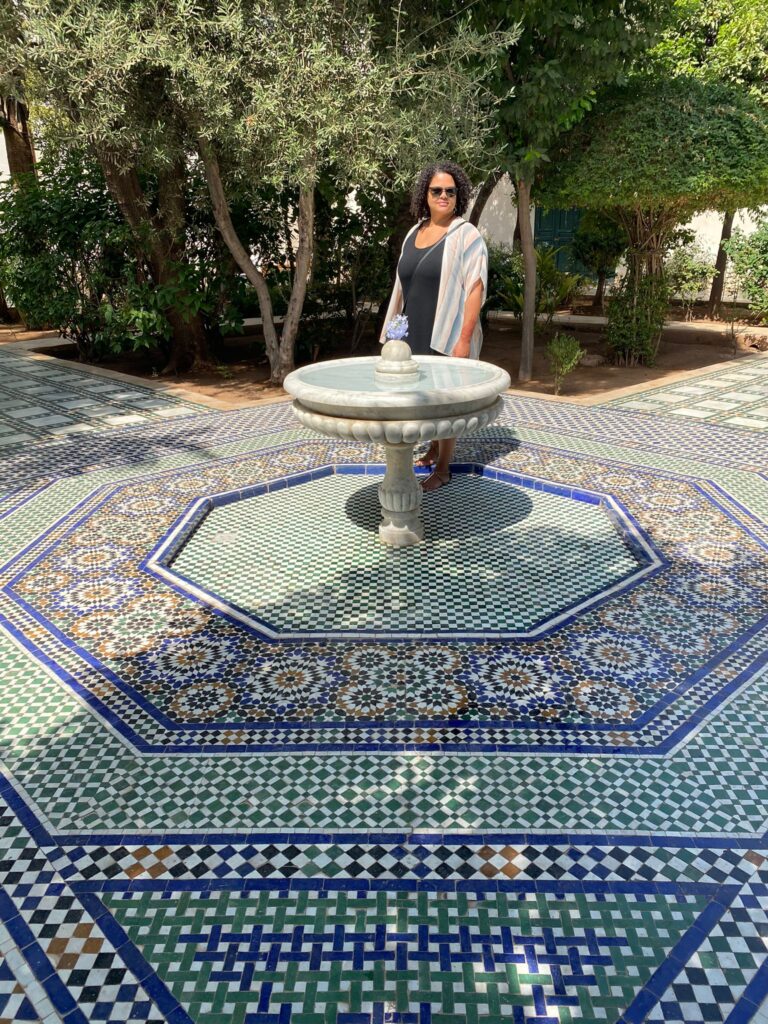
Unfortunately, I didn’t have time to see everything I wanted to. Here are some other popular sites:
- El Badîi Palace. Remains of a 16th century palace.
- Koutoubia Mosque: This mosque is over 800 years old and the tallest structure in the city. You can’t miss it!
- Le Jardin Secret: This riad/museum dates back 400 years and was recently renovated.
- Majorelle Gardens/Jardin Majorelle: Botanical and landscape garden created by French artist Jacques Majorelle in 1923 and restored by fashion designer Yves Saint Laurent in the 1980’s. Also includes the Berber Art Museum, a cafe, and boutique.
- Yves Saint Laurent Museum: Museum featuring the work of French fashion designer Yves Saint Laurent.
I hope this was helpful for anyone not sure of where to travel in Morocco. I’m glad I was able to go beyond Marrakesh and experience more of the country and culture. Still, I’d love to return and visit more of the country – I recommend anyone else to do the same.
Make sure to follow me on Instagram to see more Morocco content and subscribe to my email list for future travel blogs and tips. Leave a comment below with any question you have about where to travel in Morocco or how to prepare for your trip!
If you liked this, check these out:
Get Acquainted with Venice, Italy: Its History, Culture & Tourism
Marbella, Spain: A Gem of the Costa del Sol
Beyond Porto: A Complete Guide to Northern Portugal
Pin it for later:

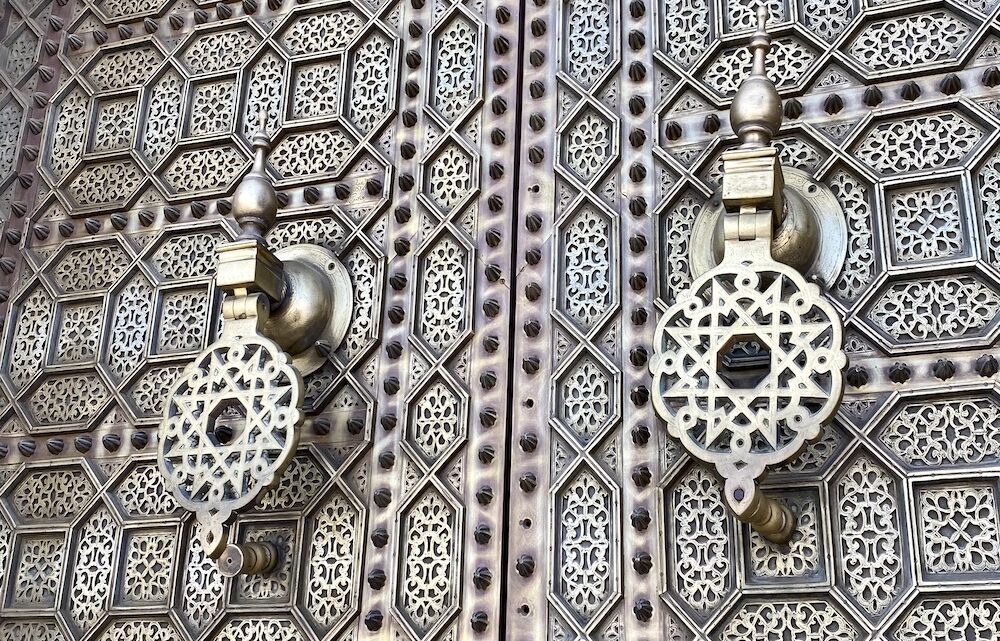
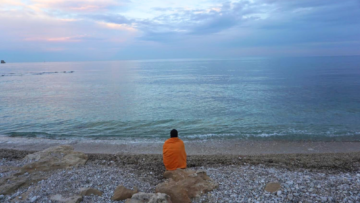
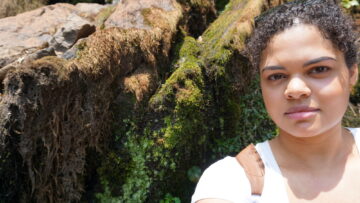
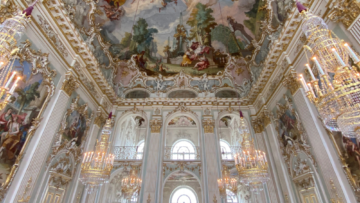

4 Comments
thanks for the great article, keep up the good work
I thoroughly enjoyed our tour together. I had been to North Africa in the 80s and loved every minute of it. Always a dream to go back, especially to Marrakesh. The almond trees in bloom were magnificent. The food delightful the people charming.
The architecture, artwork, and craftsmanship are so amazing. So many things you were able to experience. It is inspiring.
Yes, I could have used another week or two to see more.